
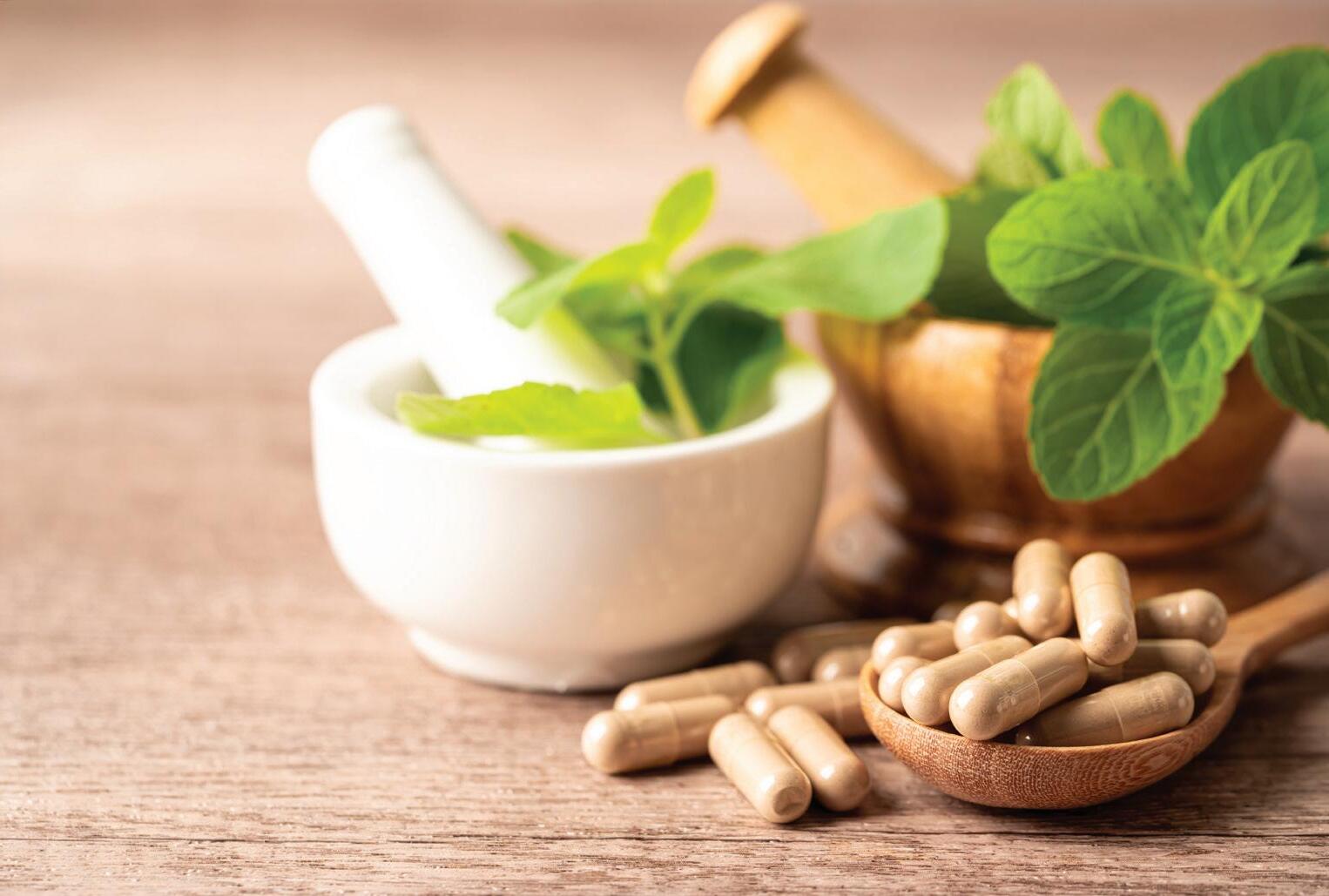
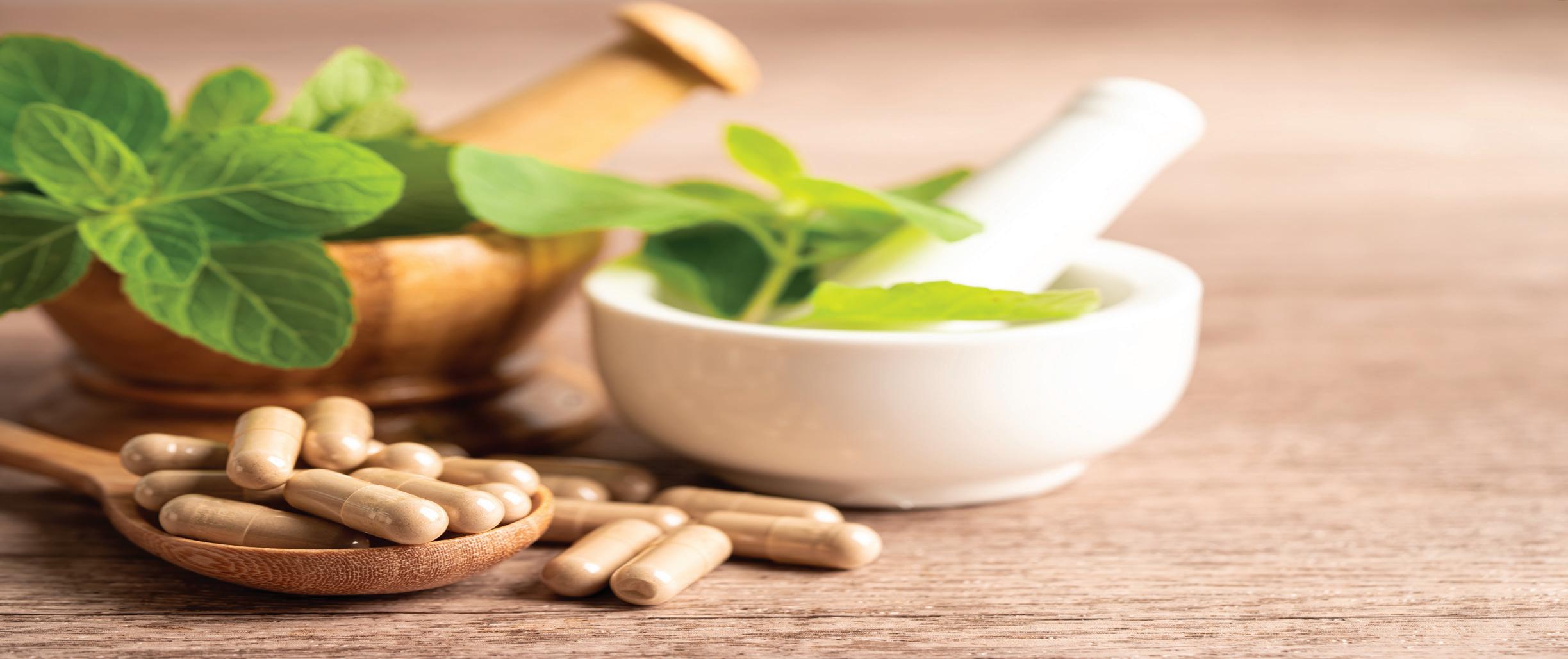


PLANT-BASED MEAT Sensory Profiles and Affordability
Brief Revolution of SENSORY EVALUATION

Preservation of Reference CULTURES
Take Control of Your MICROBIOLOGICAL Quality Control
The Risks of FOOD PATHOGENS in Fresh Meat Products
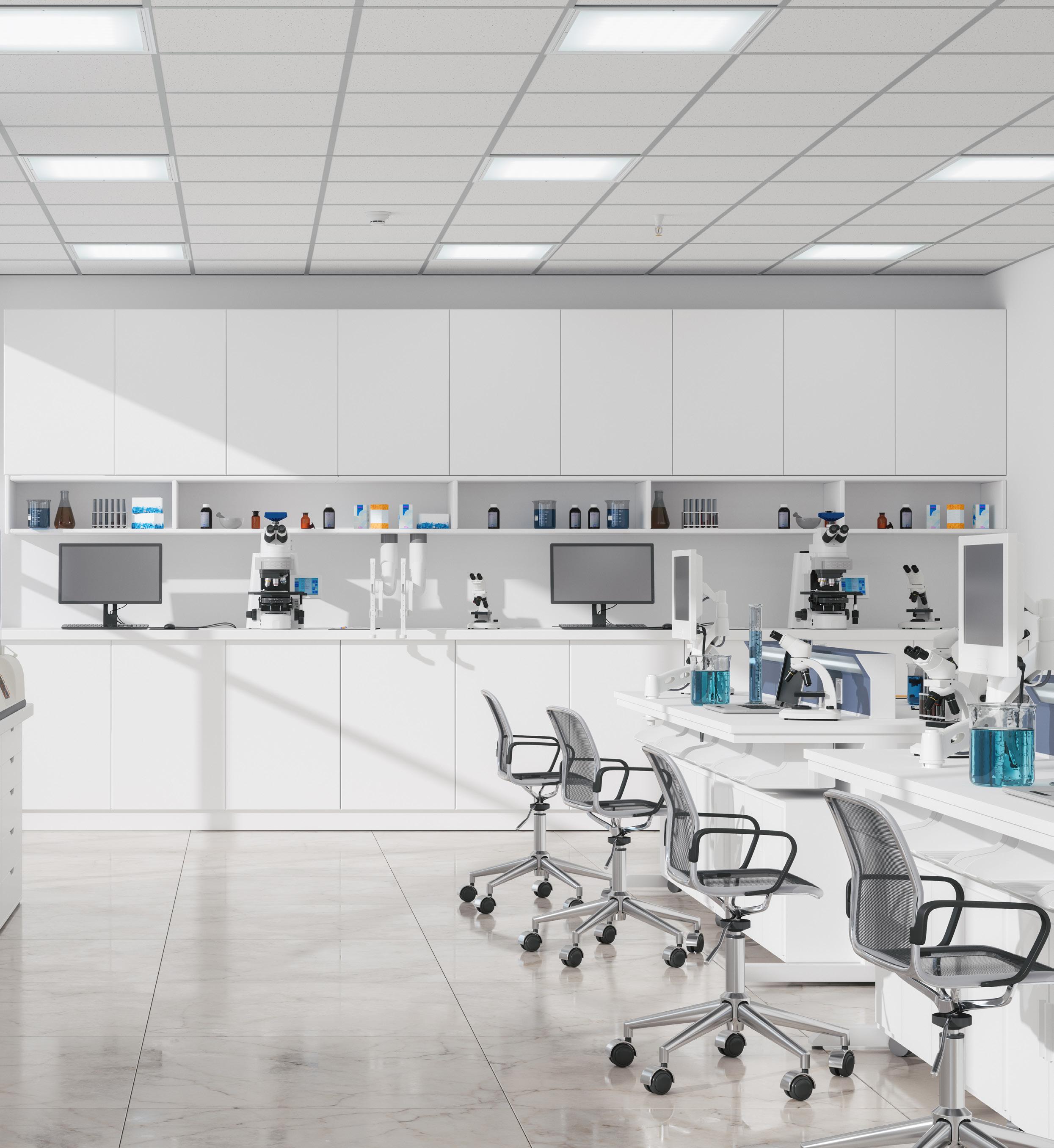



www.Ohaus.com Add Friend with our Line ID:@Ohaus OHAUS LAB Weighing Products Portfolio EX5 MB27 MB23 NV CX CR MB120 SPX AX PX PR


846/4 Lasalle Road, Bangna-Tai Sub-district Bangna District, Bangkok, Thailand 10260 Ohaus Indochina LTD. Tel: +662 7196418-19 E-mail: wutti.techakasembundit@ohaus.com natchuda.boonbunlu@ohaus.com OHAUS LAB Equipment Products Portfolio
FC2706 FC2516
Bead Homogenizer FC5816R
Vortex Mixer
Dry Block Heater
Overhead Stirrer G3000 AB41PH AB33M1
Multitube Vortex
Shaker
LAB matters
ที่ช่วยให้ผู้บริโภคมั่นใจคือการยืนยันคุณภาพและความปลอดภัย
ผ่านการทดสอบในห้องปฏิบัติการทางวิทยาศาสตร์ที่ได้รับการ
Delivering a message on safety and quality of the products by manufacturers themselves is not convincing. A factor influencing the cosumers is that the product is conformed with local or international standards. To comply with the standards, the product shoud be tested by the accredited scientific laboratories also.
Let the lab results expose your product quality.
Editorial Officer

KARUNA CHINTHANOM kc@media-matter.com
APAPAN CHATPAISARN editor@media-matter.com
SITTHIPORN CHOMPURAT journalist@media-matter.com
BENJAMAS SRISUK innolab@media-matter.com
WANASANAN CHINTHANOM agency@media-matter.com
DO innolab.vn@media-matter.com
PUBLISHER
43/308
10150
43/308 Moo 1, Jomthong Road, Jomthong, Bangkok 10150 Thailand
TaxID 0105552007301
+66 875171651 F +66 2045 5358 innolab@media-matter.com
http://www.innolabmagazine.com innolabmagazine
The publisher endeavors to collect and include complete, correct and current information in INNOLAB but does not warrant that any or all such information is complete, correct or current. The publisher does not assume, and hereby disclaims, and liability to any person or entity for any loss or damage caused by errors or omissions of any kind, whether resulting from negligence, accident or any other cause. INNOLAB does not verify any claims or other information appearing in any of the advertisements contained in the magazine, and cannot take any responsibility for any losses or other damages incurred by readers in reliance on such content.
6 www.innolabmagazine.com
บริษัท มีเดีย แมทเทอร์ จำ�กัด
(สำ�นักง�นใหญ่)
หมู่ 1 ถนนจอมทอง แขวงจอมทอง
กรุงเทพฯ
เขตจอมทอง
ผลิตเองนั้น
หนึ่งปัจจัยสำาคัญ
นั้นด้วยการรับรองมาตรฐาน ไม่ว่าจะเป็นมาตรฐานในประเทศ
ผลิตภัณฑ์ต้อง
รับรองมาตรฐานเช่นกัน ให้ผลการทดสอบประกาศคุณภาพของผลิตภัณฑ์ของคุณ
การกล่าวว่าผลิตภัณฑ์มีคุณภาพและความปลอดภัยด้วยผู้
ไม่สามารถทำาให้ผู้บริโภคมั่นใจได้
หรือนานาชาติ และการรับรองตามมาตรฐานนั้น
Editor’s Note Table of Content FEATURES 8 RESEARCH & DEVELOPMENT BRIEF REVOLUTION OF SENSORY EVALUATION 10 PLANT-BASED MEAT SENSORY PROFILES AND AFFORDABILITY 20 REGULATORY ASPARTAME AS (POSSIBLY) CARCINOGENIC TO HUMANS (?) 14 TESTING & ANALYSIS PRESERVATION OF REFERENCE CULTURES 24 TAKE CONTROL OF YOUR MICROBIOLOGICAL QUALITY CONTROL 28 THE RISKS OF FOOD PATHOGENS IN FRESH MEAT PRODUCTS AND HOW TO AVOID THEM 33 ATTRACTIONS THAILAND LAB INTERNATIONAL, BIO ASIA PACIFIC AND FUTURECHEM 2023 38 FI ASIA & VITAFOODS ASIA 2023: DON’T MISS THIS GAME-CHANGING COMBO! 42 COSMOPROF CBE ASEAN 2023 44 IN-COSMETICS ASIA 2023: THE CENTRAL MARKETPLACE FOR EFFICACY TESTING AND DEVELOPMENT 46 NEWS 52 ADVERTISERS OHAUS Indochina FC Cosmoprof CBE ASEAN 2023 IFC Medical Fair Thailand 7 Thailand LAB INTERNATIONAL 9 Fi Asia 43 in-cosmetics Asia 56 ASEAN Sustainble Energy Week 66 Future CHEM INTERNATIONAL IBC Carbon Neutrality BC ADVISORY BOARD ปราโมทย์ ธรรมรัตน์ PRAMOTE TAMMARATE ifrpmt@yahoo.com สมคิด รื่นภาควุฒิ SOMKID RUENPARKWOOT somkid-doa@hotmail.com TEAMWORK ศุภวัชร์ สุขมาก SUPAWAT SUKMARK ss@media-matter.com กรุณา จีนถนอม
อาภาพรรณ ชัฏไพศาล
สิทธิพร ชมภูรัตน์
เบญจมาศ ศรีสุข
วนัสนันท์ จีนถนอม
THU
กรุณา จีนถนอม หัวหน้าบรรณาธิการ Karuna
Chief
Chinthanorm
























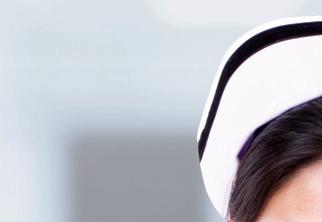

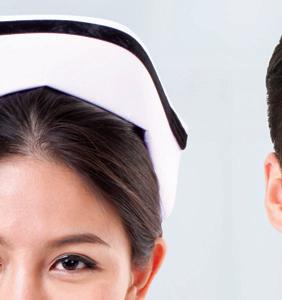





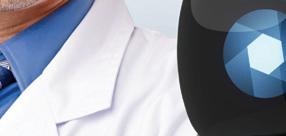





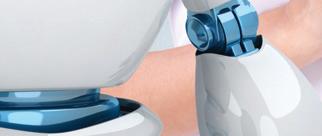
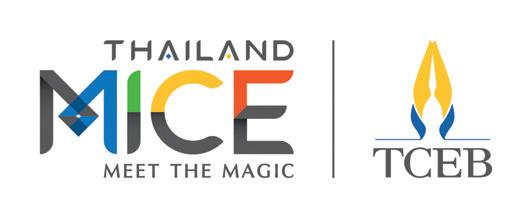
FEATURES
HISTAMINE AND SCOMBROID POISONING
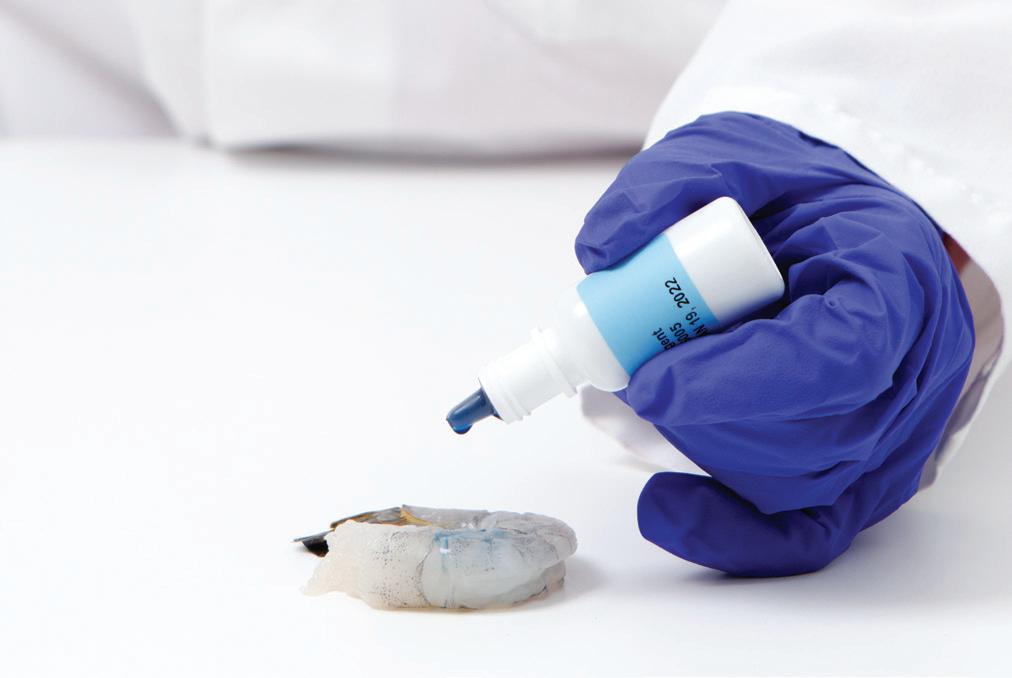
SULFITE
(โซเดียมไบซัลไฟต์ และโซเดียมเม ตาไบซัลไฟต์) ในกุ้งรวมถึงตระกูลคัสเตเชียน เพื่อป้องกันการเกิด จุดดำา
แต่ผู้บริโภคบางรายก็แพ้สารซัลไฟต์ที่ ตกค้างในอาหารอย่างมาก ด้วยเหตุผลนี้
Sulfiting agents, sodium bisulfite and sodium metabisulfite, are used with shrimp and related crustaceans to prevent melanosis (a.k.a. “blackspot”). While sulfiting agents are very beneficial to the seafood industry, some consumers are highly allergic to sulfite residues in food. For this reason, FDA regulations state that seafood containing sulfite residues of 10 parts per million (ppm) or more must be labeled as containing sulfites. Monitoring and verification of sulfite residues are required as part of a Hazard Analysis and Critical Control Points (HACCP) program.

Author info
Ratha Boriboonphoka
Business Development Manager | Thailand
Neogen Asia (Thailand) Co., Ltd.

RBoriboonphoka@neogen.com 063 2253266

8 www.innolabmagazine.com
รฐา บริบูรณ์โภคา
ปริมาณฮีสตามีนเกิดจากการเน่าเปื่อยของปลา เช่น ทูนา มาชิ-มาชิ มาริน บลูฟิช ซาดีน แอนโชวี โบนิโต เฮอร์ริ่ง และ แมคเคอเรล ซึ่งเป็นสาเหตุของโรคอาหารเป็นพิษจากสาร สคอมบรอยด์ ก่อให้เกิดอาการผื่นคัน คลื่นไส้ อาเจียน ท้องเสีย ความดันต่ำา ใจสั่น และกล้ามเนื้ออ่อนแรง FDA ได้กำาหนดระดับ ฮีสตามีนในปลาทั้งในประเทศและนำาเข้าจากต่างประเทศไว้ที่ไม่ เกิน 50 ppm โดยชุดทดสอบฮีสตามีน Reveal® Q+ แบบใหม่ ที่ใช้งานง่าย รายงานผลเชิงปริมาณ สามารถตรวจวัดได้ในช่วง 1.5-40 ppm ภายใน 5 นาที
การใช้สารละลายซัลไฟต์
High levels of histamine may develop in a variety of fish species as they decompose. These species include tuna, mahi-mahi, marlin, bluefish, sardines, anchovy, bonito, herring and mackerel. Ingestion of histamine may cause scombroid poisoning in humans, which may lead to a variety of symptoms, including rash, nausea, vomiting, diarrhea, hypotension, palpitations and muscle weakness. The FDA has set an action level of 50 parts per million (ppm) for histamine in domestic and imported fish. New Reveal® Q+ for Histamine Kit is easy to use, quantitative result, can be measured in the range of 1.5-40 ppm within 5 minutes. ทะเลที่มีซัลไฟต์ตกค้างมากกว่า
(blackspot) แม้ว่าสารซัลไฟต์จะมีประโยชน์อย่างมากต่อ อุตสาหกรรมอาหารทะเล
FDA จึงได้กำาหนดให้อาหาร
10 ppm ขึ้นไปต้องติดฉลากบน
เป็นส่วนหนึ่ง ใน Hazard Analysis Critical Control Point (HACCP) โดย Alert® for Sulfites เป็นชุดทดสอบสารซัลไฟต์ในกุ้ง ใช้งานง่าย สามารถตรวจวัดปริมาณได้ในช่วง10-100 ppm ภายใน 1 นาที
สินค้า รวมถึงกำาหนดให้การตรวจหาปริมาณซัลไฟต์
Alert® for Sulfites Kit is a very simple for detecting sulfite residues in shrimp. The result can be determined within 1 minute and can be measured in the range of 10-100 ppm.

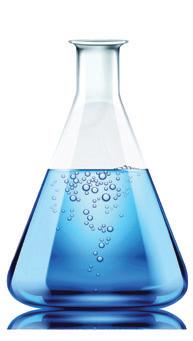
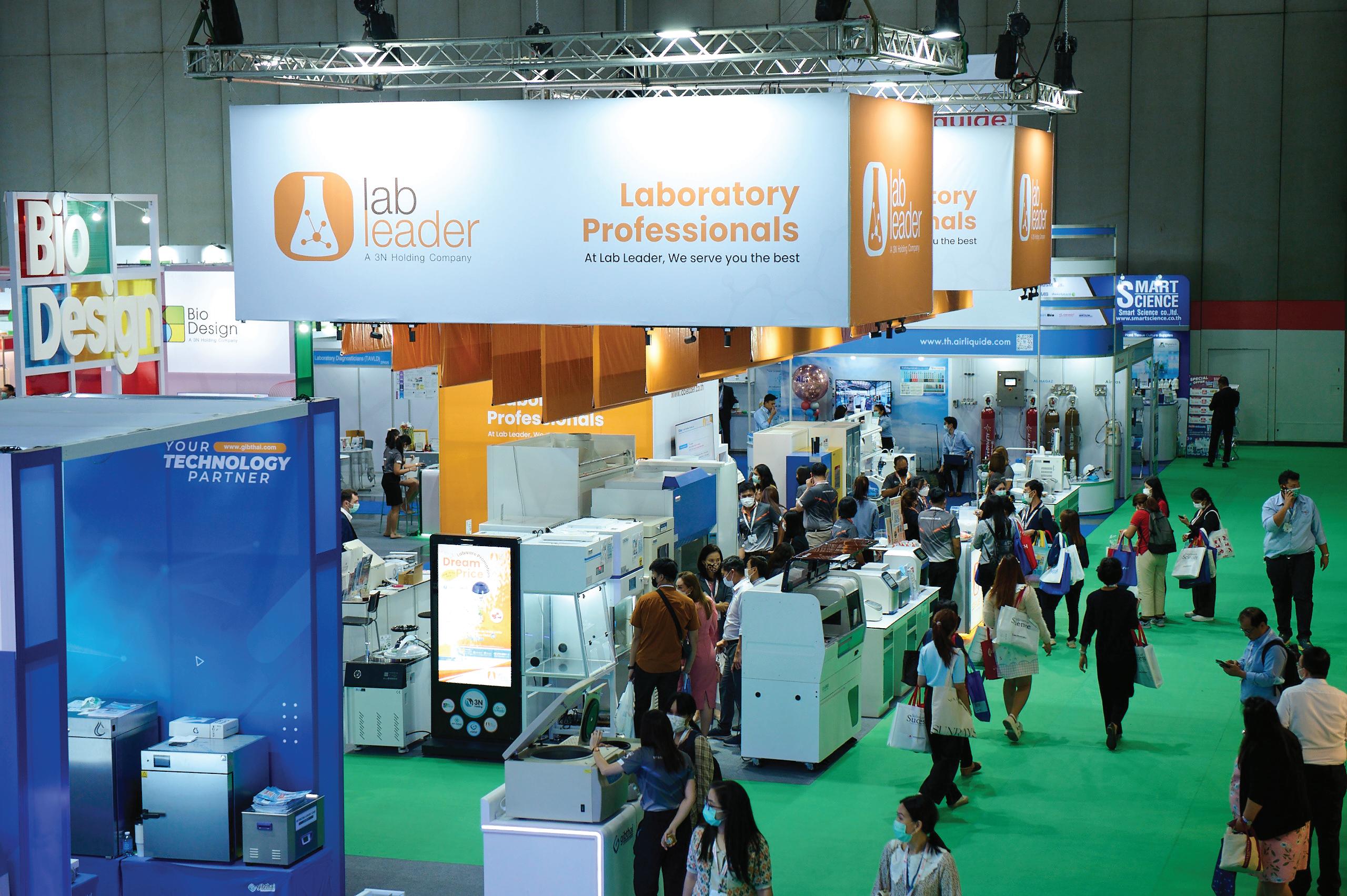
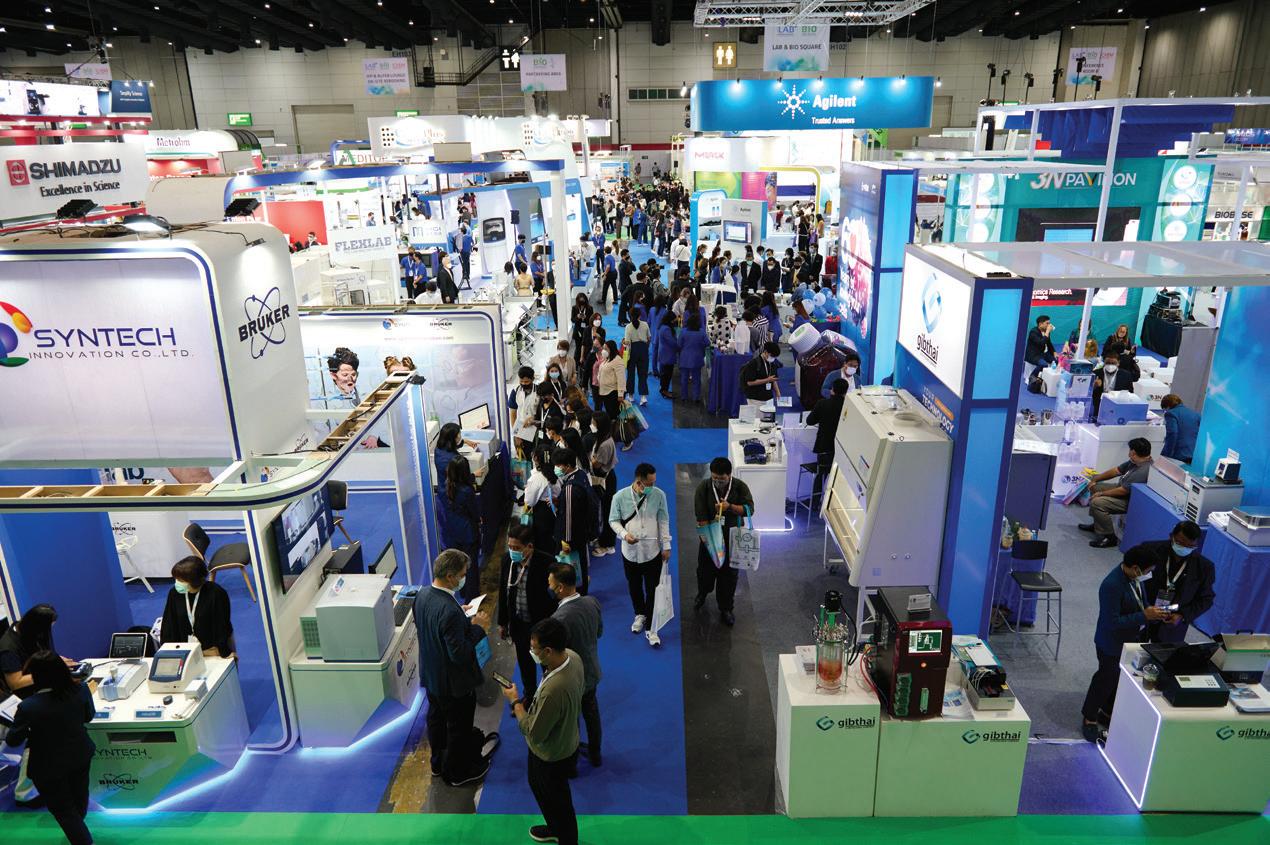





2.
3. ตรวจสอบให้แน่ใจว่าปัจจัยทาง ประสาทสัมผัสที่ไม่เกี่ยวข้องจะไม่รบกวน
4. ฝึกอบรมผู้ทดสอบเพื่อประเมิน ผลิตภัณฑ์ทีละตัวอย่าง (เพื่อประเมิน ลักษณะทางประสาทสัมผัสทีละตัวอย่าง) 5. แยกผู้ทดสอบออกจากกัน โดยให้พวก เขาทดสอบในคูหาหรือห้องเล็กๆ แยกกัน
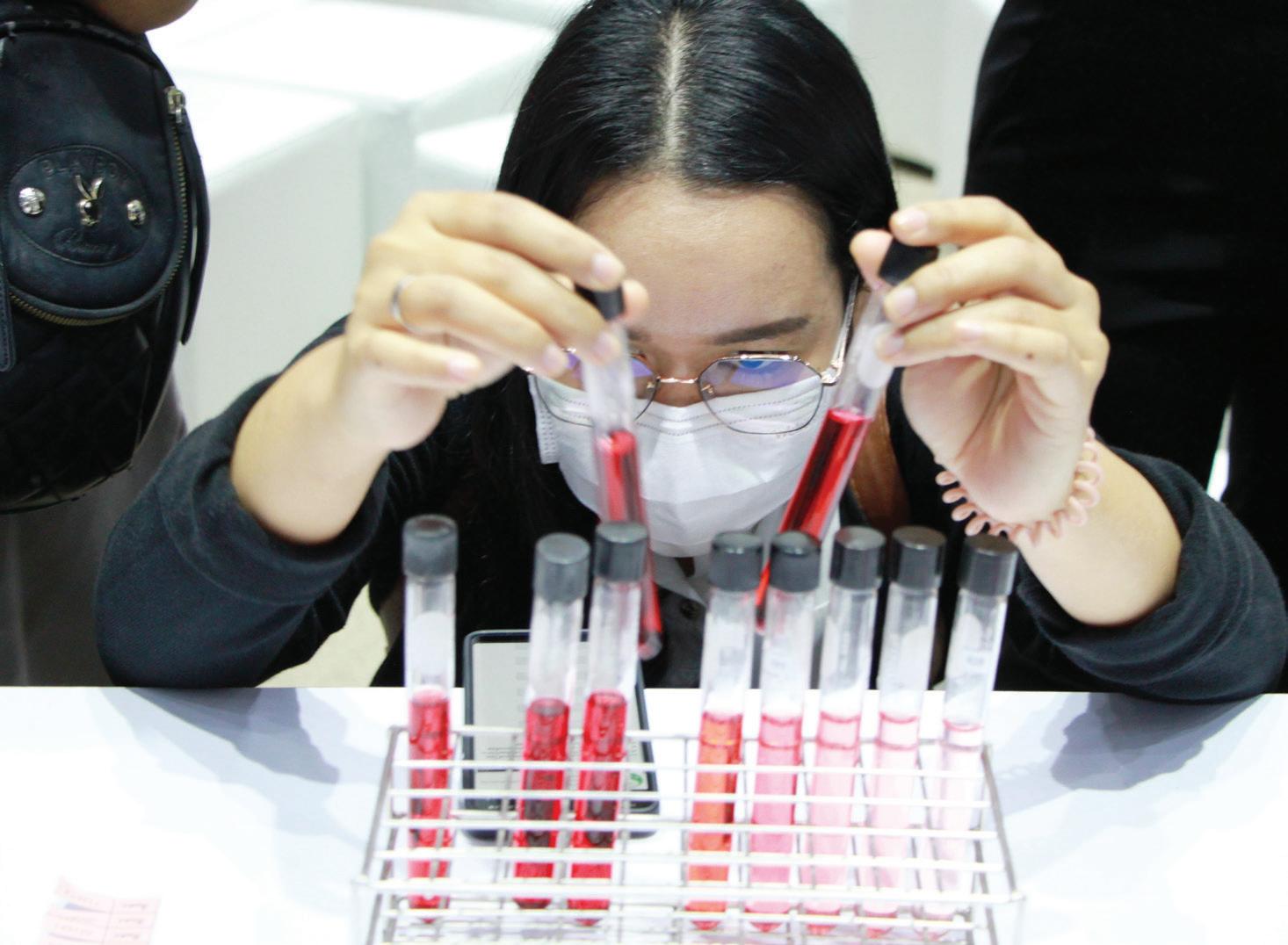
6. กำาชับผู้ทดสอบไม่ให้พูดคุยกันเกี่ยว กับตัวอย่างก่อนการประเมิน (เนื่องจากอาจ สร้างความคาดหวัง)
7. แนะนำาให้ผู้ทดสอบทำาการทดสอบ
ศัพท์ทางกลิ่นรสที่ใช้บรรยายลักษณะทาง ประสาทสัมผัสของผลิตภัณฑ์อาหาร/เครื่อง ดื่มต้องแยกแยะความแตกต่างได้ รวม ทั้งต้องพรรณนาได้ด้วยถ้าสามารถทำาได้ สำาหรับการใช้ภาษาเชิงพรรณนาเพื่อการ แยกแยะ จะต้องสามารถแยกความแตก
กับข้อดีและข้อบกพร่องของผลิตภัณฑ์ของ ตนโดยใช้ต้นทุนต่ำา ดังนั้น ความต้องการ โอกาสในการทดสอบประเภทนี้จึงเพิ่มขึ้น การประเมินทางประสาทสัมผัสมีบทบาท ในการพัฒนาและใช้หลักการและวิธีการวัด การตอบสนองของมนุษย์ต่ออาหารและ เครื่องดื่ม ศาสตร์นี้ขึ้นกับแนวทางการ เตรียมและการเสิร์ฟตัวอย่างภายใต้สภาวะ ควบคุมเพื่อลดปัจจัยด้านอคติ การรับรู้ทาง ประสาทสัมผัสเป็นการเรียนรู้และฝึกฝน อย่างจริงจังไม่ใช่ปฏิกิริยาโต้ตอบ
11 Jul-Aug เทคนิคที่ดีที่สุดที่มีอยู่อย่างเต็มที่ทั้งในด้าน จิตวิทยาและจิตฟิสิกส์” เทคนิคการควบคุมที่มีลการ์ดและคณะ เสนอประกอบด้วย
การทดสอบ เช่น สภาพแสง อุณหภูมิ ความชื้น การออกแบบสถานีทดสอบให้มี แบบเดียวและคงที่
1. การกำาหนดมาตรฐานของเงื่อนไข
กำาจัดตัวแปรรบกวนทั้งหมด (เสียง กลิ่น แสง-สิ่งเร้า
ท่านั่งที่ไม่สบาย)
การออกแรงของบุคคล
การตัดสินของผู้ทดสอบ
เช่น ขนาดของ ตัวอย่าง
เงียบๆ
มีอิทธิพลต่อการตัดสินในด้านประสาทสัมผัส ทุกวันนี้ การทดสอบสามประเภทใช้ ในขั้นตอนการประเมินทางประสาทสัมผัส ได้แก่ การทดสอบแยกความแตกต่าง (discriminative tests) ใช้เพื่อระบุว่ามี ความแตกต่างระหว่างกลุ่มตัวอย่างหรือ ไม่ การทดสอบเชิงพรรณนา (descriptive tests) ใช้เพื่อระบุและวัดปริมาณลักษณะ ทางประสาทสัมผัส (ตัวอธิบาย) ที่มีความ สำาคัญของผลิตภัณฑ์ การทดสอบความชอบ หรือการยอมรับ (affective or hedonic tests) ใช้วัดว่าผู้ทดสอบ (หรือผู้บริโภค ทั่วไป) ชอบตัวอย่างผลิตภัณฑ์มากน้อย เพียงใด ความแปรปรวนของคำาตอบถูก ควบคุมโดยใช้แบบสอบถามมาตรฐานและ มาตราส่วนตัวเลขมาตรฐาน รวมถึงการ วิเคราะห์ทางสถิติ ผลการทดลองและการ แสดงผลลัพธ์ดังกล่าวในรูปกราฟและตาราง เฉพาะผลลัพธ์ที่มีนัยสำาคัญทางสถิติเท่านั้น ที่ถือว่ามีความหมาย หรือกล่าวได้ว่า แม้ การทดลองประเมินทางประสาทสัมผัส จะเกี่ยวข้องกับการประเมินคุณภาพของ ผลิตภัณฑ์ แต่การวัดปริมาณของความรู้สึก จะมีความสำาคัญ โดยปกติ ค่าเฉลี่ยจะถูก คำานวณเพื่อขจัดความสัมพันธ์เฉพาะของผู้ เข้าร่วมทดสอบแต่ละคนออกจากภาพรวม คุณภาพทางประสาทสัมผัสของผลิตภัณฑ์ มีการตีพิมพ์บทความหลายฉบับในสาขา ที่เกี่ยวข้องกับการพัฒนาคำาศัพท์ทางประสาท สัมผัส (sensory lexicon) การสร้างคำา ศัพท์เหล่านี้ (กลุ่มของคำาที่เรียกทั่วไปว่า lexicon) มีความสำาคัญอย่างยิ่งต่อการ กำาหนดมาตรฐานและการสื่อสารระหว่าง ผู้เชี่ยวชาญด้านประสาทสัมผัสที่ทำางานใน ประเทศต่างๆ และการสื่อสารคุณลักษณะ ทางประสาทสัมผัสของผลิตภัณฑ์ไปยังผู้ บริโภค คำาศัพท์ทางประสาทสัมผัสถูกนำามา ใช้โดยใช้เทคนิคการวิเคราะห์ทางประสาท สัมผัสเชิงพรรณนา มีการจัดทำารายการคำา ศัพท์เพื่ออธิบายผลิตภัณฑ์ (ไวน์ ขนมปัง เบียร์ กาแฟ ช็อกโกแลต) หลายปีที่ผ่าน มา คำาศัพท์เฉพาะที่สื่อความหมายในรูป แบบวงล้อได้รับการพัฒนาสำาหรับไวน์ เบียร์ และสุรากลั่น รวมถึงเครื่องดื่มแอลกอฮอล์ อื่นๆ เช่น ไวน์ Pink Port และช็อกโกแลต ลอว์เลสและเฮย์แมนน์ (1998, Sensory Evaluation of Food: Principles and Practices) เสนอว่าคุณลักษณะของคำา
การรับ ความรู้สึกไม่ได้เกิดขึ้นจากอาหาร/เครื่อง ดื่มหรือจากผู้บริโภค แต่เกิดร่วมกันเมื่อมี อาหาร/เครื่องดื่มและผู้บริโภค หรือกล่าว คือ ไม่ใช่ทั้งรสชาติและผู้ทดสอบ แต่หมาย ถึงการทดสอบรสชาติ ภาพจากงาน Sensory Box, Fi ASIA 2022
เนื่องจากความคิดเห็นหรือเสียงอาจ
ต่างของผลิตภัณฑ์ที่พัฒนาขึ้นได้ ทุกวัน
นี้ การทดสอบขนาดเล็กโดยผู้บริโภคช่วย ให้บริษัทได้รับข้อมูลที่เป็นประโยชน์เกี่ยว
Humans have used their senses to evaluate food for several thousands of years. Given that so many phytotoxins and bacterial metabolites are bitter and sour, humanity had probably used sensory evaluation since before Homo sapiens were human.
Its origins can be traced back to the 1930s when the Arthur D. Little industrial consulting firm, in the U.S., devised a flavor profile method and hedonic index for use by commercial food and beverage companies, and the first panel on Flavor in Foods was presented at the 1937 meeting of the American Chemical Society.
In the United States, during World War II, it arose from the need to produce quality foods that were not rejected by army soldiers. From this need the methods of application of the tasting appeared, establishing the sensorial analysis as a scientific basis. During the 1940s-1950s, sensory evaluation received additional motivation through the U.S. Army Quartermaster Food and Container Institute, which supported research in food acceptance for the armed forces. A few studies were published on browning - in attempting to understand the mechanisms and control of browning and about colors in foods. So, Funds were assigned to studies of the problems of identifying what foods were preferred as well as the more fundamental issue of the measurement of food acceptance.
During the 1960s and early 1970s due to implementation of the U.S. federal government program “War on Hunger”. The government’s desire to feed the starving and undernourished met with frustration when product after the product was rejected by the target consumers, primarily because no one troubled to determine whether the sensory properties of these products were acceptable to the targeted groups.
Mainly due to government’s
successes and failures in sensory evaluation, the food industry began to provide support for this developing science and various studies were custom-built to find out how to make the food more acceptable.
As civilization developed and the trading and selling of goods became a commonplace, the first seeds of food sensory testing were planted. Tasting methods, as a form of sensory analysis of foods, were applied for the first time in Europe, a long time ago, to control the quality of breweries and distilleries. There is a class of scientists who specialize in the analysis of the sensory qualities of merchandises – the color, sound, smell, taste, and feel of things. The original name for this area of research was “organoleptic”, and the person who performed the analysis the “organoleptician”.
The title of organoleptician has since been dropped and replaced by “sensory professional” or “sensory scientist”. The sensory evaluation of food products remains central to the practice of these professionals of the sensory science.
The food industry traditionally viewed sensory evaluation in the context of the company “expert” who through years of accumulated experience was able to describe company products and set standards of quality by which raw materials would be purchased and each product manufactured and marketed. Examples of such experts include the perfumer, flavorist, brew-master, winemaker, and coffee and tea tasters.
Sensory professionals also have effort to expand their role within the

companies they worked for, seeking to convince management that the application of sensory evaluation techniques is crucial to every stage of product development, from product conception to product consumption. They usually use the language of driving, as in “sensory properties drive consumer acceptance and emotional benefits”, and it has had the desired effect.
Meilgaard et al. (2010, Sensory Evaluation Techniques, 3rd edition) affirm that the key to sensory analysis is: “to treat the panelists as measuring instruments. As such, they are highly variable and very prone to bias, but they are the only instruments that will measure what we want to measure so we must minimize the variability and control the bias by making full use of the best existing techniques in psychology and psychophysics”.
12 www.innolabmagazine.com
ภาพจากงาน Sensory Box, Fi ASIA 2022
The controls techniques mentioned by Meilgaard et al. include:
1. Standardization of the test conditions, e.g. constant single lighting conditions, temperature, humidity, test station design
2. Elimination of all disturbance variables (sounds, odors, light-stimuli, the exertion of persons, uncomfortable sitting position)
3. Ensuring that irrelevant sensory factors, such as the size of the samples, do not interrupt on the panelists’ judgment
4. Train panelists to evaluate products monadically (to assess one sensory characteristic at a time)
5. Isolating one panelist from another by having them perform their tasks in individual booths or cubicles
6. Instructing the panelists not to discuss samples before evaluation (since this might create expectations)
7. Instructing the panelists to work in silence, since comments or noises made out loud can influence sensory judgments
Nowadays, there are three kinds of tests used in sensory evaluation procedures. Discriminative tests, used to determine if a difference exists among samples. Descriptive tests, employed to identify and quantify sensory characteristics (descriptors) that are important in a product. Affective or hedonic tests, used to measure how much a panelist (or just a simple consumer) likes a product sample. The variability of responses is controlled using standardized questionnaires and standard numerical scales as well as through statistical analysis. The results of the experiments, and the plotting of such results in the form of graphs and tables. Only results which are statistically significant are considered meaningful. In other words, while sensory evaluation experiments are concerned with assessing the qualities of products, it is the quantification of sensation that counts. Averages are usually calculated so that any trace of the subjective associations of individual panelists can be eradicated from the overall picture of a product’s sensory qualities.
Many of the papers published in the field are concerned with the development of sensory lexicons. The construction of these vocabularies (a group of words, commonly called a lexicon), is essential both for standardization and communication among sensory professionals working in different countries, and the communication of product sensory attributes to the consumers. Sensory lexicons are applied using descriptive sensory analysis techniques. They provide a source list to describe products (wine, bread, beer, coffee, chocolate). Over the years, descriptive lexicons represented in wheel form,
have been developed for wine, beer, and spirits, among others alcoholic beverages like Pink Port Wines and chocolate.
Characteristics of flavor lexicons to be used in food/beverages products sensory profiles have been discussed by Lawless and Heymann (1998, Sensory Evaluation of Food: Principles and Practices). A vital characteristic of a good flavor lexicon is that it must be discriminative, as well as, descriptive, if possible. For a descriptive language to be discriminating, it must be able to differentiate the products for which it was developed. Nowadays, small scale internal consumer tests provide a company with a cheap way to get valuable information regarding the advantages and flaws of their products. Therefore, the demand for possibilities to do this kind of test has increased.
Sensory evaluation involves the development and use of principles and methods for measuring human responses to food and beverages. This science depends on guidelines for the preparation and serving of samples under controlled conditions so that biasing factors can be minimized. Sensory perception is a learned and active practice and not a passive reflex. Sensations are held to arise neither from the food/beverage nor from the consumer, but from the encounter between them, that is, it is neither taste nor taster, but tasting.
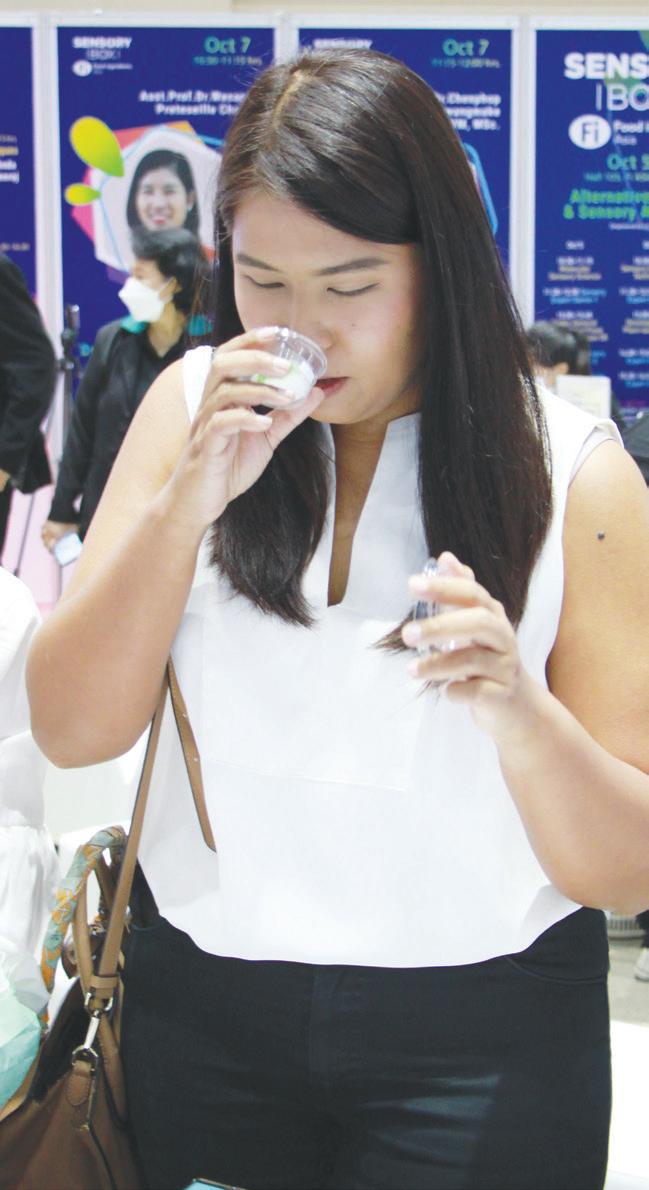
13 Jul-Aug
ภาพจากงาน Sensory Box, Fi ASIA 2022
Author info กองบรรณาธิการนิตยสารอินโนแล็บ INNOLAB team innolab@media-matter.com
Aspartame - as (Possibly)
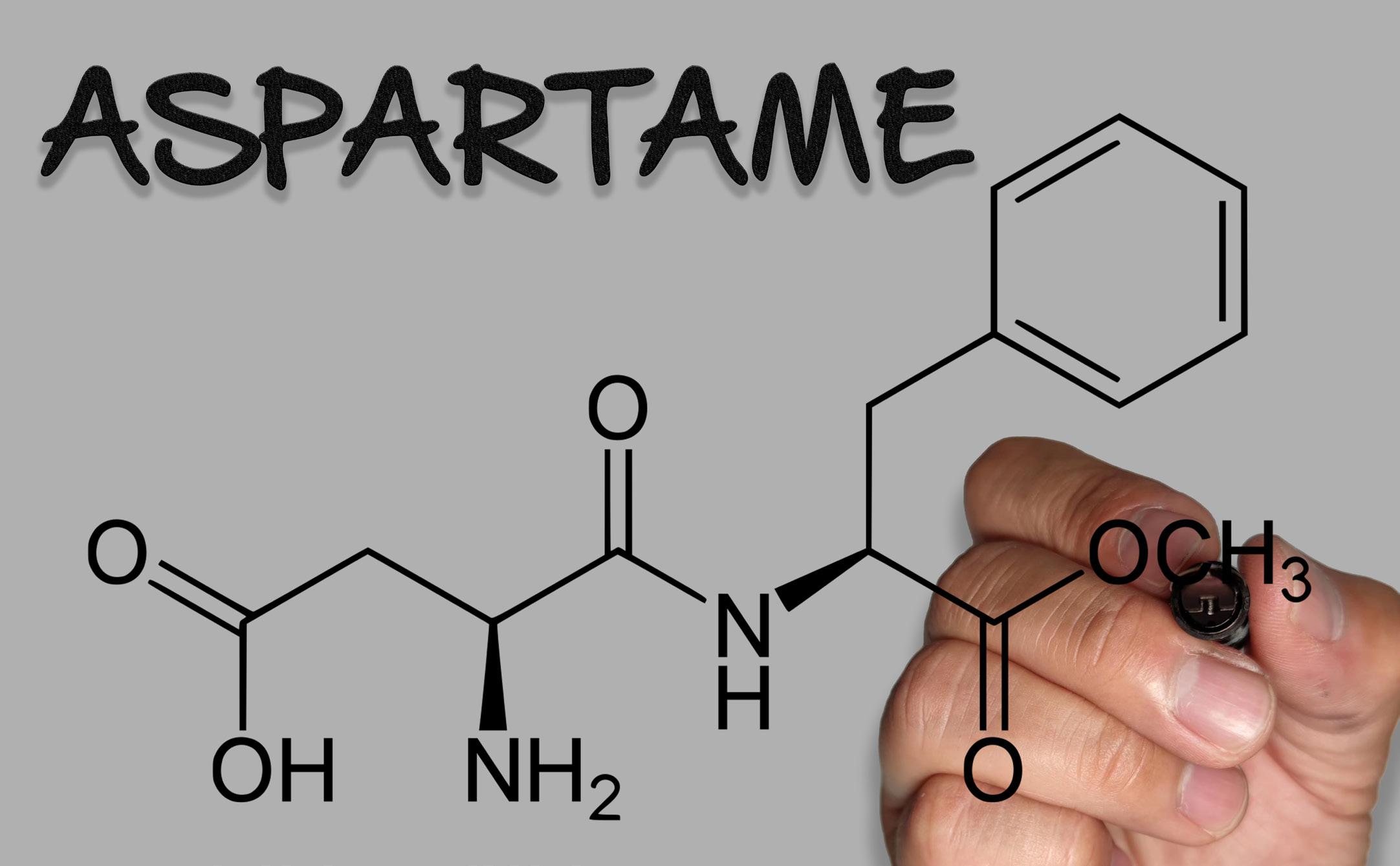
Carcinogenic to Humans (?)
การประเมินผลกระทบต่อสุขภาพของแอสปาร์แตมซึ่งเป็นสารให้ความหวานที่ไม่ใช่น้ำาตาล (NSS) ชนิดหนึ่ง เผยแพร่โดยองค์การ ระหว่างประเทศเพื่อการวิจัยโรคมะเร็ง (IARC) และคณะผู้เชี่ยวชาญร่วม FAO/WHO ด้านวัตถุเจือปนอาหาร (JECFA) IARC
ให้อยู่ในกลุ่มเป็นไปได้ที่จะเป็นสารก่อมะเร็งในมนุษย์
IARC ทำาการประเมินแอสปาร์แตมและเป็น
IARC จำาแนกแอสปาร์แตมว่าเป็นไปได้ว่าจะ เป็นสารก่อมะเร็งในมนุษย์ (กลุ่ม 2B) จาก หลักฐานที่ยังมีจำากัด
จะได้รับมากกว่าปริมาณที่ยอมรับได้ในแต่ละ วัน หากไม่มีการบริโภคจากแหล่งอาหารอื่น การระบุอันตรายของ IARC
เป็นขั้นตอน
พื้นฐานขั้นแรกในการทำาความเข้าใจเกี่ยวกับ การก่อมะเร็งของสาร โดยการระบุคุณสมบัติ เฉพาะและศักยภาพในการก่อให้เกิดอันตราย ได้แก่ มะเร็ง การจำาแนกประเภทของ IARC สะท้อนถึงความแน่นหนาของหลักฐานทาง วิทยาศาสตร์ว่าสารสามารถก่อให้เกิดมะเร็ง ในมนุษย์ได้หรือไม่ แต่ไม่ได้แสดงถึงความ เสี่ยงในการเกิดมะเร็งในระดับที่ได้รับสัมผัส ในระดับที่กำาหนด การประเมินอันตรายของ IARC จะพิจารณาการรับสัมผัสทุกประเภท
จำาแนก
(กลุ่ม 2B) และ JECFA ได้ยืนยันปริมาณที่ยอมรับได้ต่อวัน 40 มิลลิกรัม/ กิโลกรัมน้ำาหนักตัว REGULATORY ทั้งสองหน่วยงานดำาเนินการทบทวนอย่าง เป็นอิสระแต่เสริมกันเพื่อประเมินอันตราย
ความเสี่ยงด้านสุขภาพอื่นๆ
ที่อาจเกิดขึ้นจากการเป็นสารก่อมะเร็งและ
ที่เกี่ยวข้องกับ การบริโภคแอสปาร์แตม นับเป็นครั้งแรกที่
ครั้งที่สามสำาหรับ JECFA หลังจากทบทวน วรรณกรรมทางวิทยาศาสตร์ที่มีอยู่
ทั้งสอง หน่วยงานได้ระบุข้อจำากัดของหลักฐานการ เกิดมะเร็ง (และผลกระทบต่อสุขภาพอื่นๆ)
(โดยเฉพาะอย่างยิ่งการ ทำาให้เกิดมะเร็งเซลล์ตับ (hepatocellular carcinoma) ซึ่งเป็นมะเร็งตับชนิดหนึ่ง) นอกจากนั้น หลักฐานการเกิดมะเร็งในสัตว์ ทดลองยังมีจำากัด และหลักฐานที่เกี่ยวข้อง กับกลไกที่เป็นไปได้ในการก่อให้เกิดมะเร็งก็ มีจำากัดเช่นกัน JECFA สรุปว่าการประเมินข้อมูลแสดงให้ เห็นว่าไม่มีเหตุผลเพียงพอที่จะเปลี่ยนแปลง ปริมาณแอสปาร์แตมที่ยอมรับได้ต่อวัน 0-40 มิลลิกรัม/กิโลกรัมน้ำ า หนักตัว ที่กำ า หนดไว้ ก่อนหน้านี้ คณะกรรมการจึงยืนยันว่าแอส ปาร์แตมมีความปลอดภัยสำาหรับผู้ที่บริโภค ภายใต้ขีดจำากัดต่อวัน เช่น น้ำาอัดลมแบบได เอต 1 กระป๋อง มีแอสปาร์แตม 200 หรือ 300 มิลลิกรัม ผู้ใหญ่ที่มีน้ำาหนัก 70 กิโลกรัม จะต้องดื่มมากกว่า 9-14 กระป๋องต่อวัน จึง
14 www.innolabmagazine.com
มีจำากัด เน้นย้ำาถึงความจำาเป็นในการวิจัยเพิ่ม เติมเพื่อปรับความเข้าใจของเราว่าการบริโภค แอสปาร์แตมก่อให้เกิดอันตรายในฐานะสาร ก่อมะเร็งหรือไม่ การประเมินความเสี่ยงของ JECFA กำาหนด ความน่าจะเป็นของอันตรายเฉพาะประเภท
ทั้งสองหน่วยงานได้ดำาเนินการเพื่อให้แน่ใจ ว่าการประเมินเป็นอิสระและเชื่อถือได้ IARC และ WHO จะติดตามหลักฐานใหม่ๆ และ สนับสนุนให้กลุ่มวิจัยอิสระพัฒนาการศึกษา เพิ่มเติมเกี่ยวกับความสัมพันธ์ที่อาจเกิดขึ้น ระหว่างการรับสัมผัสแอสปาร์แตมกับผลกระ ทบต่อสุขภาพของผู้บริโภค
แอสปาร์แตมเป็นสารให้ความหวานเทียม (เคมี) ที่ใช้อย่างแพร่หลายในผลิตภัณฑ์อาหาร

15 Mar-Apr (เช่น อาหาร การประกอบอาชีพ) การจำาแนก ความแน่นหนาของหลักฐานในกลุ่ม 2B ซึ่งเป็น ระดับที่สามจากสี่ระดับ โดยทั่วไปจะใช้เมื่อมี หลักฐานการเกิดมะเร็งในมนุษย์ที่มีจำากัดแต่ยัง ไม่สามารถเชื่อได้ หรือหลักฐานที่เชื่อถือได้ของ การมะเร็งในสัตว์ทดลอง
ฐานทั้งสองประการ การค้นพบหลักฐานการ ก่อมะเร็งในมนุษย์และสัตว์ที่ยังมีจำากัด และ หลักฐานของกลไกเกี่ยวกับการก่อมะเร็งที่ยัง
ระดับของการรับสัมผัสอย่างจำาเพาะ โดยทั่วไป JECFA จะพิจารณาการจัดประเภทของ IARC อย่างรอบคอบเสมอ นอกจากนั้น JECFA จะ พิจารณาหลักฐานเกี่ยวกับความเสี่ยงของมะเร็ง ในการศึกษาในสัตว์และในมนุษย์ และสรุปว่า หลักฐานความสัมพันธ์ระหว่างการบริโภคแอ สปาร์แตมกับมะเร็งในมนุษย์นั้นยังไม่น่าเชื่อ ถือ จำาเป็นต้องมีการศึกษาให้ดีขึ้นด้วยการ ติดตามผลในระยะเวลาที่นานขึ้น และจัดทำา แบบสอบถามซ้ำาเกี่ยวกับอาหารในกลุ่มประชากร ที่มีอยู่ เช่นเดียวกับการทดลองแบบสุ่มที่มีกลุ่ม ควบคุม การศึกษาวิถีทางกลไกที่เกี่ยวข้องกับ การควบคุมโดยอินซูลิน กลุ่มอาการเมตาบอลิ ซึม และโรคเบาหวาน โดยเฉพาะอย่างยิ่งส่วน ที่เกี่ยวข้องกับการก่อมะเร็ง การประเมินผลกระทบจากแอสปาร์แตม โดย IARC และ JECFA มาจากข้อมูลทาง วิทยาศาสตร์ที่รวบรวมจากแหล่งข้อมูลต่างๆ รวมถึงเอกสารวิชาการที่ผ่านการตรวจสอบ โดยผู้เชี่ยวชาญ รายงานของรัฐบาล และการ ศึกษาที่ดำาเนินการเพื่อวัตถุประสงค์ด้านการ ออกกฎระเบียบ การศึกษาที่ได้รับการตรวจ สอบโดยผู้เชี่ยวชาญอิสระ และคณะกรรมการ
แต่ไม่ใช้เมื่อมีหลัก
ได้แก่ มะเร็ง ที่จะเกิดขึ้นภายใต้สภาวะและ
และเครื่องดื่มต่างๆ ตั้งแต่ทศวรรษ 1980 ได้แก่ เครื่องดื่มลดน้ำาหนัก หมากฝรั่ง เจลา ติน ไอศครีม ผลิตภัณฑ์จากนม เช่น โยเกิร์ต อาหารเช้าธัญพืช ยาสีฟัน และยา เช่น ยาแก้ ไอและวิตามินแบบเคี้ยว ภาพที่ 1: ระดับความเชื่อมั่นของการเป็นสารก่อมะเร็ง Figure 1: Level of certainty that a substance can cause cancer
IARC
Source:
Assessments of the health impacts of the non-sugar sweetener (NSS), aspartame, are released by the International Agency for Research on Cancer (IARC) and the World Health Organization (WHO) and the Food and Agriculture Organization (FAO) Joint Expert Committee on Food Additives (JECFA). Citing “limited evidence” for carcinogenicity in humans, IARC classified aspartame as possibly carcinogenic to humans (IARC Group 2B) and JECFA reaffirmed the acceptable daily intake (ADI) of 40 mg/kg body weight.
The two bodies conducted independent but complementary reviews to assess the potential carcinogenic hazard and other health risks associated with aspartame consumption. This was the first time that IARC has evaluated aspartame and the third time for JECFA. After reviewing the available scientific literature, both evaluations noted limitations in the available evidence for cancer (and other health effects). IARC classified aspartame as possibly carcinogenic to humans (Group 2B) on the basis of limited evidence for cancer in humans (specifically, for hepatocellular carcinoma, which is a type of liver cancer). There was also limited evidence for cancer in experimental animals and limited evidence related to the possible mechanisms for causing cancer.
JECFA concluded that the data evaluated indicated no sufficient reason to change the previously established acceptable daily intake of 0–40 mg/kg body weight for aspartame. The committee therefore reaffirmed that it is safe for a person to consume within this limit per day. For example, with a can of diet soft drink containing 200 or 300 mg of aspartame, an adult weighing 70kg would need to consume more than 9–14 cans per day to exceed the acceptable daily intake, assuming no other intake from other food sources.
IARC’s hazard identifications are the first fundamental step to understand the carcinogenicity of an agent by identifying its specific properties
and its potential to cause harm, i.e. cancer. IARC classifications reflect the strength of scientific evidence as to whether an agent can cause cancer in humans, but they do not reflect the risk of developing cancer at a given exposure level. The IARC hazard evaluation considers all types of exposures (e.g. dietary, occupational). The strength-of-evidence classification in Group 2B is the third highest level out of 4 levels, and it is generally used either when there is limited, but not convincing, evidence for cancer in humans or convincing evidence for cancer in experimental animals, but not both. The findings of limited evidence of carcinogenicity in humans and animals, and of limited mechanistic evidence on how carcinogenicity may occur, underscore the need for more research to refine our understanding on whether consumption of aspartame poses a carcinogenic hazard.
JECFA’s risk assessments determine the probability of a specific type of harm, i.e. cancer, to occur under certain conditions and levels of exposure. It is not unusual for JECFA to factor IARC classifications into its deliberations. JECFA also considered the evidence on cancer risk, in animal and human studies, and concluded that the evidence of an association between aspartame consumption and cancer in humans is not convincing. Better studies with longer follow-up and repeated dietary questionnaires in existing cohorts are needed, as well as randomized
controlled trials, including studies of mechanistic pathways relevant to insulin regulation, metabolic syndrome, and diabetes, particularly as related to carcinogenicity.
The IARC and JECFA evaluations of the impact of aspartame were based on scientific data collected from a range of sources, including peer-reviewed papers, governmental reports and studies conducted for regulatory purposes. The studies have been reviewed by independent experts, and both committees have taken steps to ensure the independence and reliability of their evaluations. IARC and WHO will continue to monitor new evidence and encourage independent research groups to develop further studies on the potential association between aspartame exposure and consumer health effects.

Aspartame is an artificial (chemical) sweetener widely used in various food and beverage products since the 1980s, including diet drinks, chewing gum, gelatin, ice cream, dairy products such as yogurt, breakfast cereal, toothpaste, and medications such as cough drops and chewable vitamins.
Classification of Carcinogenic Substance
The IARC is an intergovernmental agency established in 1965, which forms part of the World Health Organization of the United Nations. It is based in Lyon, France. Since 1971 it has published a series of Monographs on the Evaluation of
Carcinogenic Risks to Humans that have been highly influential in the classification of possible carcinogens.
Group 1: the agent (mixture) is definitely carcinogenic to humans. The exposure circumstance entails exposures that are carcinogenic to humans.
Group 2A: the agent (mixture) is probably (product more likely to be) carcinogenic to humans. The exposure circumstance entails exposures that are probably carcinogenic to humans.
Group 2B: the agent (mixture) is possibly (chance of product being) carcinogenic to humans. The exposure circumstance entails exposures that are possibly carcinogenic to humans.
Group 3: the agent (mixture or exposure circumstance) is not classifiable as to its carcinogenicity to humans.
Group 4: the agent (mixture) is probably not carcinogenic to humans.
Sweeteners
Sweeteners or sugar substitutes, such as aspartame, sucralose, and stevia derived substances, are ingredients used to sweeten and in some cases enhance the flavor of foods. Some sweeteners are much sweeter than table sugar, and smaller amounts are needed to achieve the same level of sweetness as sugar in food. People may choose to use sweeteners instead of sugar for various reasons. For example, sweeteners contribute only a few or no calories to the diet and generally will not raise blood sugar levels.

Sweeteners Authorized as Food Additives in the U.S.
Based on the available scientific evidence, sweeteners authorized by the FDA are safe for the general population under certain conditions of use. There are food additive listings for six sweeteners, including: Aspartame, Acesulfame potassium (Ace-K),
Sucralose, Neotame, Advantame, and Saccharin.
In addition to the six sweeteners listed as food additives, the agency evaluated GRAS notices (Generally Recognized as Safe (GRAS) Notice) and has no questions about the GRAS conclusions for three types of plant and fruit-based high-intensity sweeteners: Certain steviol glycosides obtained from the leaves of the stevia plant (Stevia rebaudiana) or fermentation-based processes, extracts from Siraitia grosvenorii fruit, also known as Luo Han Guo or monk fruit, and thaumatin from katemfe (Thaumatococcus daniellii) .
The FDA permits the use of sugar alcohols, another class of sweeteners, as sugar substitutes. Examples include sorbitol, xylitol, lactitol, mannitol, erythritol, and maltitol. The sweetness of sugar alcohols varies from 25% to 100% as sweet as sugar. Sugar alcohols are
18 www.innolabmagazine.com
ภาพที่ 2: ความหวานของสารให้ความหวานเทียบกับน้ำาตาลทราย
Figure 2: Sweetness intensity of sweeteners compared to table sugar or sucrose.
Source: USFDA
slightly lower in calories than sugar and do not promote tooth decay or cause a sudden increase in blood glucose. They primarily sweeten sugar-free candies, cookies, and chewing gum.
WHO Guidelines on Non-sugar Sweeteners
The World Health Organization (WHO) released a new guideline on non-sugar sweeteners (NSS that advises against use of NSS to control body weight or reduce the risk of noncommunicable diseases. After conducting a research review, they concluded that replacing sugar sweeteners with NSS did not promote weight loss in the long term in adults and children. However, clinical trial data showed that higher intakes of NSS resulted in lower calorie intake when they replaced sugar and sugar-sweetened foods/beverages. There was no significant effect of NSS on hunger or satiety levels. Some trials showed less hunger with use of NSS, but others showed a stronger appetite in participants with higher intakes of NSS-containing beverages.
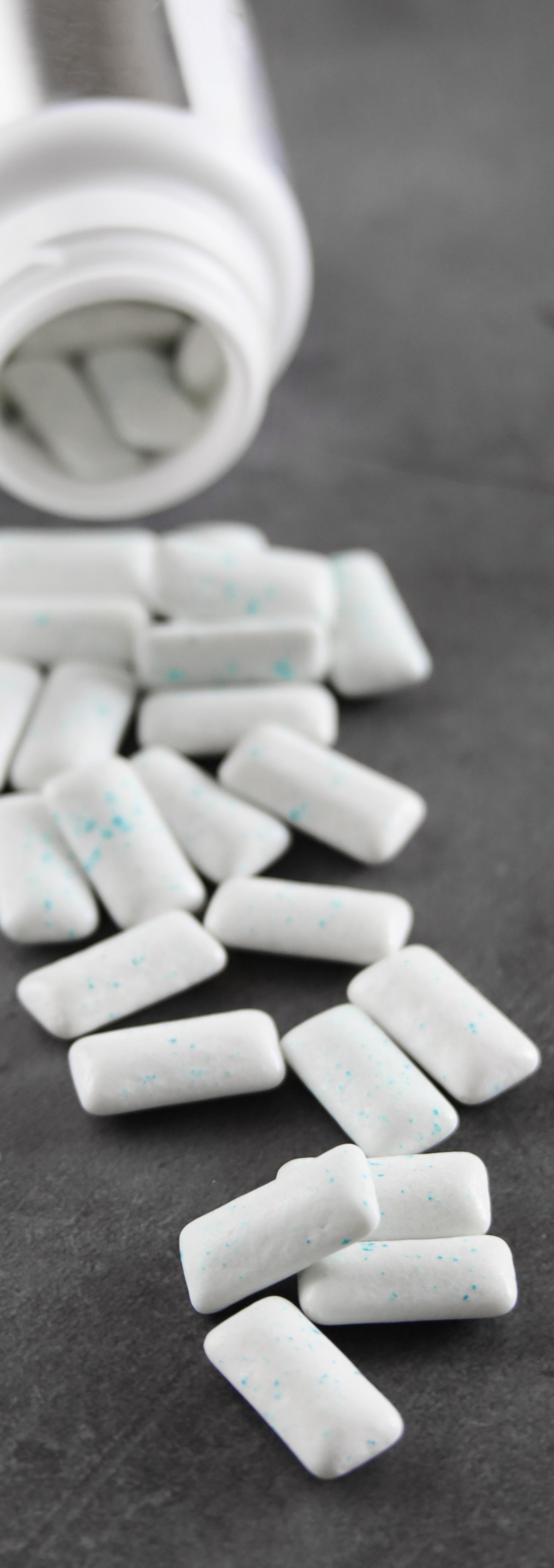
When looking at observational cohort studies, long-term use of NSS-containing beverages was associated with an increased risk of cardiovascular disease and early death in adults. A higher intake of NSS, either in beverages or added to foods, was also associated with increased risk of developing type 2 diabetes. The WHO noted that “reverse causation” may have contributed to the positive association: participants with the highest intakes of NSS tended to have a higher body mass index and obesity or metabolic risk factors, and therefore may have already been predisposed to chronic disease (for which they were choosing NSS as a health measure). No association was found with intakes of NSS-containing beverages and cancer or cancer deaths.
Based on these findings, WHO advised that people work to lower the overall sweetness in the diet starting early in life, as NSS do not provide nutritional value. Examples of NSS include acesulfame K, aspartame, saccharin, sucralose, and stevia. Their analysis did not study sugar alcohols (polyols) such as maltitol, xylitol, and sorbitol that are added to many foods and beverages.
Article info
IARC. (2023, July 27). Agents Classified by the IARC Monographs. Vol. 1–134; Last update: 27 July 2023. https://monographs.iarc. who.int/agents-classified-by-the-iarc/
Harvard T.H. Chan School of Public Health. (2023 July 6). Unpacking WHO guidelines on non-sugar sweeteners. The Nutrition Source. Nutrition News. Category: Features. https://www.hsph.harvard.edu/ nutritionsource/2023/06/06/who-guidelines-non-sugar-sweeteners
WHO. (2023, July 14). Aspartame hazard and risk assessment results released.
Joint News Release. https://www.who.int/news/item/14-07-2023aspartame-hazard-and-risk-assessment-results-released
19 Jul-Aug
Plant-Based Meat
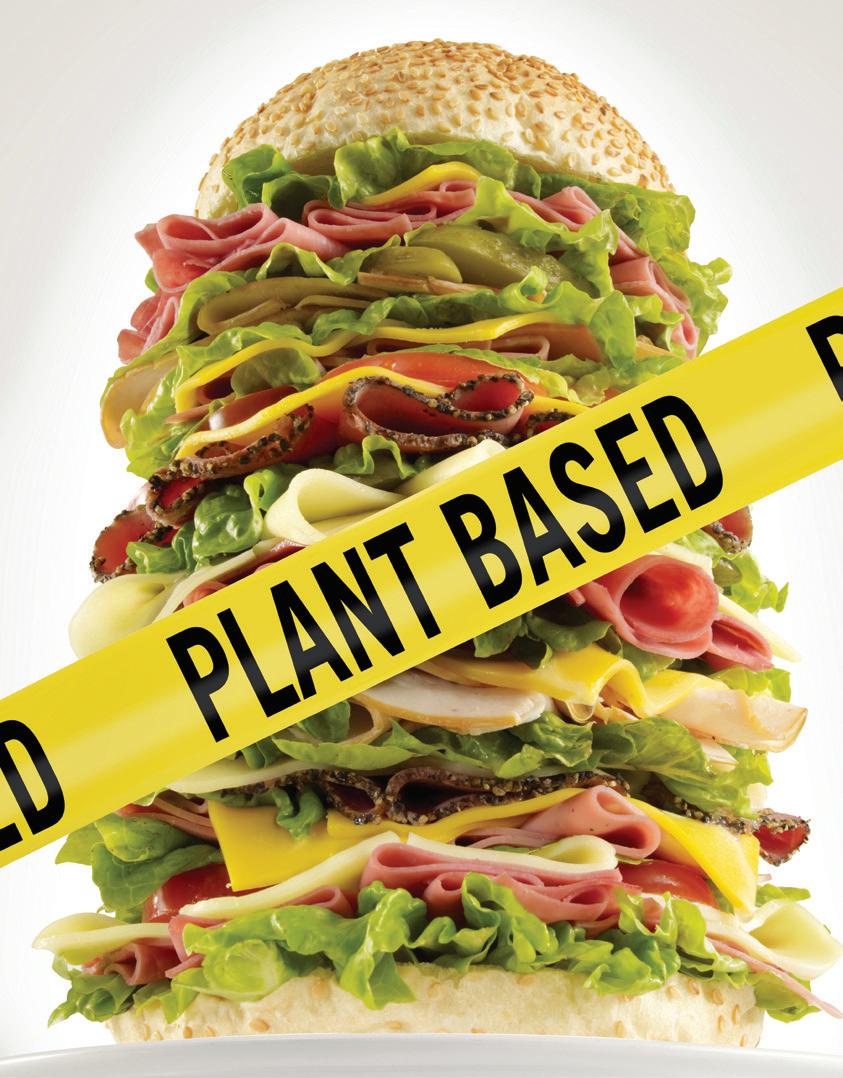
Sensory Profiles and Affordability
ฟุตพรินต์และผลกระทบต่อสิ่งแวดล้อม นอกจากแรงจูงใจด้านจริยธรรมและ สุขภาพแล้ว การพัฒนาทางเลือกทดแทน เนื้อสัตว์ยังมีศักยภาพในการลดผลกระทบ ต่อสิ่งแวดล้อมจากการผลิตเนื้อสัตว์ การ วิจัยเกี่ยวกับเนื้อสัตว์และผลิตภัณฑ์ทดแทน ปราศจากเนื้อสัตว์แสดงให้เห็นว่าผลิตภัณฑ์ ปราศจากเนื้อสัตว์สามารถมอบผลประโยชน์ มากกว่าการผลิตเนื้อวัว การปลดปล่อย แก๊สเรือนกระจก การใช้น้ำาและที่ดินน้อย กว่าการผลิตเนื้อหมูและเนื้อไก่
2022 จาก Boston Consulting Group พบว่าการลงทุนปรับปรุงและขยายการผลิต ทางเลือกทดแทนเนื้อสัตว์และทดแทนนมจะ นำาไปสู่การลดแก๊สเรือนกระจกได้เป็นอย่าง
ข้อมูลจาก The Good Food Institute เสนอว่าการปรับปรุงประสิทธิภาพของอาหาร แบบตะวันตกมีความสำาคัญต่อความยั่งยืน ประชากรโลกที่เพิ่มขึ้นทำาให้ต้องพิจารณา จัดสรรที่ดินใหม่ พื้นที่อาศัยบนโลก 33% ใช้
การเตรียม (22%) นอกจากเหตุผลด้าน สุขภาพแล้ว คนไทย 19% คิดว่าการกิน เนื้อสัตว์น้อยลงจะช่วยปกป้องชีวิตสัตว์ได้
มากขึ้น จากแนวโน้มการบริโภคเนื้อสัตว์
20 www.innolabmagazine.com ทางเลือกทดแทนเนื้อสัตว์ [สมัยใหม่] เนื้อจากพืช (PBMs) เป็นทางเลือก ทดแทนเนื้อสัตว์สำาหรับผู้บริโภคอาหารวี แกนและมังสวิรัติ นอกจากนั้น ยังได้รับ ความนิยมมากขึ้นในกลุ่มผู้บริโภคเนื้อสัตว์ที่ ต้องการลดปริมาณเนื้อสัตว์ด้วยเหตุผลด้าน สุขภาพและสิ่งแวดล้อม ผลิตภัณฑ์ส่วนใหญ่ ทำาจากพืชที่เป็นอาหารปกติอยู่แล้ว เนื้อจาก พืชมักมีส่วนผสม ได้แก่ โปรตีนถั่วหรือถั่ว เหลือง ไขมัน เครื่องปรุงรส และสารยึด เกาะ (binder) บางชนิด ผลิตภัณฑ์อาจ ใช้การปรุงแต่งรสธรรมชาติและ/หรือสาร ปรุงรสสังเคราะห์เพื่อให้ผลิตภัณฑ์มีรสชาติ เหมือนเนื้อสัตว์มากขึ้น ผลิตภัณฑ์เนื้อจาก พืชเป็นหนึ่งในเทรนด์ที่ได้รับความนิยมสูงสุด
การให้ความสำาคัญ ต่อสุขภาพมีแนวโน้มจะกลายเป็นหนึ่งใน ปัจจัยที่มีอิทธิพลมากที่สุดที่ผลักดันยอดขาย เนื้อจากพืช การสำารวจโดย Marketbuzz รายงานว่าคนไทย 2 ใน 3 รู้จักเนื้อสัตว์ ที่ทำาจากพืช แต่มีเพียง 1 ใน 3 เท่านั้นที่ บอกว่าพวกเขามีความรู้เกี่ยวกับผลิตภัณฑ์ ผู้คนรู้สึกว่าเนื้อจากพืชมีคุณค่าทางอาหาร สูงซึ่งเป็นเหตุผลหลักที่พวกเขาเลือกบริโภค (30%) เหตุผลอื่นๆ ได้แก่ ประโยชน์ต่อ สุขภาพ (29%) การรับรู้ว่าทันสมัย (24%) รสชาติที่ดี (23%) และความสะดวกใน
ในช่วงเวลาที่ผ่านมา
ที่ลดลง แบรนด์และผลิตภัณฑ์จำานวนมาก เข้าสู่ตลาดด้วยการนำาเสนออาหารทางเลือก ใหม่ที่ทำาจากพืช ถึงแม้จะเป็นโอกาสสำาหรับ ผู้เล่นในตลาดเนื้อจากพืช แต่การพัฒนา ผลิตภัณฑ์ที่สามารถทดแทนส่วนประกอบ
Author info กองบรรณาธิการนิตยสารอินโนแล็บ INNOLAB team innolab@media-matter.com เนื้อสัตว์ปกติในอาหารไทยได้โดยตรงเป็น สิ่งที่จำาเป็นอย่างยิ่ง ประวัติศาสตร์ของโปรตีนจากพืช เต้าหู้เป็นทางเลือกทดแทนเนื้อสัตว์ชนิดหนึ่งที่ทำาจากถั่วเหลือง คิดค้นขึ้นใน ประเทศจีนโดยราชวงศ์ฮั่น (206 ปีก่อน คริสตกาล - ค.ศ. 220) โดยมีการบันทึก ว่ามีการใช้เต้าหู้แทนเนื้อสัตว์ เต้าหู้เป็น ที่รู้จักกันอย่างแพร่หลายในฐานะ “เนื้อ แกะเล็ก” แสดงให้เห็นว่าชาวจีนโบราณ ให้ความสำ า คัญกับเต้าหู้ในฐานะเป็นเนื้อ เทียม มีการบริโภคเต้าหู้อย่างแพร่หลาย ในสมัยราชวงศ์ถัง (ค.ศ. 618–907) และ น่าจะแพร่กระจายไปยังญี่ปุ่นภายหลังใน ช่วงราชวงศ์ถังหรือต้นราชวงศ์ซ่ง โปรตีน กลูเตนจากข้าวสาลีได้รับการบันทึกไว้ใน ประเทศจีนตั้งแต่ศตวรรษที่หก บะหมี่ที่ทำา จากกลูเตนข้าวสาลีซึ่งเป็นที่รู้จักในชื่อเมี่ยน จินในสมัยราชวงศ์ซ่ง (ค.ศ. 960–1279) ในประเทศตะวันตก มีความสนใจใน อาหารทดแทนเนื้อสัตว์มากขึ้นในช่วงปลาย ศตวรรษที่ 19 และครึ่งแรกของศตวรรษที่ 20 ก่อนปี 1950 ความสนใจผลิตภัณฑ์เนื้อ จากพืชมาจากผู้บริโภคอาหารมังสวิรัติที่ ค้นหาทางเลือกอื่นแทนโปรตีนจากเนื้อสัตว์ ด้วยเหตุผลด้านจริยธรรม และผู้กินเนื้อ สัตว์เป็นประจำาที่ต้องเผชิญกับปัญหาการ ขาดแคลนอาหารในช่วงสงครามโลกครั้ง ที่ 1 และสงครามโลกครั้งที่ 2 ในปี 1943 Kellogg ได้นำาเสนอผลิตภัณฑ์เนื้อเทียมที่ ใช้ถั่วเหลืองเป็นส่วนประกอบชนิดแรก ใน ชื่อ Soy Protose ซึ่งมีส่วนประกอบของ ถั่วเหลือง 32%
รายงานปี
มากเมื่อเทียบกับการลงทุนอื่นๆ
RESEARCH & DEVELOPMENT
[Modern] meat alternatives
Plant-based meats (PBMs) are meat-alternative options for vegans and vegetarians. It is also increasingly popular with omnivores looking to cut back on meat for health and environmental reasons. They are mostly made from plants that are already regular diets. Most PMBs are made from pea or soy protein, a type of fat, seasoning, and some sort of binder. They may also contain natural and artificial flavors to make the product taste more like meat. This is one of the biggest trends in recent times and health-related priorities are likely to become one of the most influential factors driving plant-based meat sales. A survey by Marketbuzz shows that while two-thirds of Thais are aware of plant-based meat, just over onethird claim they are knowledgeable about the product.

People feel plant-based meat contains high nutritional value, which is a main reason why they eat it (30%). Other reasons include health benefits (29%), as well as the perception of being trendy (24%), good taste (23%) and ease of preparation (22%). In addition to health-related reasons, 19% of Thais also think eating less meat helps protect more animals’ lives. Given the trend towards reducing meat consumption, many brands and products have entered the market with new plant-based options. There are opportunities for players in the plant-based meat market, but it is critical that they develop products that can directly replace normal meat components in Thai dishes.
History of plant proteins
Tofu, a meat alternative made from soybeans, was invented in China by the Han dynasty (206 BC–220
CE). Its use as a meat alternative is recorded in a document. Tofu was popularly known as “small mutton”, which shows that the Chinese valued tofu as an imitation meat. Tofu was widely consumed during the Tang dynasty (618–907), and likely spread to Japan during the later Tang or early Song dynasty. Wheat gluten has been documented in China since the sixth century. Noodles prepared from wheat gluten which was known as mian jin by the Song dynasty (960–1279).
In the west, there was an increased interest in meat substitutes during the late 19th century and first half of the 20th century. Prior to 1950, interest in plant-based meats came from vegetarians searching for alternatives to meat protein for ethical reasons, and regular meat-eaters who were confronted with food shortages during World War I and World War II. In 1943, Kellogg made his first soy-based meat analog, called Soy Protose, which contained 32% soy.
Footprint and environmental effects
Besides ethical and health motivations, developing better meat alternatives has the potential to reduce the environmental impact of meat production. Research on meats and no-meat substitutes suggests that no-meat products can offer substantial benefits over the production of beef, and to a lesser extent pork and chicken, in terms of greenhouse gas production, water and land use. A 2022 report from the Boston Consulting Group found that investment in improving and scaling up the production of meat and dairy alternatives leads to big greenhouse gas reductions compared with other investments.
According to The Good Food Institute, improving efficiency of the western diet is crucial for achieving sustainability. As the global population grows, the way land is used will be reconsidered. 33% of the habitable land on Earth is used to support animals. Of all the land used for agriculture, 77% is used on animal agriculture even though this sector only supplies 17% of the total food supply. Plant-based meat can use a potential 47–99% less land than conventional meat does, freeing up more opportunities for production. Of the total water used in global agriculture, 33% goes to animal agriculture while it could be used for drinking water or other growing purposes. Plant-based meat uses 72–99% less water than conventional meat production.
Pesticides used in animal feed production as well as waste runoff into reservoirs can cause ecological damage and even human illness as well as taking water directly out of the usable supply. Animal agriculture is the main contributor to the food sector greenhouse gas emissions. Production of plant-based meat
22 www.innolabmagazine.com
alternatives emits 30–90% less than conventional meat production. While also contributing less to this total pollution, much of the land being used for animal feed could be used to mitigate the negative effects through carbon recycling, soil conservation, and renewable energy production. Excess antibiotics given to animals cause resistant microbes that may render some of the life-saving drugs used in human medicine useless. Plantbased meat requires no antibiotics and would greatly reduce microbe antibiotic resistance.
The healthier option?
Scientific research has linked frequent consumption of red meat to heart disease and cancer. Beyond Meat’s website claims that animalbased meats lead to a 16% increased risk of cancer and 21% increased risk of heart disease. In theory, then, eating plant-based imitations of red meat is healthier.
Meatless burgers are a step in the right direction. For consumers who are just starting to cut out meat, options that taste familiar can make the transition easier. Eating more plant is beneficial but they are not necessarily healthier than beef burgers. The amounts of sodium and saturated fat in plant-based burgers is roughly the same as that in a traditional beef burger. Public perception that plant burgers are healthier than red meat options can lead to a “health halo” around them. As a result, consumers may over-indulge after eating a plantbased burger.
Processed ingredients
PBMs have found fans because they taste more like beef than traditional veggie burgers. To mimic red meat’s taste and texture, these burgers contain
a mix of plant-based proteins, oils, and other ingredients. Because they are processed foods, they are still put in the “indulgence category.” Processed soy is controversial because it strips out some of the key nutrients found in traditional soy foods like tofu and can contain unhealthy compounds. Heme from soy plants (soy leghemoglobin) for a meaty taste and realistic juices, as well as soy protein concentrate.
Availability and affordability
According to A Marketbuzz’s survey, the most significant barriers to increasing plant-based consumption are the difficulty in finding stores that sell the products (35%) and high prices (34%). Considering the expected uptick in demand, brands and retailers will have to look at increasing distribution to ensure plant-based products are easy to find and available. Marketing is also critical to promote the range of plant-based dishes as tasty and healthy alternatives. Despite the higher price of alternative protein sources, consumers are willing to pay more due to the health benefits. Increasing brand awareness and retailer visibility for plant-based products with the right price point will underpin growth as the popularity of plant based alternatives continues to gather momentum.
Sensory profile = Success key
Does a PBM product give the similar tastes to genuine meat? The answer to date is NO. Anyway, PBMs, especially burgers, are a convincing animal protein substitute. It certainly can vary from brand to brand. The typical complaint about PBMs is that they tend to be drier than the real meat. Visually, it can be hard to differentiate
them from meat, as they brown and char similarly. While some vegans and vegetarians prefer to consume less processed alternatives to meat, such as tofu, others find the similar texture and taste to real meat to be a helpful way to incorporate protein into their diets without consuming animals.
Sensory evaluation plays multiple roles in predicting consumer acceptance of meat alternatives as this is not only influenced by the product’s sensory characteristics but also by personrelated factors. These depend on the ethical aspects, political values, and ecological welfare involved in the production and can act as either drivers or barriers to acceptance of meat alternatives. The unfamiliarity with novel foods can alter expectations that may negatively impact sensory perception and overall liking. To reduce consumer uncertainty to meat alternatives, these are often marketed with slogans such as “tastes like meat” so that consumers can relate to their previous experience and form favorable expectations on the product’s performance.
Sensory evaluation methods can gather data regarding consumers’ perceptions beyond the oral perception of foods. It is important to identify which product characteristics are drivers of product liking, while also taking into consideration differences between person-related factors. Integrating data of this kind with results from sensory evaluation and instrumental measurements provide a more accurate description of the physiochemical and sensory properties of meat alternatives.
23 Jul-Aug
In the early days, scientists believed that continuous feeding would allow microorganisms to live forever, as the same with all organisms. The problem was microbial mutations found after long periods of continuous feeding. Mutation affects research or industrial production such as reduced productivity or maintaining of quality.
The study found that microbial cells are mostly composed of water, which is 70-80%. Water is a crucial factor in chemical reactions, producing energy, proteins, and other necessary substances for growth or cell division. Preserving microorganisms to maintain genetic traits is a way to stop growing but keep viability (alive). It is based on the principle that water is the important growth factor. Therefore, all preserving methods in laboratory are based on decrease of metabolic activity or complete cessation of all cellular chemical reactions. This can be achieved by reducing temperature and/or water activity. Either rate of metabolic reactions or states of molecular complexes strictly depend on temperature and water activity. Significant changes in temperature and/or water activity cause structural and functional changes in cells. Such change affects viability or causes mutation. In conclusion, when microorganisms were preserved in the laboratory using techniques that temperature and/or water activity are decreased. Cells may be partially damaged or dead.
Microbial cells of different groups and species are differently susceptible to temperature and/or water activity drops. Furthermore, this susceptibility depends on growth conditions. It depends on medium and growth stage. Being said that a single living cell is enough to sustain culture is generally not true. Microbial population in samples are different. It contains dominant cells that represent main characteristics of bacteria, and several subpopulations
is different to the dominant cells at phenotypic and genotypic levels. Preserving microorganisms under certain conditions may be selective, providing favorable conditions to sustain subpopulations.
Therefore, choices or development of a specific technique for preservation of microorganisms should be aimed to optimize process conditions. Firstly, it is the highest possible viability rate of preserved population which is defined as the relative proportion of living cells. Secondly, it is the minimum “genetic variation” or low level of mutation.
For most people working on microbial cultures in laboratories, especially for beginners, the challenge is how to keep microorganisms viable in all cases. To answer this question, principal understanding of preserving viable microorganisms in laboratories is required. This makes possibility to select or develop necessary techniques in each case appropriately.
You can read full version of “Reference Cultures: Preservation and Application”. Scan to get a copy!

Brief principle of microbial preservation in laboratory starts with obtaining a strain of microorganisms from a reliable culture collection. A strain may be isolated oneself or genetically modified obtained from a reliable source. In any case, capability to preserve viability of microorganisms at least for a period is an essential skill to achieve successful work. However, there is no universal method to preserve any microbial cells from all taxonomic groups. The first reason is the specific properties of microorganisms. Secondly, different requirements are employed to different collection periods. And the third is laboratory technical capacity.
There are many methods of preserving microorganisms, so the appropriate method shall be opted for each type of microorganism. There are currently hundreds of techniques for culture preservation in laboratories. Development of these techniques is based on fundamental
or click this link, https://forms.gle/2rByaVkbEWeQH4NZ9
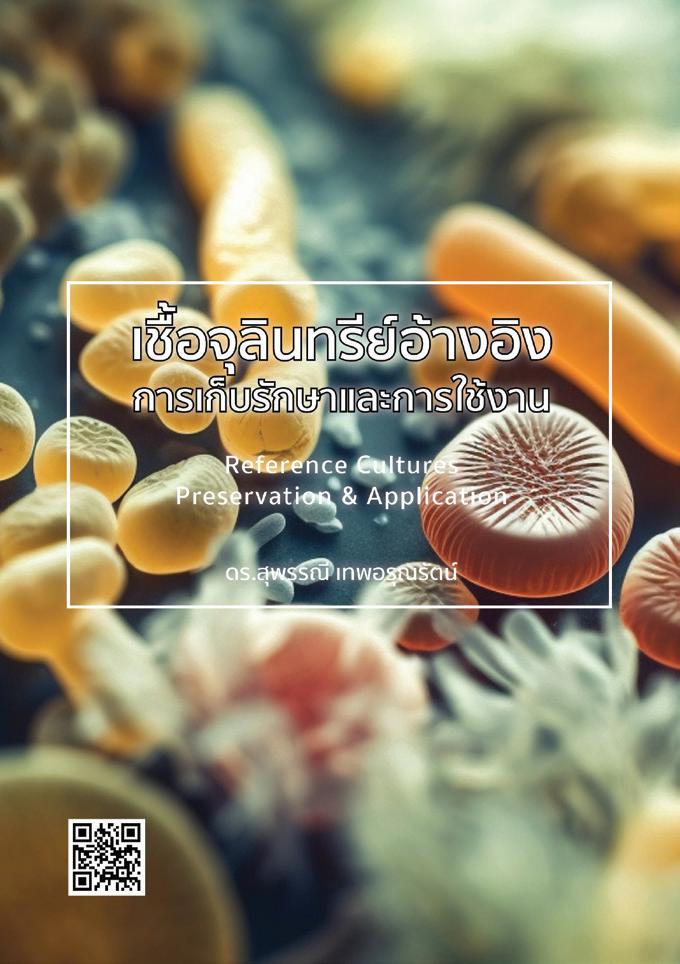
26 www.innolabmagazine.com
research in cryobiology related to microorganisms. The development particularly focuses on long-term preservation of viable microorganisms for biotechnological probiotics and starter cultures for various industries.
Which strains should be preserved?
Microbiology laboratories need different microorganisms based on their field. Considering strains to preserve depends on their applications, for examples:
• Researchers and students may require cultures with specific characteristics. Microorganisms may be obtained by isolation from natural sources or mutant variants. When a microorganism as described in research literatures is required, these should be obtained from literature’s publisher or a culture collection facility. Generally, researchers or research institutes collect microorganisms for a certain period. In case of potential microorganisms with outstanding properties, it may be preserved for a long time.
• Quality control of microbiological test results is conducted by using reference microorganisms as specified in test methods. References are used as positive control and negative control, or testing strains in tests such as antibiotics, vitamin B12. Some product standards, such as disinfectants, specific microbial strains are mandated in test methods.
• Quality control of culture media as specified in the manufacturer’s documentation or in accordance with ISO 11133.
• Food, pharmaceutical, medical, cosmeceuticals, and other industries that employ microorganisms in production processes preserve microorganisms as starter cultures.
Sources/origins of reference microorganisms
• Culture collection centers which are recognized by the World Federation for Culture Collections (WFCC).
• Variants obtained from a laboratory proficiency test (PT) with a government organization or a reliable organization.
• Distribution companies of reference microorganisms (ATCC distributor).
• Wild strains or variants detected in the laboratory which have been verified for their properties and interactions.
Capabilities of the Culture Collection Center
1. Collect microorganisms, enhance viability with intact characteristics, and prevent losses or elimination.
2. Collect microbial data by encrypted computer program to maintain and protect non-disclosure information.
3. Issue certification of microbial collection to depositors to present to the Department of Intellectual Property if there is a regulation.
4. Provide and prepare microorganisms for research and examination purposes, promptly upon inquiries.
5. Examine and classify microorganisms with modern techniques and methods.
6. Provide advice and suggestions on preservation and classification of microorganisms including microbial exchange between international organizations.
Culture collection centers There are currently more than 520 culture collection centers worldwide, collecting more than 1.7 million organisms and strains. They have been registered with the World Data Center for Microorganisms.
There are many centers involved in the bio-industry, microbiology laboratories, research, and higher education institutions.
International culture collection centers
• American Type Culture Collection (ATCC)
• Common Access to Biological Resources and Information (CABI)
• Belgian Co-ordinated Collections of Microorganisms
• Japan Collection of Microorganisms (JCM)
• United Kingdom National Culture Collection (UKNCC)
• World Data Centre for Microorganisms (WDCM)
• German Collection of Microorganisms and Cell Cultures (DSMZ)
National culture collection centers
• The Thailand Institute of Scientific and Technological Research (TISTR) Culture Collection / Bangkok MIRCEN collects about 5,000 strains that are important in industry and environment.
• The Department of Medical Sciences (DMST) Culture Collection collects approximately 10,000 strains of human pathogenic microorganisms.
• The Thailand Bioresource Research Center (TBRC) & BIOTEC Culture Collection (BCC) of the National Center for Genetic Engineering and Technology collects approximately 20,000 strains of molds and yeasts using in research.
• The Plant Pathogen Collection Center, Microbiology and Plant Pathology Section, The Department of Agriculture (DOAC) collects approximately 2,000 strains of important agricultural microorganisms.
27 Jul-Aug
(precision) เป็นค่าที่แสดงถึงความสามารถของเครื่อง มือวัดในการแสดงค่าเดิมเมื่อทำาการวัดหลายๆ ครั้ง เมื่อคุณทำาการทดสอบทางด้านห้องการควบคุมคุณภาพทางจุลชีววิทยา คุณต้องการที่จะได้ผลลัพธ์ที่มีความถูกต้องแม่นยำาและความเที่ยงตรง ซึ่งนั่นจะการันตีได้ว่าผลการทดสอบของคุณตรงตาม
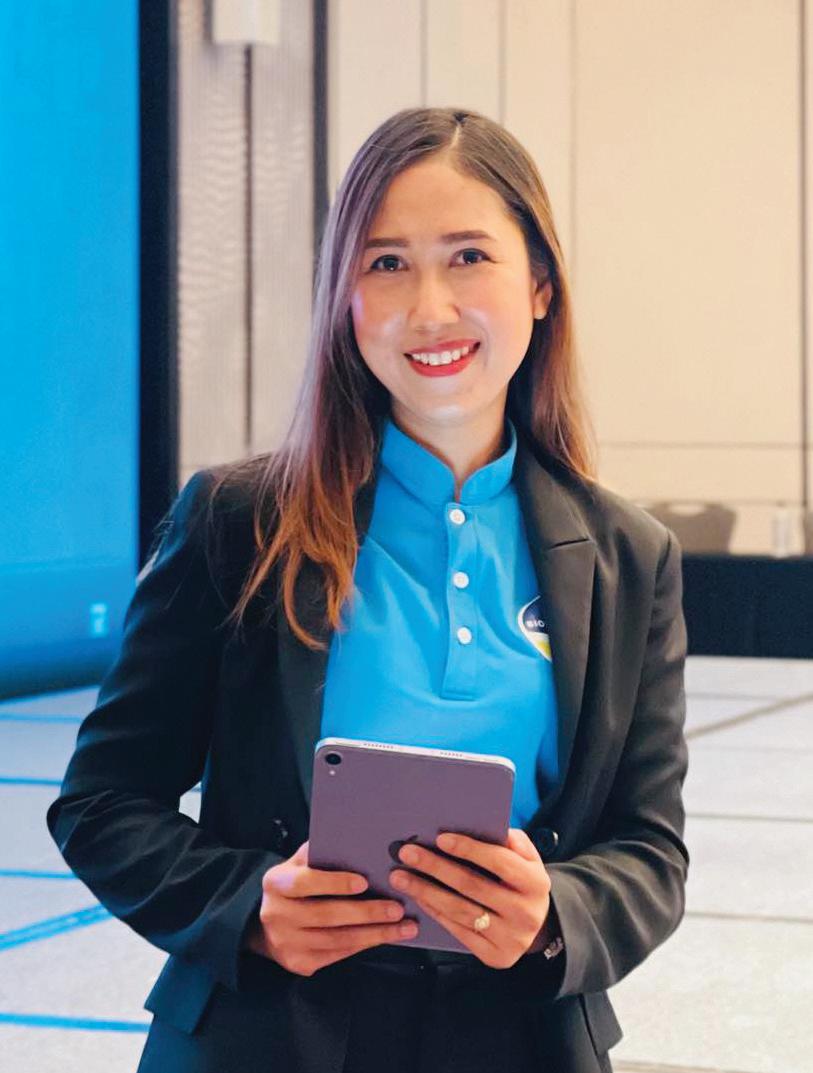
วิเคราะห์แบบเทคนิคโฟลไซโทเมทรี (flow cytometry)
(accurate)
BIOBALL® แตกต่างจากผลิตภัณฑ์เชื้อ
พร้อมใช้งานได้ทันทีหลังจากที่มีการเก็บ
รอเวลาการปรับสภาพหรือให้ความร้อนกับ สารละลาย (rehydration)
4.
28 www.innolabmagazine.com Take Control of Your Microbiological Quality Control Author info วิจิตรา อยู่กล่ำา Wijitra Yooglam Assistant Manager, Business Development Analysis, Microbiological DKSH Technology wijitra.wy@dksh.com +668 8089 2039 TESTING & ANALYSIS ความถูกต้องแม่นยำาและความเที่ยง ตรงแบบที่ไม่เคยมีมาก่อน BIOBALL® คือ เชื้อจุลินทรีย์อ้างอิง มาตรฐาน (standardized strains) ที่ ทราบปริมาณของเชื้อจุลินทรีย์ที่มีชีวิต แน่นอน พร้อมใช้งาน โดยมีลักษณะเป็น ลูกบอลขนาดเล็กที่ละลายน้ำาได้ ซึ่งบอล จะบรรจุด้วยจุลินทรีย์ที่ทราบจำานวน มอบ ความถูกต้องอย่างไม่เคยมีมาก่อน เพื่อใช้
เชิงปริมาณในอุตสาหกรรมการทดสอบ ยา เครื่องสำาอาง อาหาร และน้ำา โดย bioMerieux ใช้เทคโนโลยีและเทคนิคที่เป็น กรรมสิทธิ์ในการผลิตผลิตภัณฑ์ BIOBALL® เพื่อได้ความแม่นยำาและศักยภาพสูงสุดอย่าง ที่ไม่เคยมีมาก่อน กระบวนการผลิตมีการใช้เครื่องมือ
หลักการทำางานของเครื่อง คือ ของเหลวการเตรียมเชื้อจุลินทรีย์ในรูปแบบ จากนั้นนำาเข้าเครื่องเพื่อทำาให้ เซลล์ไหลผ่านระบบการตรวจวัดทีละเซลล์ เครื่องจะทำ า การคัดเลือกเฉพาะเซลล์ที่มี ชีวิตเท่านั้น ซึ่งการคัดเลือกทีละเซลล์เพื่อ ให้จุลินทรีย์มีอัตราการเจริญ (recovery) สูงสุดในอาหารเลี้ยงเชื้อแบบไม่จำ า เพาะ (non-selective) เทคโนโลยีนี้สามารถ แยกความแตกต่างระหว่างเซลล์เดี่ยวและ กลุ่มเซลล์ของจุลินทรีย์ที่เพาะขึ้นได้ เช่น Staphylococcus aureus เป็นต้น จากนั้น หยดของเหลวมีจำานวนเชื้อจุลินทรีย์ที่แน่นอน นั้นจะเข้าสู่กระบวนการแช่แข็งอย่างรวดเร็ว (มีลักษณะคล้ายลูกบอล) และบรรจุในขวด ขนาดเล็ก และปิดผนึกภายใต้สุญญากาศ เพื่อยืดอายุการเก็บรักษาและควบคุมการ เจริญได้อย่างมีประสิทธิภาพสูงสุด เพื่อให้มั่นใจว่าการทดสอบความใช้ได้ ของวิธีการทดสอบ (validation) และการ ทดสอบการสนับสนุนการเจริญ (growth promotion) ของคุณให้ผลลัพธ์ที่ถูกต้องทุก ครั้ง ผลิตภัณฑ์ BIOBALL® SINGLESHOT และ BIOBALL® MULTISHOT จะให้จำานวน Colony Forming Unit (CFU) ที่มีค่า เท่ากันทุกๆ ครั้งการทดสอบ • เทคโนโลยีการผลิตที่มีสิทธิบัตรมอบ ความถูกต้องอย่างที่ไม่เคยมีมาก่อนในการ ควบคุมคุณภาพทางจุลชีววิทยาเชิงปริมาณ • มอบความแม่นยำามากขึ้นด้วยจำานวน จุลินทรีย์ในบอลที่เชื่อถือได้ • แต่ละรอบของการทดสอบจะได้ จำานวนเชื้อจุลินทรีย์ที่เท่ากัน และมีความ “ความถูกต้องแม่นยำาและความเที่ยงตรง” แม้ว่าคำาสองคำานี้มักถูกใช้แทนที่กันได้ แต่ ในทางวิทยาศาสตร์ ความถูกต้อง ความแม่นยำา และความเที่ยงตรง มีความหมาย ที่แตกต่างกัน ซึ่งจะขยายความได้ดังนี้ หากเป็นผลการทดสอบที่ได้ค่าใกล้เคียงกับ สม่ำาเสมอ จะช่วยลดความเสี่ยงของการ เตรียมเชื้อจุลินทรีย์เองได้ สี่ขั้นตอนง่ายๆ ในการปรับปรุงการ ควบคุมคุณภาพ
จุลินทรีย์อ้างอิงมาตรฐานอื่นๆ
รักษาในตู้แช่แข็ง
สำาหรับการควบคุมคุณภาพทางจุลชีววิทยา
เนื่องจาก
ดังนั้นจึงไม่จำาเป็นต้อง
ของสาร lyo-protectant ที่เป็นเอกสิทธิ์
ถูกน้ำา หรือสารละลาย ดังนั้นจะช่วยลด เวลาในขั้นตอนการเตรียมเชื้อจุลินทรีย์ และ ช่วยเพิ่มประสิทธิภาพของห้องปฏิบัติการ ขั้นตอนโดยสรุป
การเท BIOBALL® ลงจานอาหาร เพาะเชื้อ 2. ละลาย BIOBALL® ด้วยน้ำา หรือ สารละลาย
Spread plate รอให้แห้ง และ นำาเข้าบ่ม
ซึ่งคุณสมบัติ
เฉพาะใน BIOBALL® จะละลายทันทีเมื่อ
1.
3.
นับจำานวนโคโลนี ค่าจริงเรียกว่าความถูกต้องแม่นยำา
ส่วนความเที่ยงตรง
วัตถุประสงค์ และสามารถทำาซ้ำาได้ทุกเวลา
และความเที่ยงตรงในการควบคุมคุณภาพ ทางจุลชีววิทยาเชิงปริมาณ
• ทดสอบได้ทันที ตลอดเวลา ไม่จำาเป็น ต้องรอเวลาการปรับสภาพ
• ผลิตภัณฑ์ BIOBALL® MULTISHOT มีความคงตัวได้ถึง 14 วัน
• มีจุลินทรีย์สายพันธุ์หลักในเภสัชตา
• มีสายพันธุ์ที่แยกได้จากพืชในรูปแบบ BIOBALL®
BIOBALL ® มีประสิทธิภาพในการ

• การทดสอบการสนับสนุนการเจริญ
• การทดสอบความใช้ได้ของวิธีการ ทดสอบ
• การทดสอบประสิทธิภาพของสาร
® MULTISHOT 550
® MULTISHOT 550 ใช้
ภายในระยะเวลาสองสัปดาห์
ข้อได้เปรียบของ BIOBALL® MULTISHOT 550 ที่เหนือกว่าผลิตภัณฑ์ชนิดอื่นๆ
• อายุการเก็บรักษานานขึ้นเป็น 14 วัน หลังจากทำาละลาย
ความสมบูรณ์ของข้อมูลเริ่มต้นด้วย ขั้นตอนการทดสอบที่มีความน่าเชื่อ ถือและทำาซ้ำาได้ จำานวนที่แม่นยำาของเซลล์ที่มีชีวิตภายใน
เบี่ยงเบนมาตรฐานที่ลดลง และเพิ่มอัตรา การเจริญของเชื้อที่สูงขึ้น เมื่อเทียบกับการ เจือจางแบบอนุกรม (serial dilution) ดัง นั้นจะช่วยปรับปรุงทั้งความถูกต้องแม่นยำา
BIOBALL® แต่ละบอล ส่งผลให้เกิดค่า
รับทุกสายพันธุ์
ทดสอบที่หลากหลาย รวมถึง:
(คุณสมบัติของสารอาหาร)
ปฏิชีวนะ/สารกันเสีย
• การทดสอบความชำานาญ ชนิดของ BIOBALL® แบ่งตามปริมาณเชื้อจุลินทรีย์ได้หลายรูปแบบ BIOBALL
ร่วมกับสารละลายชนิด
ออกแบบมาเพื่อการแบ่งใช้งานถึง 10 ครั้ง: • มีปริมาณเชื้อจุลินทรีย์ภายในเฉลี่ย อยู่ที่ 500-600 CFU • มีค่าเบี่ยงเบนมาตรฐานน้อยกว่า หรือเท่ากับ 10% ของค่าเฉลี่ยในแต่ละ ล็อตการผลิต • เมื่อทำ า ละลายด้วย BIOBALL ® Re-Hydration Fluid (1.1 มิลลิลิตร) BIOBALL ® สามารถแบ่งใช้งานได้ 10 ครั้ง ครั้งละ 100 ไมโครลิตร โดยแต่ละ ครั้งจะมีปริมาณเชื้อจุลินทรีย์ 50-60 CFU • มีปริมาณการคงตัวของเชื้อจุลินทรีย์ ที่ 8 ชั่วโมง เมื่อเก็บรักษาไว้ที่อุณหภูมิ 2-8 องศาเซลเซียส • เหมาะกับการทดสอบหลายๆ ครั้ง ในระยะเวลาเดียวกัน เช่น การทดสอบ การสนับสนุนการเจริญของอาหารเลี้ยงเชื้อ ข้อได้เปรียบของ BIOBALL® ที่เหนือ กว่าผลิตภัณฑ์ชนิดอื่นๆ • ใช้เวลาเตรียมน้อยและลดขั้นตอน การทำางาน • ให้ผลการเจริญที่ดีเยี่ยมแม้เป็น จุลินทรีย์ที่เลี้ยงยาก เช่น Pseudomonas aeruginosa • อายุการเก็บรักษานานถึง 8 ชั่วโมง หลังจากละลาย • ปริมาณ CFU ที่ได้มีความถูกต้อง แม่นยำาและเที่ยงตรง • จำานวน CFU ที่สม่ำาเสมอทุกล็อต การผลิต • ลดความเสี่ยงต่อ “การควบคุมคุณภาพ ที่ล้มเหลว” เนื่องจากความแปรปรวนของ จุลินทรีย์ BIOBALL® MULTISHOT 550 ใช้ร่วม กับสารละลายชนิด BIOBALL® 14 Day Re-Hydration Fluid เพื่อความสะดวกและมีประสิทธิภาพมาก ขึ้น เมื่อมีการทดสอบเชิงปริมาณจำานวน น้อยเป็นประจำาทุกวัน: • มีปริมาณเชื้อจุลินทรีย์ภายในเฉลี่ย อยู่ที่ 500-600 CFU • มีค่าเบี่ยงเบนมาตรฐานน้อยกว่า หรือเท่ากับ 10% ของค่าเฉลี่ยในแต่ละ ล็อตการผลิต • เมื่อทำาละลายด้วย BIOBALL® 14 Day Re-Hydration Fluid (1.1 มิลลิลิตร) BIOBALL® สามารถแบ่งใช้งานได้ 10 ครั้ง ครั้งละ 100 ไมโครลิตร โดยแต่ละครั้งจะ มีปริมาณเชื้อจุลินทรีย์ 50-60 CFU • มีปริมาณการคงตัวของเชื้อจุลินทรีย์ ที่ 14 วัน เมื่อใช้ร่วมกับ BIOBALL® 14 Day Re-Hydration Fluid เมื่อเก็บรักษา ไว้ที่อุณหภูมิ -18 ถึง -33 องศาเซลเซียส • เหมาะสมอย่างยิ่งเมื่อต้องทำาการ ควบคุมคุณภาพหลายรายการพร้อมกันหรือ
• การทดสอบความปราศจากเชื้อ
BIOBALL
BIOBALL® ReHydration Fluid
• ใช้เวลาเตรียมน้อยและลดขั้นตอน การทำางาน
จุลินทรีย์ที่เลี้ยงยาก เช่น Pseudomonas aeruginosa
ปริมาณ CFU ที่ได้มีความถูกต้อง แม่นยำาและเที่ยงตรง • จำานวน CFU ที่สม่ำาเสมอทุกล็อต การผลิต • ลดความเสี่ยงต่อ “การควบคุมคุณภาพ ที่ล้มเหลว” เนื่องจากความแปรปรวนของ จุลินทรีย์
• ให้ผลการเจริญที่ดีเยี่ยมแม้เป็น
•
BIOBALL ® SINGLESHOT ออกแบบมาสำ า หรับการทดสอบแบบ
• ค่าเฉลี่ยจำานวนจุลินทรีย์ใน
BIOBALL
•
• BIOBALL® SINGLESHOT เหมาะ สมอย่างยิ่งกับการเพาะเชื้อจุลินทรีย์เพียง หนึ่งหรือสองสามครั้งภายในหนึ่งวัน หรือ ต้องการความแม่นยำาในระดับสูงสุด ข้อได้เปรียบของ BIOBALL® SINGLESHOT
• ใช้เวลาเตรียมน้อยหรือไม่ต้องเตรี
BIOBALL ® MULTISHOT - 10E8
MULTISHOT 10E8 แต่ละล็อตมีค่าเฉลี่ย
0.7 ถึง 1.5 x 108 CFU
เท่ากับ 20% ของค่าเฉลี่ย
• เมื่อทำ า ละลายด้วย BIOBALL ®
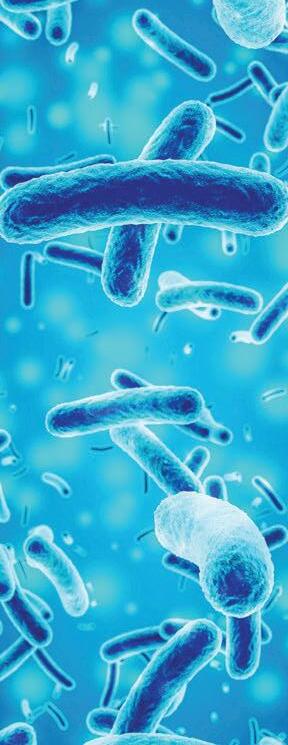
Re-Hydration Fluid (1.1 มิลลิลิตร)
BIOBALL® สามารถแบ่งใช้งานได้ 10 ครั้ง
ครั้งละ 100 ไมโครลิตร โดยแต่ละครั้งจะ
107 CFU
• มีปริมาณการคงตัวของเชื้อจุลินทรีย์ ที่ 2 ชั่วโมง เมื่อเก็บรักษาไว้ที่อุณหภูมิ 2-8 องศาเซลเซียส
BIOBALL® ด้วย การรับรองมาตรฐาน ISO 17034:2016 หมายความว่าลูกค้าที่มีการใช้งาน BIOBALL® สามารถเชื่อมั่นได้ว่าเอกสารที่ให้การรับรอง เกี่ยวกับผลิตภัณฑ์มีความน่าเชื่อถือ (เอกสาร ข้อมูลผลิตภัณฑ์และ/หรือใบรับรองการ วิเคราะห์) และการตรวจสอบย้อนกลับสาย พันธุ์จุลินทรีย์ที่ใช้ใน BIOBALL® ได้รับการรับรองมาตรฐานโดย NATA ซึ่งเป็นผู้ให้บริการที่รับรองสำาหรับห้องปฏิบัติ การและสถานที่ทดสอบลักษณะเดียวกับที่ รับประกันโดยรัฐบาลของออสเตรเลีย
30 www.innolabmagazine.com
ครั้งเดียว:
® แต่ละลูกมีค่าเฉลี่ย 28-33 CFU
ค่าเบี่ยงเบนมาตรฐานประมาณ 3 CFU หรือน้อยกว่า (เว้นแต่ระบุไว้เป็นอย่างอื่น)
ที่เหนือกว่าการเจือจางแบบอนุกรม
ยมเลย • ง่ายต่อการใช้งาน • ปริมาณ CFU ที่ได้มีความถูกต้อง แม่นยำาและเที่ยงตรง • จำานวน CFU ที่สม่ำาเสมอทุกล็อต การผลิต • ลดความเสี่ยงต่อ “การควบคุมคุณภาพ ที่ล้มเหลว” เนื่องจากความแปรปรวนของ จุลินทรีย์
ออกแบบมาเพื่อการแบ่งใช้งานถึง 10 ครั้ง: • ค่าเฉลี่ยจำานวนจุลินทรีย์ใน BIOBALL®
• ส่วนเบี่ยงเบนมาตรฐานน้อยกว่าหรือ
มีปริมาณเชื้อจุลินทรีย์
• ปริมาตร 100 ไมโครลิตร สามารถ เติมลงในตัวอย่างผลิตภัณฑ์ปริมาตร 20 มิลลิลิตร เมื่อต้องการความเข้มข้นของ จุลินทรีย์สุดท้ายในผลิตภัณฑ์ที่ 105-10 6 CFU/มิลลิลิตร ข้อได้เปรียบของ BIOBALL® MULTISHOT 10E8 ที่เหนือกว่าการเจือจางแบบอนุกรม • ใช้เวลาเตรียมและลดขั้นตอนการ ทำางาน • ให้ผลการเจริญที่ดีเยี่ยมแม้เป็น จุลินทรีย์ที่เลี้ยงยาก เช่น Pseudomonas aeruginosa • อายุการเก็บรักษานานถึง 2 ชั่วโมง หลังจากละลาย • ปริมาณ CFU ที่ได้มีความถูกต้อง แม่นยำาและเที่ยงตรง • จำานวน CFU ที่สม่ำาเสมอทุกล็อต การผลิต • ลดความเสี่ยงต่อ “การควบคุมคุณภาพ ที่ล้มเหลว” เนื่องจากความแปรปรวนของ จุลินทรีย์ BIOBALL ® HIGHDOSE - 10K ออกแบบมาสำ า หรับการทดสอบแบบ ครั้งเดียว: • ค่าเฉลี่ยจำานวนจุลินทรีย์ใน BIOBALL® แต่ละลูกมีค่าเฉลี่ย 8,000 ถึง 12,000 CFU • ค่าเบี่ยงเบนมาตรฐานน้อยกว่าหรือ เท่ากับ 15% ของค่าเฉลี่ย • เหมาะสำาหรับการทดสอบที่ต้องการ ปริมาณเชื้อที่สูงขึ้นและมีความแม่นยำาใน ครั้งเดียวที่ เช่นการควบคุมบวก ข้อได้เปรียบของ BIOBALL® HIGHDOSE 10K ที่เหนือกว่าการเจือจางแบบอนุกรม • ใช้เวลาเตรียมน้อยหรือไม่ต้อง เตรียมเลย • ง่ายต่อการใช้งาน • ปริมาณ CFU ที่ได้มีความถูกต้อง แม่นยำาและเที่ยงตรง • จำานวน CFU ที่สม่ำาเสมอทุกล็อต การผลิต • ลดความเสี่ยงต่อ “การควบคุมคุณภาพ ที่ล้มเหลว” เนื่องจากความแปรปรวนของ จุลินทรีย์ คุณภาพของ BIOBALL® BIOBALL ® มีกระบวนการผลิตด้วย มาตรฐานที่มีคุณภาพสูงสุดระดับโลก โรงงานการผลิตได้รับการรับรองมาตรฐาน ISO 17034:2016 ซึ่งเป็นมาตรฐานสำาหรับ ผู้ผลิตวัสดุอ้างอิงมาตรฐาน โรงงานผลิต BIOBALL® จัดเป็นสถาน ที่ผลิตวัสดุอ้างอิงมาตรฐานบริษัทแรกของ โลกที่ได้รับการรับรองการผลิตวัสดุอ้างอิง มาตรฐานทางจุลชีววิทยาสำาหรับเชิงปริมาณ รวมถึงผลิตภัณฑ์
“Accuracy and precision” - while the two words are often used interchangeably, accuracy and precision are two separate concepts in the scientific sense. Measurements close to a known value are accurate, whereas measurements close to each other are precise. When it comes to microbiological quality control, you need both—accurate results mean your tests are on target, and precise results mean they’re repeatable every time.
BIOBALL® delivers unprecedented accuracy and precision, batch after batch.
BIOBALL® is a small watersoluble ball containing a precise number of micro-organisms delivering unprecedented accuracy for quantitative microbiological quality control with application in the pharmaceutical, food and water testing industries. bioMérieux uses patented technology and proprietary techniques to manufacture BIOBALL® products for unprecedented precision and maximum viability.
A flow cytometer is used to select and dispense individual cells within a culture and count them into a single droplet. Each droplet therefore contains a precise number of viable cells that have been individually selected for maximum recovery rate on non-selective media. This technology is capable of distinguishing between single cells and cell clusters in cultures such as Staphylococcus aureus. Droplets are frozen in liquid nitrogen, dispensed in vials, freezedried, and sealed under vacuum for maximum shelf-life and recovery.
To ensure your method validation and growth promotion tests produce the correct results every time, BIOBALL®
SINGLESHOT and MULTISHOT products precisely and accurately deliver a specific Colony Forming Unit number—batch after batch.
• Patented technology allows unprecedented accuracy in quantitative microbiological quality control
• Delivers greater precision with a reliable number of micro-organisms
per ball
• Consistently delivers batch to batch and reduces risk of failed QC due to variability of inoculum
As few as four simple steps to improved quality control
Unlike other products on the market, BIOBALL® can be used straight from the freezer, which means no acclimatization period or heating of rehydration fluid. The proprietary lyo-protectant in BIOBALL® dissolves immediately when rehydrated, reducing hands-on time, and improving lab efficiency. These steps include plate – rehydrate - spread, dry, & incubate – enumerate.
Data integrity begins with reliable, repeatable testing
The precise number of viable cells contained within each BIOBALL® leads to lower standard deviation and higher recovery rates compared to serial dilution—improving both accuracy and precision in quantitative microbiological quality control.
• Test anytime—no need to defrost
• MULTISHOT product stable for up to 14 days
• All major pharmacopoeia strains available
• Plant isolates available in BIOBALL® format.
BIOBALL® is effective for a wide range of testing applications, including:
• Growth promotion testing (nutritive properties)
• Method validation
• Antimicrobial/preservative efficacy testing
• Sterility testing
• Proficiency testing schemes.
BIOBALL® MULTISHOT 550 BIOBALL® MULTISHOT 550 used with BIOBALL® re-Hydration fluid
Designed to provide 10 precise inoculations:
• Each BIOBALL® ® has a batch mean between 500 and 600 cfu
• Standard Deviation is less than or equal to 10% of the batch mean
• When rehydrated into 1.1 mL of rehydration fluid, one BIOBALL® provides 10 x 100 μL doses, each containing 50 cfu
• 8-hour stability when rehydrated with BIOBALL® Re-Hydration Fluid and stored at 2 to 8 ºC
• Ideal when several controls are needed at the same time or within the same day.
BIOBALL® Advantages over other multidose products
• Far less preparation time and fewer steps
• Excellent recovery rates even with difficult micro-organisms such as Pseudomonas aeruginosa
• Long shelf life after rehydration – 8 hours
• Greater precision with a known number of cfu
• Consistent number of cfu batch to batch
• Reduces risk of “failed QC” due to variability of the inoculum.
31 Jul-Aug
BIOBALL® MULTISHOT 550 used with BIOBALL® 14 Day rehydration fluid
Designed for convenience and greater efficiency where lower numbers of quantitative tests are performed daily:
• Each BIOBALL® has a batch mean between 500 and 600 cfu
• Standard Deviation is less than or equal to 10% of the batch mean
• When rehydrated into 1.1 mL of rehydration fluid, one BIOBALL® provides 10 x 100 μL doses, each containing 50 cfu
• 14-day stability when rehydrated with BIOBALL 14 day re-hydration fluid and stored at -18°C to -33°C
• Ideal when several controls are needed at the same time or over a two-week period.
BIOBALL® Advantages over other multi dose products
• Longer shelf life after rehydration – 14 days
• Far less preparation time and fewer steps
• Excellent recovery rates even with difficult micro-organisms such as Pseudomonas aeruginosa
• Greater precision with a known number of cfu
• Consistent number of cfu batch to batch
• Reduces risk of “failed QC” due to variability of the inoculum.
BIOBALL® SINGLESHOT
Designed for a single precise inoculation:
• Each BIOBALL® has a batch mean between 28 and 33 cfu
• Standard Deviation of 3 cfu or less (unless otherwise stated)
• BIOBALL® SINGLESHOT is ideal when only one or a few inoculations are used within the day,
or the highest level of precision is required.
Advantages over serial dilution
• Little or no preparation time
• Easy to use
• Precise known number of cfu
• Consistent number of cfu batch to batch
• Reduces risk of “failed QC” due to variability of the inoculum.
BIOBALL® MULTISHOT - 10E8
Designed to provide 10 precise inoculations:
• Each BIOBALL® MULTISHOT 10E8 has a batch mean between 0.7 and 1.5 x 108 cfu
• Standard deviation is less than or equal to 20% of the batch mean
• When rehydrated with 1.1 mL of rehydration fluid it provides 10 x 100 μL doses of 107 cfu
• 2-hour stability when rehydrated with BIOBALL® Re-Hydration Fluid and stored at 2 to 8°C
• Each 100 μL aliquot can be used to inoculate “for example” 20 mL of product, resulting in the required final concentration of 105 - 106 cfu/ mL product.
BIOBALL® MULTISHOT 10E8
advantages over serial dilution
• Far less preparation time and fewer steps
• Excellent recovery rates even with difficult micro-organisms such as Pseudomonas aeruginosa
• Greater precision and reliability with a known number of cfu
• Excellent stability after rehydration – 2 hours
• Consistent number of cfu batch to batch
• Reduces risk of “failed QC” due to variability of the inoculum.
BIOBALL® HIGHDOSE - 10K
Designed for a single precise inoculation:
• Each BIOBALL® HIGHDOSE 10K has a batch mean between 8,000 and 12,000 cfu
• Standard deviation is less than or equal to 15% of the batch mean
• Designed for a single precise inoculation at a higher cfu level Ideal for positive control testing where a higher cfu is required.
BIOBALL® HIGHDOSE 10K advantages over serial dilution
• Far less preparation time and fewer steps
• Can be used immediately
• Greater precision and reliability with a known number of cfu
• Consistent number of cfu batch to batch
• Reduces risk of “failed QC” due to variability of the inoculum.
BIOBALL® Quality
BIOBALL® is produced to the world’s highest quality standards, achieving ISO 17034:2016 accreditation - a standard for reference material producers. The BIOBALL® production facility as a Reference Materials producer is the first company worldwide accredited for quantitative microbiological reference standards, including BIOBALL® . ISO 17034:2016 accreditation means that BIOBALL® customers can have total confidence in the associated documentation (product information sheet and/or certificates of analysis) and in the traceability of the strains used in BIOBALL® . The accreditation is issued by NATA, Australia’s government endorsed provider of accreditation for laboratories and similar testing facilities.
32 www.innolabmagazine.com
The Risks of Food
Pathogens in Fresh Meat Products and How to Avoid Them
ดังนั้น ผู้บริโภคจึงต้องตระหนักถึงความชุก ของเชื้อก่อโรคในอาหารเมื่อซื้อจากซูเปอร์มาร์เก็ต ทำาความเข้าใจความเสี่ยงและวิธีลดความเสี่ยงที่อาจเกิดขึ้น
ที่สุดในอาหารคือแบคทีเรียซาลโมเนลลา ซึ่งเป็นแบคทีเรียชนิดหนึ่งที่สามารถก่อให้ เกิดการเจ็บป่วยร้ายแรงได้
และการระบาดของซาลโมเนลลา การศึกษาโดยศูนย์ควบคุมและป้องกัน

(CDC) ระหว่างปี 2009-2015 เชื้อซาลโมเนลลาในเนื้อไก่และ เนื้อหมูเป็นหนึ่งในห้าของการจับคู่เชื้อก่อ โรค-อาหารที่ทำาให้เกิดการระบาดของโรค
ซาลโมเนลลาในไข่
33 Jul-Aug
เมื่อกล่าวถึงการเลือกซื้ออาหารสด ความปลอดภัยของอาหารเป็นสิ่งสำาคัญสูงสุดสำาหรับผู้บริโภค เนื่องจากพวกเราทุกคน ต้องการความมั่นใจว่าอาหารที่เราซื้อกลับบ้านมีความปลอดภัยในการรับประทาน
หนึ่งในเชื้อก่อโรคในอาหารที่พบบ่อย
การจับคู่เชื้อก่อโรค-อาหาร
โรคแห่งสหรัฐอเมริกา
ผักที่เพาะจากเมล็ด และไก่ ทำาให้เกิดการเจ็บป่วยที่เกี่ยวข้องกับ การระบาดในช่วงเวลานั้นมากที่สุด อย่างไรก็ตาม ความชุกที่แท้จริงของการ ติดเชื้อซาลโมเนลลาอาจสูงกว่าที่รายงานไว้ เมื่อไม่นานมานี้ CDC ประมาณการว่าเชื้อ ซาลโมเนลลาทำ าให้เกิดการเจ็บป่วยจาก อาหารในสหรัฐอเมริกามากกว่าหนึ่งล้าน ครั้งทุกปี โดยหลายกรณีไม่มีการรายงาน กรณีการติดเชื้อซาลโมเนลลาที่ได้รับการ ยืนยันทุกครั้ง อาจมีผู้ป่วยอีกเกือบ 30 ราย ที่ไม่มีการรายงาน เนื่องจากผู้ที่มีอาการเจ็บ ป่วยจากอาหารมักไม่ไปพบแพทย์หรือเข้า รับการทดสอบในห้องปฏิบัติการ เช่นเดียวกับในในยุโรป ข้อมูลจากศูนย์ ป้องกันและป้องกันโรคแห่งสหภาพยุโรป (ECDC) แสดงให้เห็นว่าปี 2021 มีการ ติดเชื้อซาลโมเนลลาเพิ่มขึ้น มีรายงานว่ามีผู้ ป่วยโรคซัลโมเนลโลซิสจำานวน 61,236 ราย จากตลาดสามสิบแห่ง ในจำานวนนี้ได้รับ การยืนยันจากการทดสอบในห้องปฏิบัติการ 60,494 ราย หรือเพิ่มขึ้น 14 เปอร์เซ็นต์ จากจำานวน 53,163 รายในปี 2020 ผู้ป่วยที่มีรายงานสถานะเข้ารับการ ตรวจในโรงพยาบาล 31,357 ราย และ 38 เปอร์เซ็นต์ ต้องได้รับการรักษาจากโรง พยาบาล โรงพยาบาลในประเทศไซปรัส กรีซ และลิทัวเนีย มีสัดส่วนผู้ป่วยเข้ารับ การรักษาในโรงพยาบาลมากที่สุด มีผู้เสีย ชีวิตอย่างน้อย 73 รายในปี 2564 อัตราการแจ้งเตือนสูงสุดเป็นกลุ่มเด็ก เล็กอายุ 0 ถึง 4 ปี พบว่ามีอัตราการ แจ้งเตือนสูงกว่าเด็กโตถึง 3 เท่า และ สูงกว่าผู้ใหญ่อายุ 25 ถึง 64 ปี ถึง 11 เท่า เช่นเดียวกับในปีก่อนหน้านั้น พบเชื้อ ซาลโมเนลลาสามชนิดหลัก ได้แก่ Salmonella enteritidis, Salmonella typhimurium, และ Monophasic Salmonella typhimurium เด็กเล็กและ ผู้สูงอายุมักมีอาการเจ็บป่วยรุนแรงที่สุด จากจำ า นวนผู้ป่วยที่ทราบประวัติการ เดินทางจำานวน 45,177 ราย ผู้มีอาการ เจ็บป่วยที่เกี่ยวข้องกับการเดินทางจำานวน TESTING & ANALYSIS 33 www.innolabmagazine.com Author info พชร สังข์ทอง Potchara Sungtong Director, Business Development Food & Beverage Technology, DKSH Management (Thailand) Limited potchara.s@dksh.com 063 858 6581 ตารางที่ 1: การจับคู่เชื้อโรค-อาหารที่พบว่าทำาให้เกิดการระบาดที่ได้รับการยืนยันบ่อยครั้งที่สุด 5 ลำาดับแรก Table 1: Top 5 common confirmed pathogen-food category pairs resulting in outbreak Etiology Food Category No. of Ourbreaks Scombroid toxin/histamin Fish 85 Ciguatoxin Fish 72 Campylobacter Dairy 60 Salmonella Chicken 49 Salmonella Pork 43 Source: Foodborne Disease Outbreak Survelliance System, United States and Purto Rico, 2009-2015
ที่เกิดจากอาหารบ่อยครั้งที่สุด
(FSIS) ของกระทรวงเกษตรแห่งสหรัฐอเมริกา (USDA) รายงานว่าการเรียกคืนผลิตภัณฑ์
Walmart ถูกเรียกคืน เนื่องจากพบการปนเปื้อนเชื้อซาลโมเนลลา สี่ขั้นตอนเพื่อการป้องกันการติดเชื้อ ซาลโมเนลลา การปฏิบัติตามแนวทางปฏิบัติ การ ทำาความสะอาด การแยกส่วน การปรุง

34 www.innolabmagazine.com 1,591 ราย ซึ่งเป็นอัตราที่ต่ำาที่สุดเท่าที่เคย มีรายงาน การเจ็บป่วยที่เกี่ยวข้องกับการ เดินทางมีสัดส่วนสูงสุดในประเทศฝรั่งเศส ไอซ์แลนด์ สวีเดน และสโลวีเนีย ในกลุ่มผู้ ป่วยเหล่านี้ที่มีข้อมูลเกี่ยวกับแหล่งของการ ติดเชื้อ
ความถี่สูงสุด ได้แก่ ตุรกี สเปน และอิตาลี ไข่และผลิตภัณฑ์จากไข่ยังคงเป็นอาหาร ที่มีความเสี่ยงสูงสุดของการระบาด แต่อุบัติ การณ์ใหญ่ๆ หลายครั้งเชื่อมโยงกับผัก ผล ไม้ และเมล็ดงาที่ปนเปื้อน การระบาดคราว ล่าสุดมีความเชื่อมโยงกับเนื้อไก่ เนื้อไก่งวง บด เนื้อวัวบด ทูน่าดิบ เห็ด หัวหอม ลูก พีช มะละกอ ผลไม้สดตัดแต่ง บรีชีสจาก เม็ดมะม่วงหิมพานต์ และซอสงาขาวทาฮินี ดังนั้น เป็นสิ่งสำาคัญที่จะต้องระมัดระวัง ในการป้องกันการติดเชื้อซาลโมเนลลาด้วย การจัดการและปรุงอาหารอย่างเหมาะสม การล้างมือและพื้นผิว และหลีกเลี่ยงการ ปนเปื้อนข้าม การเรียกคืนผลิตภัณฑ์เนื้อสัตว์ปีก และเนื้อสัตว์ เนื้อไก่เป็นสาเหตุสำาคัญของการเจ็บป่วย ผลการวิจัยพบว่าเนื้อไก่ในบรรจุภัณฑ์ 1 ใน 25 ชิ้นที่วางจำาหน่ายในร้านขายของสดปน เปื้อนเชื้อซาลโมเนลลา คุณสามารถเจ็บ ป่วยเนื่องจากเนื้อไก่ที่ปนเปื้อนได้หากปรุง สุกได้ไม่ทั่วถึง คุณอาจป่วยได้หากน้ำาจาก เนื้อไก่สดรั่วในตู้เย็นหรือรั่วลงบนพื้นผิวใน ห้องครัว แล้วไปสัมผัสกับอาหารที่คุณรับ ประทานสด เช่น สลัด ไก่แช่แข็งมากกว่า 59,000 ปอนด์ถูก เรียกคืนเนื่องจากกังวลเรื่องการปนเปื้อน ของเชื้อซาลโมเนลลา ประกาศจากหน่วย บริการตรวจสอบความปลอดภัยของอาหาร
เกล็ดขนมปังยัดไส้ห้าชนิดจำาหน่ายโดยใช้ ชื่อแบรนด์สามแบรนด์ FSIS และ CDC ระบุในรายงานเบื้องต้นจำานวนหกรัฐ ได้แก่ แอริโซนา อิลลินอยส์ อินเดียนา มิชิแกน มินนิโซตา และนิวยอร์ก ในขณะเดียวกัน ไส้กรอกแช่แข็งมากกว่า 3 ตันที่ขายใน ห้างสรรพสินค้า
และการแช่เย็น เป็นสิ่งสำาคัญในการป้องกัน การติดเชื้อซาลโมเนลลาจากอาหาร ทำาความสะอาด: ล้างมือด้วยสบู่และน้ำาสะอาดอย่าง น้อย 20 วินาที
หรือน้ำา จากเนื้อสัตว์ ล้างภาชนะ เขียง จาน และเคาน์เตอร์ ด้วยน้ำาสบู่ร้อน โดยเฉพาะอย่างยิ่งหลังจาก ที่สัมผัสไข่ดิบหรือไข่ยังไม่สุก เนื้อสัตว์ เนื้อ สัตว์ปีก อาหารทะเล หรือน้ำาจากเนื้อสัตว์ อย่าล้างไข่ดิบ เนื้อสัตว์ เนื้อสัตว์ปีก หรืออาหารทะเลก่อนปรุง แพร่เชื้อก่อโรคไปยังอาหารการล้างสามารถ ภาชนะ และ พื้นผิวอื่นๆ ได้ 34 May-Jun
ปรากฏว่าจุดหมายปลายทางที่มี
ทั่วประเทศส่งผลกระทบต่อผลิตภัณฑ์ไก่ชุบ
ก่อนและหลังสัมผัสอาหาร โดยเฉพาะอย่างยิ่งหลังจากสัมผัสไข่ดิบ หรือไข่ที่ยังไม่สุก เนื้อสัตว์ เนื้อสัตว์ปีก (เช่น ไก่และไก่งวง) อาหารทะเล
ฆ่าเชื้อพื้นผิวในห้องครัวด้วยสารละลาย คลอรีนที่เตรียมใหม่ทำาใหม่โดยใช้คลอรีน เหลวหนึ่งช้อนโต๊ะต่อน้ำาหนึ่งแกลลอน
แยก:
เก็บเนื้อดิบ เนื้อสัตว์ปีก อาหาร ทะเล และไข่แยกจากอาหารอื่นๆ
เข็นของร้านค้าและในตู้เย็น เก็บไข่ไว้ใน กล่องเดิมและเก็บไว้ในส่วนหลักของตู้เย็น แทนที่จะเป็นประตู
เก็บเนื้อดิบ
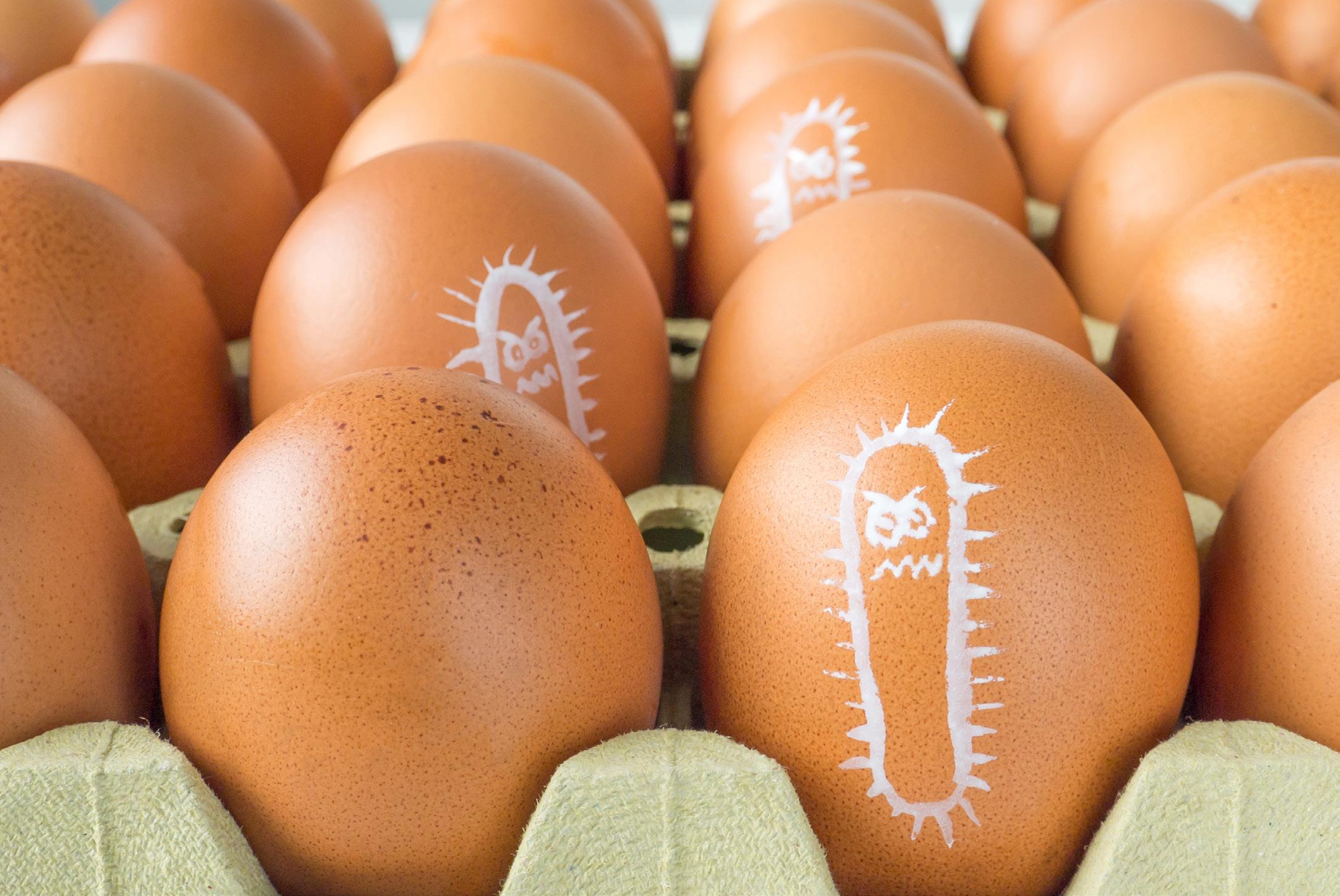
35 Jul-Aug
ในรถ
สัตว์ปีก และอาหาร ทะเลแยกจากอาหารพร้อมรับประทาน เช่น สลัดและเนื้อสำาเร็จรูป ใช้เขียงและจานแยกต่างหากสำาหรับ ของสด เนื้อดิบ เนื้อสัตว์ปีก อาหารทะเล และไข่ ห้ามวางอาหารที่ปรุงสุกแล้วบนจาน ใส่ไข่ดิบหรือไข่ที่ยังไม่สุก เนื้อสัตว์ เนื้อ สัตว์ปีก อาหารทะเล หรือน้ำาจากเนื้อสัตว์ ปรุงด้วยความร้อน: ใช้เทอร์โมมิเตอร์วัดอุณหภูมิอาหาร เพื่อให้มั่นใจว่าอาหารปรุงสุกมีอุณหภูมิ ภายในที่ปลอดภัย: 62.78 °C สำาหรับเนื้อวัว เนื้อหมู แฮม เนื้อลูกวัว และเนื้อแกะ (พักเนื้อไว้ 3 นาที ก่อนหั่นหรือรับประทาน) 62.78°C สำาหรับปลามีครีบ (หรือ ให้ความร้อนจนเนื้อทึบแสง) 71.11°C สำาหรับเนื้อวัวบด เนื้อหมู บด เนื้อลูกวัวบด และเนื้อแกะบด 71.11°C สำาหรับอาหารจากไข่ 73.89°C สำาหรับเนื้อสัตว์ปีก (ไก่ ไก่ งวง เป็ด) รวมถึงเนื้อไก่บดและเนื้อไก่งวงบด 73.89 °C สำาหรับเมนูแคสเซอโรล (อาหารอบในจานก้นลึก) อาหารที่อุ่นด้วยเตาไมโครเวฟ อุณหภูมิ 73.89°C หรือสูงกว่า ให้ความร้อนไข่อย่างถูกต้อง อย่ากิน ไข่ดิบหรือไข่ที่มีไข่ขาวหรือไข่แดงยังเหลวอยู่ ทำาความเย็น: รักษาอุณหภูมิตู้เย็นของคุณที่ 4.44°C หรือต่ำากว่า อย่าวางอาหารที่เสียง่ายไว้นอกตู้เย็น นานกว่าสองชั่วโมง หากอาหารอยู่ในสภาพ ที่มีอุณหภูมิสูงกว่า 32.22°C (เช่น ในรถ ที่ร้อนหรือการไปปิกนิกในฤดูร้อน) ให้แช่ เย็นหรือแช่แข็งภายในหนึ่งชั่วโมง อาการ สิ่งสำาคัญ คือ ต้องรู้จักอาการของโรค ซาลโมเนลโลซิสเพื่อที่คุณจะได้ไปพบแพทย์ได้ ทันเวลา คนส่วนใหญ่ที่ติดเชื้อซาลโมเนลลา มักมีอาการท้องเสีย (อาจมีเลือดปน) มีไข้ และปวดท้อง บางคนอาจมีอาการคลื่นไส้ อาเจียน หรือปวดศีรษะด้วย มักเริ่มมี อาการภายในหกชั่วโมงถึงหกวันหลังการ ติดเชื้อ และจะมีอาการอยู่สี่ถึงเจ็ดวัน ให้ พบแพทย์หากคุณมีอาการต่อไปนี้: ท้องเสียและมีไข้สูงกว่า 102 องศา ฟาเรนไฮต์ ท้องเสียเกินสามวันแล้วไม่ดีขึ้น อุจจาระเป็นเลือด อาการอาเจียนเป็นเวลานานทำาให้คุณ ไม่สามารถรักษาของเหลวในร่างกายไว้ได้ สัญญาณภาวะขาดน้ำา เช่น ปัสสาวะ น้อยมาก ปากและคอแห้ง หรือเวียนศีรษะ เมื่อลุกขึ้นยืน
When it comes to grocery shopping, food safety is a top priority for consumers as we all want to make sure that the food, we bring home is safe to eat. Therefore, consumers need to be aware of the prevalence of food pathogens in foods when purchasing from supermarkets, understand the potential risks, and how to minimize them.
One of the most common food pathogens found in foods is salmonella, a type of bacteria that can cause serious illness.
Pathogen-Food Pairing and Salmonella Outbreaks
In a study by the Center for Disease Control and Prevention (CDC) between 2009-2015, salmonella in chicken and pork were among the top five pathogen-food category pairs resulting in foodborne disease outbreaks.
Salmonella in eggs, seeded vegetables, and chicken caused the most outbreak-associated illnesses during that period.
However, the true prevalence of salmonella infections may be even higher than reported. More recently, the CDC estimates that salmonella causes over one million foodborne illnesses in the USA every year, with many cases going unreported.
For every confirmed case of salmonella infection, nearly 30 other cases may go unreported since people with symptoms of foodborne illness often do not seek medical attention or have laboratory tests done.
Similarly in Europe, data from the European Centre for Disease Prevention and Control (ECDC) showed that salmonella infections went up in 2021. Thirty markets reported 61,236 salmonellosis cases, of which 60,494 were laboratory-confirmed in 2021. This was an increase of 14 percent from 53,163 cases in 2020.
Hospitalization status was reported for 31,357 cases and 38 percent needed hospital treatment. Cyprus, Greece, and Lithuania had the biggest proportion of hospitalized cases. At least 73 people died in 2021.
The top notification rate was among young children aged 0 to 4. The rate in this group was three times more than in older children and 11 times higher than in adults aged 25 to 64. As in previous years, the three main salmonella types were Salmonella enteritidis, Salmonella typhimurium, and Monophasic Salmonella typhimurium . Young children and the elderly generally suffer the most severe illnesses.
Out of 45,177 cases with known travel history, 1,591 were travelassociated, the lowest rate ever reported. The highest proportion of
Table 2: Top 5 common confirmed pathogen-food category in outbreak-associated illness
travel-related cases was in France, Iceland, Sweden, and Slovenia. Among cases with information on the probable market of infection, Turkey, Spain, and Italy were the most frequent destinations.
Eggs and egg products continue to be the highest-risk foods in outbreaks, but several large incidents were linked to contaminated vegetables, fruits, and sesame seeds. Recent outbreaks have been linked to chicken, ground turkey, ground beef, raw tuna, mushrooms, onions, peaches, papayas, cut fruits, cashew brie, and tahini.
Therefore, it is important to take precautions to prevent Salmonella infections by properly handling and cooking food, washing hands and surfaces, and avoiding crosscontamination.
Recall of Poultry and Meat Products
Chicken is a major source of these illnesses with research showing that one in every 25 packages of chicken at the grocery stores is contaminated with salmonella. You can get sick from contaminated chicken if it is not cooked thoroughly. You can also get sick if its juices leak in the refrigerator or get on kitchen surfaces and then get on something you eat raw, such as salad.
Source: Foodborne Disease Outbreak Survelliance System, United States and Purto Rico, 2009-2015
Over 59,000 pounds of frozen chicken have been recalled over concerns of salmonella contamination. The nationwide recall impacts five stuffed, breaded chicken products sold under three brand names, per an announcement from the US Department of Agriculture’s (USDA) Food Safety and Inspection Service (FSIS). FSIS
36 www.innolabmagazine.com
ตารางที่ 2: การจับคู่เชื้อโรค-อาหารที่ทำาให้เกิดการเจ็บป่วยที่เกี่ยวข้องการระบาดที่ได้รับ การยืนยันบ่อยครั้งที่สุด 5 ลำาดับแรก
Etiology Food Category No. of Outbreaks No. of Illnesses Salmonella Eggs 31 2,422 Salmonella Seeded vegetables 25 2,203 Salmonella Chicken 49 1,941 Salmonella Pork 43 1,539 Campylobacter Dairy 60 917
and the CDC identified six states in their initial report: Arizona, Illinois, Indiana, Michigan, Minnesota, and New York. Meanwhile, more than three tons of frozen sausages sold at Walmart have been recalled for possible Salmonella contamination.
Four Steps to Prevent Salmonella Infection
Following the clean, separate, cook, and chill guidelines is crucial in preventing salmonella infection from food.
Clean:
Wash hands with soap and clean, running water for at least 20 seconds before and after handling food, especially after touching raw or undercooked eggs, meats, poultry (like chicken and turkey), seafood, or their juices
Wash utensils, cutting boards, dishes, and countertops with hot, soapy water, especially after they’ve touched raw or undercooked eggs, meats, poultry, seafood, or their juices
Do not wash raw eggs, meats, poultry, or seafood before cooking. Washing can spread germs to other foods, utensils, and surfaces
Sanitize kitchen surfaces with a freshly made solution of one tablespoon of unscented liquid chlorine bleach in one gallon of water
Separate:
Keep raw meat, poultry, seafood, and eggs separate from other foods in your grocery cart and in your refrigerator. Keep eggs in the original carton and store them in the main part of the refrigerator, not in the door
Keep raw meat, poultry, and seafood separate from ready-to-eat foods, such as salads and deli meat
Use separate cutting boards and plates for produce, raw meat, poultry, seafood, and eggs
Never place cooked food on a plate that previously held raw or undercooked eggs, meats, poultry, seafood, or their juices
Cook:
Use a food thermometer to ensure that foods are cooked to a safe internal temperature:
145°F for beef, pork, ham, veal, and lamb (let the meat rest for 3 minutes before carving or eating)
145°F for fish with fins (or cook until flesh is opaque)
160°F for ground beef, ground pork, ground veal, and ground lamb
160°F for egg dishes
165°F for poultry (chicken, turkey, duck), including ground chicken and ground turkey
165°F for casseroles
Microwave food to 165°F or above
Cook eggs properly. Do not eat raw eggs or eggs that have runny whites or yolks
Chill:
Keep your refrigerator at 40°F or colder
Never leave perishable foods out of refrigeration for more than two hours. If the food is exposed to temperatures above 90°F (like a hot car or summer picnic), refrigerate or freeze it within one hour
Symptoms
It is also important to know the symptoms of salmonellosis so you can seek medical attention in time. Most people with a salmonella infection experience diarrhea (that can be bloody), fever, and stomach cramps. Some people may also have

nausea, vomiting, or a headache. Symptoms usually start within six hours to six days after infection and last between four to seven days. Call the doctor if you have:
Diarrhea and a fever higher than 102°F
Diarrhea for more than three days that is not improving
Bloody stools
Prolonged vomiting that prevents you from keeping liquids down
Signs of dehydration, such as making very little urine, dry mouth and throat, or dizziness when standing up
Thailand LAB INTERNATIONAL, Bio Asia Pacific and FutureCHEM 2023
พบสุดยอดเทคโนโลยีและนวัตกรรมสำาหรับอุตสาหกรรมเครื่องมือห้องปฏิบัติการทางวิทยาศาสตร์
หรือ TCELS (ทีเซลส์) คณะ
Thailand LAB INTERNATIONAL
Bio Asia Pacific งานแสดง

นวัตกรรมและเทคโนโลยีด้าน
เทคโนโลยีชีวภาพและการ แพทย์สมัยใหม่ และงาน FutureCHEM INTERNATIONAL งานแสดงนวัตกรรม
และผู้ประกอบการทั้งในและต่างประเทศ อย่างครบครันที่สุด
4 ภาค โดยผสานความร่วมมือกับภาครัฐ
เพื่อกระตุ้นให้เกิดการ รับรู้ มือที่ทันสมัยและการพัฒนางานวิจัยโดยใช้เครื่อง
การ แพทย์และสุขภาพ มุ่งหวังให้ประเทศไทย
38 www.innolabmagazine.com ATTRACTIONS
Contact แสงทิพ เตชะปฏิภาณดี Saengtip Techapatiphandee, Marketing & Communications Manager, VNU Exhibitions Asia Pacific Co., Ltd. saengtip@vnuasiapacific.com +66 (8) 3197 8848 วีเอ็นยู เอเชีย แปซิฟิค ร่วมกับสมาคม การค้าวิทยาศาสตร์และเทคโนโลยี (STTA) และศูนย์ความเป็นเลิศด้านชีววิทยาศาสตร์ องค์การมหาชน
ผู้จัดงาน
งานแสดงเทคโนโลยีและนวัตกรรมเครื่อง มือสำาหรับห้องปฏิบัติการทางวิทยาศาสตร์ และงาน
ผลงานวิจัย
ชีววิทยาศาสตร์
โดย มีผู้ประกอบการชั้นนำาในอุตสาหกรรมทั้งใน และต่างประเทศกว่า
500 แบรนด์ชั้นนำามาจัดแสดงภายในงาน คาดดึงดูดผู้ซื้อและผู้เข้าชมงานกว่า 10,000 รายจากทั่วภูมิภาคตลอด 3 วันของการจัด งาน พร้อมนำาเสนอเทคโนโลยี
ใหม่ และนวัตกรรมต่างๆ
อย่างยิ่งใหญ่บนพื้นที่จัดงานกว่า 12,000 ตารางเมตร ตอบรับความต้องการทั้งผู้ซื้อ
ทางเคมีเพื่ออุตสาหกรรมในอนาคต
200 ราย มากกว่า
ผลงานวิจัย
เผยแพร่สู่ตลาด
โดยกำ า หนดจัดงาน ระหว่างวันที่ 6-8 กันยายน พ.ศ. 2566 ณ ฮอลล์ 102-104 ศูนย์นิทรรศการและ การประชุมไบเทค กรุงเทพฯ ตั้งแต่เวลา 10:00-17:00 น.
ชีววิทยาศาสตร์ เคมี การแพทย์และสุขภาพ ตอบโจทย์นักวิจัย ในงาน Thailand LAB, Bio Asia Pacific และ FutureCHEM 2023!! เปิดตัวแบรนด์ระดับสากล สู่ตลาด เอเชียตะวันออกเฉียงใต้ ในปีนี้ คณะผู้จัดงานยืนยันความพร้อม กลับมาจัดงานอย่างเต็มรูปแบบ พร้อมเปิด เวทีให้ผู้ประกอบการและผู้ที่เกี่ยวข้องใน อุตสาหกรรมสามารถมาพบปะพูดคุยกับผู้ ผลิตและผู้เชี่ยวชาญ
ใหม่ล่าสุดจากผู้ประกอบการทั้งในประเทศ และต่างประเทศ งานเดียวที่ครอบคลุมทุก ความต้องการของทุกอุตสาหกรรม ไม่ว่า จะเป็นเทคโนโลยีเครื่องมือในห้องปฏิบัติ การทางวิทยาศาสตร์ เทคโนโลยีเพื่อความ ปลอดภัยสำาหรับบุคลากรและผู้ปฏิบัติงาน นวัตกรรมด้านชีววิทยาศาสตร์และเทคโนโลยี ชีวภาพ การแพทย์สมัยใหม่ นวัตกรรมทาง เคมีเพื่ออุตสาหกรรม เทคนิคและเครื่องมือ เพื่อวิเคราะห์และตรวจสอบคุณภาพของ ผลิตภัณฑ์ทั้งอาหาร ยา วัคซีน เครื่อง สำาอาง ปิโตรเคมี ซึ่งทุกภาคส่วนที่มีความ จำาเป็นต้องใช้เครื่องมือห้องปฏิบัติการทาง วิทยาศาสตร์เหล่านี้ อย่างครบวงจรตั้งแต่ต้นน้ำเพื่อการพัฒนาธุรกิจ าสู่ปลายน้ำาและ ทั่วถึงทุกภูมิภาค “Thailand LAB INTERNATIONAL และ Bio Asia Pacific ถือเป็นเวทีเจรจา การค้าและแลกเปลี่ยนเทคโนโลยีที่สำาคัญ สำ า หรับอุตสาหกรรมห้องปฏิบัติการทาง วิทยาศาสตร์ ชีววิทยาศาสตร์และเคมี สำาหรับทุกอุตสาหกรรมที่ครบวงจร ด้วย ประสบการณ์การจัดงานอย่างต่อเนื่องมากกว่า 12 ปี ทำาให้เราได้รับความไว้วางใจจากผู้ ประกอบการ สมาคม องค์กร และหน่วย งานต่างๆ และแบรนด์ชั้นนำาระดับโลกกว่า 500 แบรนด์มาจัดแสดงภายในงาน อาทิ Thermo Fisher, Danaher, Eppendorf, Agilent Technology, Mettler Toledo, DKSH, IKA, Sartorius, Zeiss,
Scientific, Buchi, Sarstedt, Neogen และอีกมากมาย” คุณ อนุชา พันธุ์พิเชฐ ผู้จัดการโครงการอาวุโส บริษัท วีเอ็นยู เอเชีย แปซิฟิค กล่าว “ใน งาน Thailand LAB ปีนี้ ทางผู้จัดงานได้ มีการประชาสัมพันธ์การจัดงานให้เป็นที่ รู้จักมากขึ้น โดยเฉพาะอย่างยิ่งในระดับ ภูมิภาค
มหาวิทยาลัยชั้นนำา
นอกจากนี้ งาน Bio Asia Pacific ยังมีการสร้างเครือข่ายเพิ่มเติม โดยเฉพาะอย่างยิ่งงานวิจัยทางด้านยา
ก้าวขึ้นเป็นผู้นำ าในระดับแนวหน้า และ เป็น Medical hub ของเอเชีย มีการจัด กิจกรรมและการประชาสัมพันธ์การจัดงาน ไปยังต่างๆ ประเทศในเอเชีย โดยมีจุดมุ่ง หมายในการสร้างเครือข่าย Ecosystem partner ที่เข้มแข็ง เพื่อดึงดูดนักวิจัยและ นักลงทุนทั้งในและต่างประเทศในช่วงเวลา ของการจัดงาน”
ชมการสาธิตเทคโนโลยี
Keyence, Perkin Elmer, Daihan
ผ่านอุทยานวิทยาศาสตร์ทั้ง
และเอกชน ตลอดจนภาคการศึกษาและ
VNU Asia Pacific, together with the Science and Technology Trade Association (STTA) and the Thailand Center of Excellence for Life Sciences (Public Organization) or TCELS, is organizing Thailand LAB INTERNATIONAL showcasing analytical laboratory equipment and instruments, the Bio Asia Pacific showcasing research, innovation and technology for biotechnology, life sciences and smart health, and the FutureCHEM INTERNATIONAL, a new conference and exhibition platform focusing on innovative solutions for the chemical industry. The events will welcome 200+ leading exhibitors and more than 500+ brands around the world, covering an exhibition area of 12,000+ Sq.m. and expecting to attract more than 10,000+ visitors across the region throughout the 3-day exhibition from 6-8 September 2023, 10:00 – 17:00, at Hall 102-104, BITEC, Bangkok, Thailand.
New Global Brands Introduced into Southeast Asia Market
This year, the organizers have confirmed their readiness to resume
the full scales of the exhibition, providing platforms for entrepreneurs and those involved in the industries to meet and talk with manufacturers and experts. They will experience the latest technology demonstrations from local and international exhibitors, covering all the needs of every industry. Those include scientific laboratory equipment technology, technology for laboratory safety, innovation in life sciences and biotechnology, modern medicine, innovation in chemistry for industries, techniques and equipments for product quality analysis and inspection that cover food, medicine, vaccines, cosmetics, and petrochemicals. All sectors need these laboratory tools to develop their end-to-end businesses across all regions.
Anucha Parnpichate, the Senior Project Manager of VNU Asia Pacific, said “Thailand LAB INTERNATIONAL is an important forum for trade negotiations and technology exchange for industries involving laboratories, life sciences and chemistry. With more than 12 years of experience organizing the events continuously, we are trusted by
more than 500+ leading entrepreneurs and brands to exhibit at the event, including Thermo Fisher, Danaher, Eppendorf, Agilent Technology, Mettler Toledo, DKSH, IKA, Sartorius, Zeiss, Keyence, Perkin Elmer, Daihan Scientific, Buchi, Sarstedt, Neogen and more.” He added that this year, the organizer has publicized the event to get recognized through the four science parks in four regions of Thailand, in cooperation with the educational sector and leading universities. Also, the event has also been promoted in other Asian countries, aiming to build a strong laboratory ecosystem and attract foreign investors to visit the event this September, which has been well received.
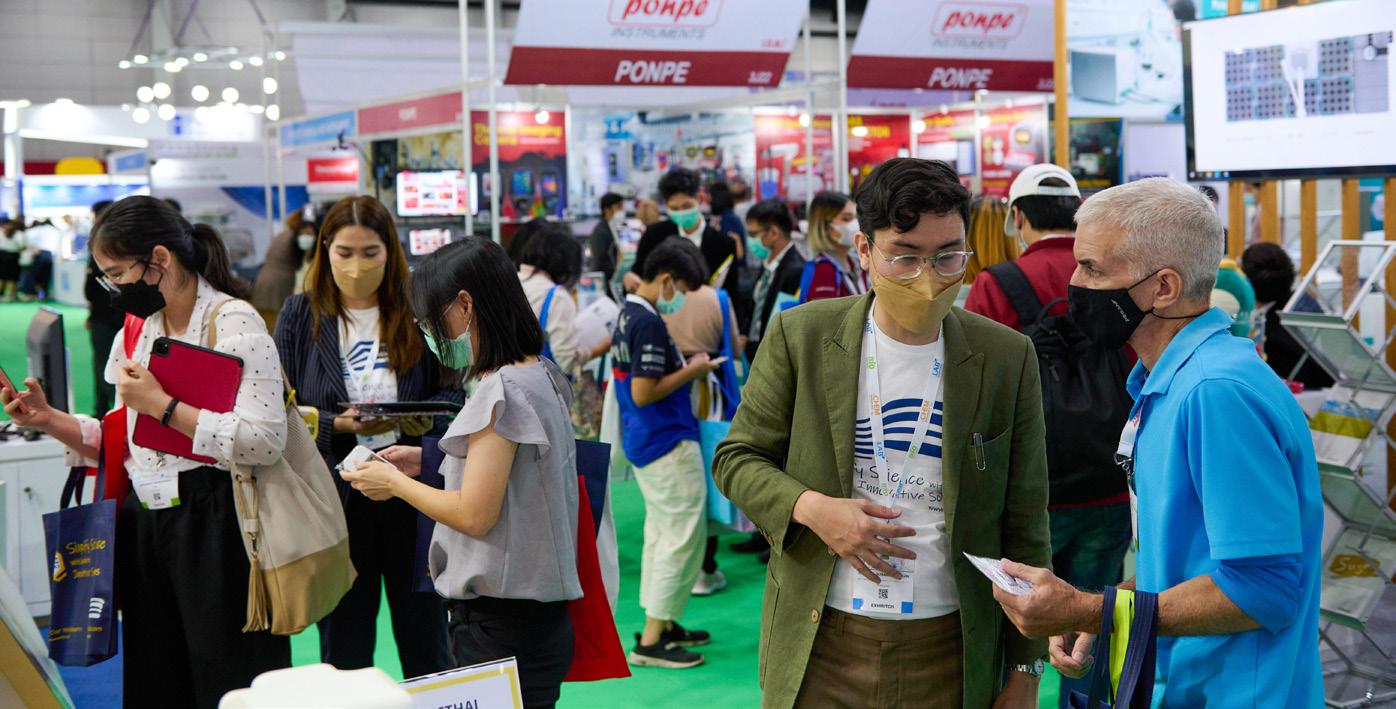
In addition, Bio Asia Pacific has additional networking opportunities. Especially research in medicine medical and health aiming to make Thailand become a leader in the forefront and be the medical hub of Asia, organizing activities and promoting events to various countries in Asia. The aim is to build a strong ecosystem partner network to attract researchers and both domestic and foreign investors during the event.
Laboratory Standard and Market Trend Update through 100+ Seminar Topics for Free!
Weight Measurement Technology for Pharmaceutical Industry Intro Enterprise Co., Ltd.6 September 2023Cryogenic Storage in the era of GMP and GXP | by IC Biomedical, USA (TCELS)| 6 September 2023
Quantitative NMR or qNMR: a powerful and efficient tool for accurate quantitative analysis of chemical, food
40 www.innolabmagazine.com
Explore the latest solutions for Laboratories, Smart health, Life Sciences, and Chemistry industries, for all researchers in the region at Thailand LAB INTERNATIONAL, Bio Asia Pacific and FutureCHEM 2023!!
and pharmaceutical| by FUJIFILM Wako Pure| 7 September 2023
Waste Plastics & Microplastics: Challenges & Solutions | by Frontier Lab | 7 September 2023
Unitary Patent system & HTA Procedures Harmonization: How to Best Prepare for These Challenges? | by Patent Attorney European Patent Attorney | 8 September 2023
For more information, please visit https://thailandlab.com/conference/
The Latest Technologies and Innovations from International Brands
At Thailand LAB INTERNATIONAL, visitors will find several international brands gathering to showcase their latest solutions. The INTERNATIONAL Pavilion zone this year features the Indian Pavilion, the Chinese Pavilion, and the South Korea Pavilion. The event combines 30% of international exhibitors and 70% of Thai exhibitors, offering many activities and benefits for
visitors, for example, demonstrations of advanced research equipment from leading brands, symposiums on the use of tools in detail, and special promotions exclusively for the visitors. Special activities include:
The Opening Ceremony with representatives from the government giving an update on the directions and overview of the laboratory supplies market (6 September 2023, Morning)
The Networking Night, another highlight of the event that offers a meeting point for buyers, entrepreneurs, event partners, and key players in the industry, unveiling the direction of the event in the following year, and ending the night with a fun and exciting lucky draw and a mini-concert from Pure Ekapan (Pure, The Voice) and Electronic Dance Music by DJ P-U (6 September 2023, Evening)
The Online Business Matching, the system that helps increase your business opportunities, finding and introducing to you your perfect business match so that you can
continue negotiations at the event
Other interesting activities include the Happy Hours for Exhibitors / the Guided Tour by experts / the Stamp Map Rally for special prizes throughout the 3-day event and the lucky draw for the pre-registered participants to win gold and many more prizes. Let’s have fun and achieve your business objectives at the same time this year at the event.
Pre-register now for Thailand LAB INTERNATIONAL, Bio Asia Pacific and FutureCHEM INTERNATIONAL on 6-8 September 2023 at Hall 102104, BITEC, Bangkok, Thailand. Get a chance to win six gold necklaces every day throughout the 3 days of the event for group visits (a group of six people or more). For more information, please visit www. thailandlab.com or www.bioasiapacific. com. For more information about the shuttle service (Group Visitor Campaign in Thailand), please call 02-1116611 ext. 330/335 (MarCom Department).
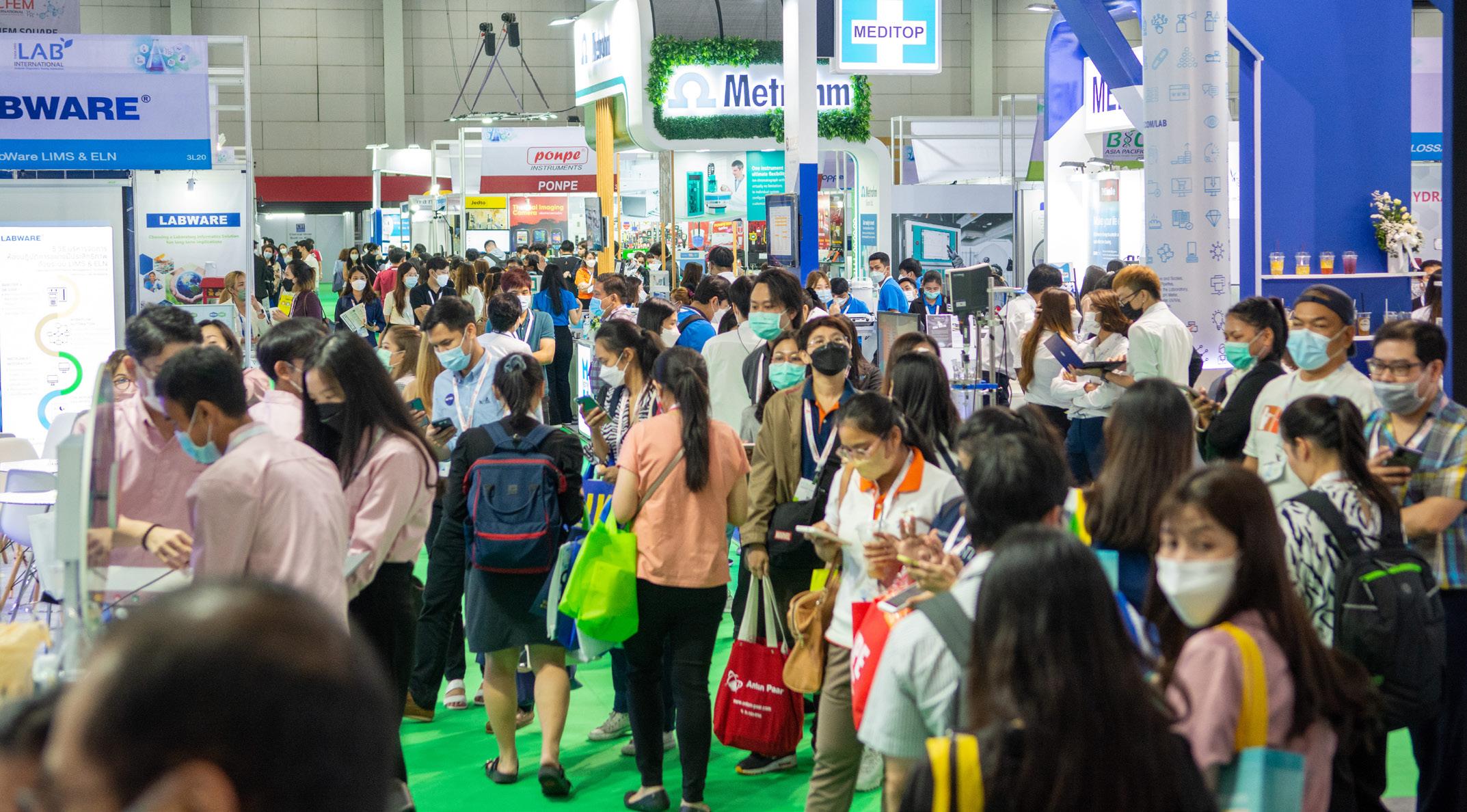
41 Jul-Aug
Fi Asia & Vitafoods Asia 2023: Don’t
ถึง 229 พันล้านดอลลาร์ ในปี 2569
Fi Asia 2023: ชั้น G ฮอลล์ 1-4
Vitafoods Asia 2023:
Fi Asia: www.fiasia.com
Vitafoods Asia: www.vitafoodsasia.com
Bangkok is the place to be this September! From 20th22nd, two big names, Fi Asia Thailand and Vitafoods Asia, are teaming up at QSNCC. If you’re in the food, drink, and nutraceuticals business, this is for you.
Fi Asia Thailand 2023 offers an unmissable deep dive into the ASEAN food and beverage industry. Expect a dynamic gathering of over 600 international exhibitors from 40+ countries, unveiling the latest in ingredients and solutions. With the co-location with Vitafoods Asia, you have a golden chance to connect with a broader spectrum of professionals, amplifying your opportunities for new partnerships, trends, and markets.
Vitafoods Asia 2023 is set to cater to the escalating demand in the nutraceutical sector. The emphasis on health and wellness is on a meteoric rise, with nutraceuticals leading the way. Given Asia’s projected nutraceutical industry growth to a whopping USD 229 billion by 2026, there’s no better time to tap into this booming market. Engage with over 460+ exhibit companies that are poised to shape the future of the nutraceutical industry.
Three packed days of:
Networking: Connect with the industry leader of the F&B and nutraceutical worlds.
Innovations: Discover state-of-the-art ingredients, products, equipment, and services.
Learning: Benefit from expert-led seminars, technical presentations, and business insights.
Exploration: Scout new ingredients, extend your product line, and discover emerging trends.
Event Details:
When: 20-22 September 2023
Where: Queen Sirikit National Convention Center, Bangkok, Thailand.
Fi Asia - G floor, Hall 1-4
Vitafoods Asia - LG floor, Hall 5-7
See more info at
Fi Asia: www.fiasia.com
Vitafoods Asia: www.vitafoodsasia.com
42 www.innolabmagazine.com ATTRACTIONS
เตรียมพบการรวมตัวของอีเวนต์ใหญ่แห่งปีกับงาน ฟู้ด อินกรีเดีย นท์ เอเชีย และ ไวต้า ฟู้ดส์ เอเชีย 2023 จัดขึ้นระหว่าง 20-22 กันยายน 2566 ณ ศูนย์การประชุมแห่งชาติสิริกิติ์ กรุงเทพฯ ถ้าคุณ คือผู้ประกอบการในอุตสาหกรรมอาหาร เครื่องดื่ม และอุตสาหกรรม เสริมอาหารและวัตถุดิบ งานนี้จะเป็นงานที่คุณพลาดไม่ได้ ฟู้ด อินกรีเดียนท์ เอเชีย
2023) นำ า รวบรวมกว่าเสนอเทรนด์อาหารแห่งอนาคตในภูมิภาคอาเซียน 600 บริษัทจาก 40+ และโซลูชันล่าสุดแห่งวงการอาหารและเครื่องดื่มประเทศเพื่อจัดแสดงวัตถุดิบ พร้อมโอกาสพิเศษ ในการขยายเครือข่ายกับผู้เชี่ยวชาญจากหลากหลายสาขาในวงการ ยกระดับธุรกิจไปสู่โอกาสใหม่ ทั้งในด้านพันธมิตรการค้า เทรนด์ ผลิตภัณฑ์ และการขยายตลาด ไวต้า ฟู้ดส์ เอเชีย 2023 (Vitafoods Asia 2023) งานเพื่อ ตอบสนองความต้องการที่เพิ่มขึ้นของผลิตภัณฑ์เสริมอาหารและ วัตถุดิบในภูมิภาคเอเชีย ด้วยอัตราการเติบโตที่คาดว่าจะมีมูลค่า
ชมงานได้พบกับผู้ผลิต ผู้จัดจำาหน่าย และผู้ให้โซลูชันกว่า 460+ บริษัทจากทั่วโลก ที่พร้อมจะกำาหนดอนาคตของวงการผลิตภัณฑ์ เสริมอาหารและวัตถุดิบในเอเชีย สิ่งที่คุณจะได้สัมผัสตลอด 3 วัน • พบคู่ค้าทางธุรกิจใหม่: เชื่อมโอกาสทางธุรกิจกับผู้นำาในวงการ อาหาร เครื่องดื่ม ผลิตภัณฑ์เสริมอาหารและวัตถุดิบ • สัมผัสนวัตกรรมล่าสุดก่อนใคร: ค้นพบวัตถุดิบ ผลิตภัณฑ์ อุปกรณ์ และบริการที่เป็นที่สุดในอุตสาหกรรม • อัปเดตเทรนด์อุตสาหกรรม: อัปเดตเทรนด์และความรู้จาก ผู้นำาอุตสาหกรรม ติดตามนวัตกรรมและสินค้าใหม่ เจาะลึกข้อมูล ธุรกิจก่อนใคร • สำารวจตลาดและค้นหาวัตถุดิบใหม่ๆ: เพิ่มช่องทางทางการ ขาย และขยายศักยภาพทางธุรกิจ รายละเอียดงาน: วันที่จัด: 20-22 กันยายน 2566 สถานที่จัด: ศูนย์การประชุมแห่งชาติสิริกิติ์ กรุงเทพฯ
Miss This Game-Changing Combo!
2023 (Food Ingredients Asia
เรื่องสุขภาพและความเป็นอยู่มากขึ้นสอดคล้องกับยุคที่ผู้คนใส่ใจ
งานนี้เสริมโอกาสเพื่อให้ผู้
ชั้น
ดูรายละเอียดเพิ่มเติมได้ที่:
LG ฮอลล์ 5-7
Contact สัจจาลักษณ์
Sujjarluck Phu-aiem (Sugar), Marketing Executive, Fi Asia l CPHI SEA l Propak Connect, Informa Markets sujjarluck.p@informa.com +66 (0) 2 036 0500 ext. 237
ภู่เอี่ยม

CBE ASEAN 2023
ขนาดกลางและขนาดย่อม(สสว.) OSMEP
Cosmoprof CBE ASEAN 2023 เปิดลงทะเบียนชมงานแล้ววันนี้ โปรดดู ข้อมูลเพิ่มเติมและลงทะเบียนชมงานที่ได้ www.cosmoprofcbeasean.com
Cosmoprof CBE ASEAN 2023 คือ ก้าวที่ไกลกว่าของงานจัดแสดงสินค้าเพื่อ
สู่ประสบการณ์
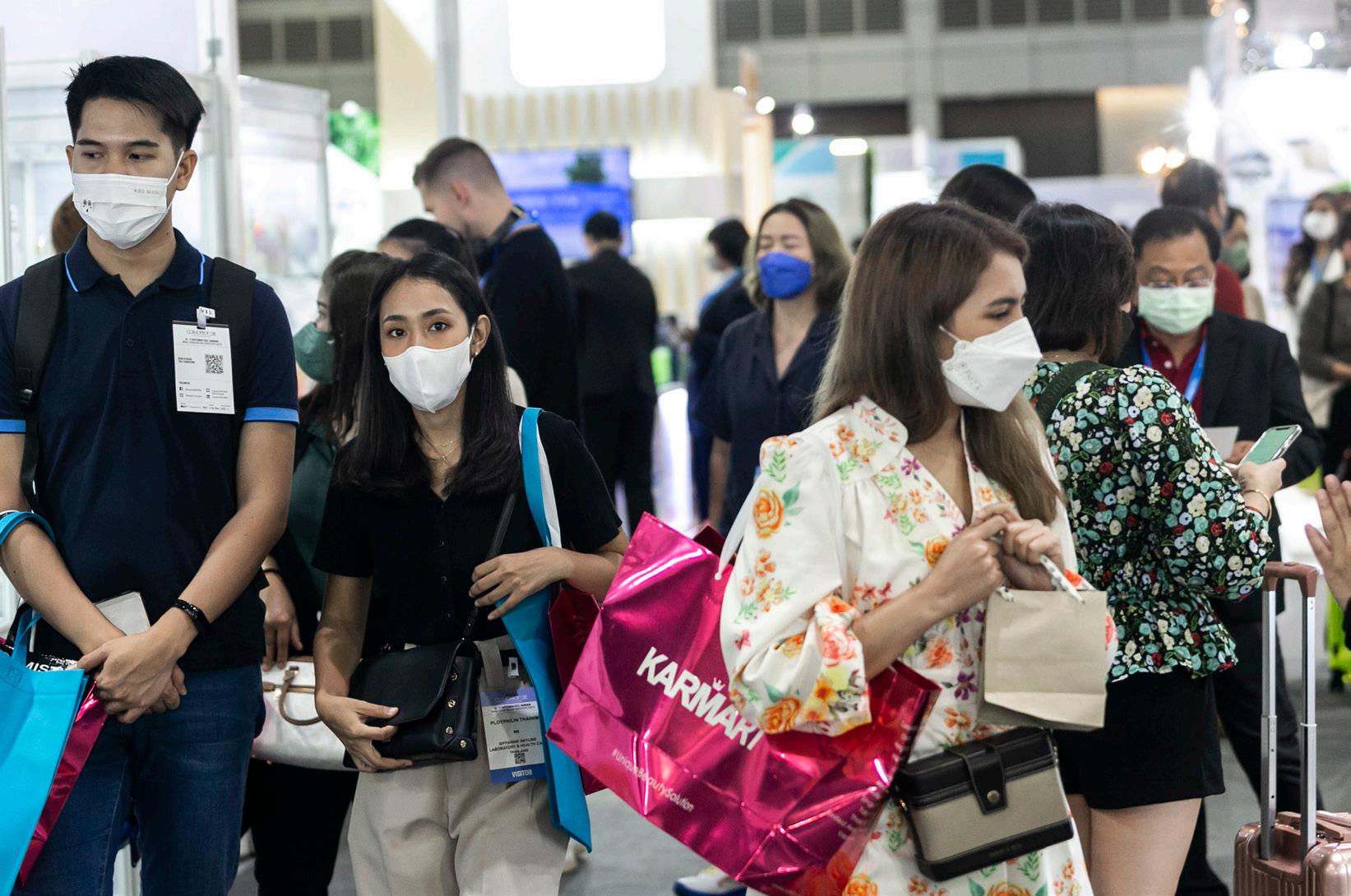
44 www.innolabmagazine.com Cosmoprof CBE ASEAN 2023 งานแสดงสินค้าเพื่อธุรกิจความงามระดับโลกกำาลังจะกลับมาอีกครั้ง ที่ครั้งนี้กลับ มาพร้อมความยิ่งใหญ่กว่าที่เคย พบผู้ซื้อ-ผู้ร่วมจัดแสดงสินค้าชั้นนำาจากไทยและต่างประเทศมากมาย ครอบคลุมทุก กลุ่มผลิตภัณฑ์ พร้อมเวทีจับคู่เจรจาธุรกิจระดับนานาชาติ และกิจกรรมอื่นๆ อีกมากมายภายในงาน ATTRACTIONS
Cosmoprof
จะจัดขึ้นในวันที่ 14-16 กันยายนนี้ ณ ศูนย์การประชุมแห่งชาติสิริกิติ์ กรุงเทพฯ งานเดียวครบวงจร ตอบทุกโจทย์ธุรกิจ สำาหรับทั้งผลิตภัณฑ์สำาเร็จรูป และกลุ่มผู้ ผลิตผลิตภัณฑ์เพื่อความงาม ผู้ออกแสดงสินค้า 1,000 ราย จาก 15 ประเทศทั่วโลก พื้นที่จัดแสดงงานกว่า 17,000 ตารางเมตร ผู้ซื้อ-ผู้ชมงานกว่า 12,000 ราย จาก 50 ประเทศ จากความสำาเร็จปีที่ผ่านมาในงานแสดง สินค้าครั้งแรกของงาน Cosmoprof CBE ASEAN เป็นอีกบทพิสูจน์ของคุณภาพ และเสียงตอบรับของงานด้วยตัวเลขผู้เข้า ชมงานกว่า
และผู้ออกแสดงสินค้ากว่า
บริษัท
ธุรกิจความงามในภูมิภาค
ใหม่ของงานแสดงสินค้าเพื่อธุรกิจความงาม ระดับโลก ภายใต้ความร่วมมือครั้งแรกของ สามออแกไนเซอร์จัดงานแสดงสินค้าระดับ โลกทั้ง BolognaFiere, Informa Markets และ China Beauty Expo (CBE) ในปัจจุบัน Cosmoprof Network คือ เครือข่ายงานแสดงสินค้าความงามที่ใหญ่ที่สุด ในโลก โดยในแต่ละปี ผู้ร่วมชมงานรวมกว่า 500,000 ราย และผู้แสดงสินค้ากว่า 10,000 บริษัท เข้าร่วมในงานแสดงสินค้าภายใต้ แบรนด์ Cosmoprof ทั่วโลก ทั้งที่ อิตาลี, สหรัฐอเมริกา ฮ่องกง, อินเดีย และไทย Contact ธริษตร์ มานะกุล Tharit Manakul, Marketing Manager, Marketing Department, Informa Markets tharit.m@informa.com +66 (0) 2 036 0500 งาน Cosmoprof CBE ASEAN เป็นงานที่ เหมาะกับนักธุรกิจที่อยู่ในแวดวงอุตสาหกรรม อย่างแท้จริง นอกจากจะมีสินค้าความงาม ที่หลากหลายให้เลือกตั้งแต่สายการผลิตไป จนถึงผลิตภัณฑ์สำาเร็จรูป ยังเป็นงานที่เปิด โอกาสให้กับผู้ชมงานได้พูดคุยโดยตรงกับ เจ้าของธุรกิจ เพื่อหาโซลูชันทางธุรกิจที่ดี ที่สุดระหว่างกัน นอกจากนี้ภายในงาน ยังมีกิจกรรมจับคู่เจรจาธุรกิจ ระหว่างผู้ ซื้อและผู้ขายอีกด้วย อันเป็นโอกาสอันดี สำาหรับเจ้าของแบรนด์ที่กำาลังมองหาช่อง ทางธุรกิจในการส่งออกอีกด้วย หรือถ้า ต้องการเริ่มต้นธุรกิจ ภายในงานเรายังมี กิจกรรม Cosmotalks เวทีสัมมนาความ รู้ด้านธุรกิจความงามจากผู้เชี่ยวชาญที่จะ มาช่วยแนะนำ า วิธีคิดและการสร้างธุรกิจ ความงามให้ผู้เยี่ยมชมงานทุกคนได้สร้าง แรงบันดาลใจทางธุรกิจไปพร้อมกัน นอกจากนี้ งาน Cosmoprof CBE ASEAN 2023 ได้รับการสนับสนุนอย่าง เป็นทางการโดยสภาอุตสาหกรรมแห่ง ประเทศไทย FTI สมาคมผู้ผลิตเครื่องสำาอาง ไทย TCMA และสำานักงานส่งเสริมวิสาหกิจ
Cosmoprof CBE ASEAN 2023
8,216 จาก 49 ประเทศ
500
Cosmoprof CBE ASEAN is the B2B beauty event organised by BolognaFiere, Informa Markets, and China Beauty Expo (CBE). Designed to meet the needs of the fast-growing beauty market in Southeast Asia, the show is expected to gather top players and experts representing all sectors, beauty supply chain to branded finished products.
The 2nd edition of Cosmoprof CBE ASEAN will be held from 14 to 16 September 2023, at the Queen Sirikit National Convention Centre (QSNCC) in Bangkok, offers convenient access right in the middle of the city center.
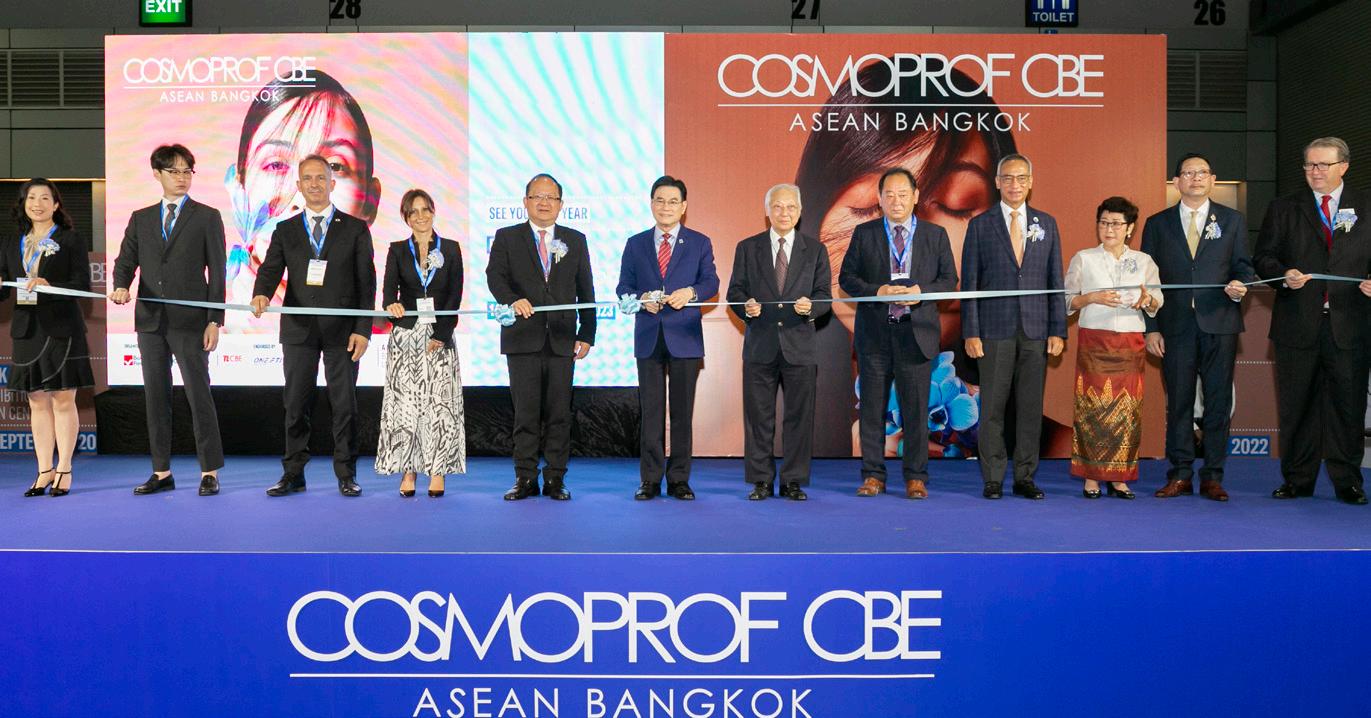
More than 1,000 high-quality exhibitors and brands with around 17,000 sqm exhibition area which presented innovative products specifically conceived for the needs of consumers in Southeast Asia.
Cosmoprof CBE ASEAN represents the ASEAN destination of the Cosmoprof network, a 360° worldwide platform for the international beauty community, with shows in Bologna, Hong Kong, Las Vegas, Mumbai and Miami which all together involve over 500,000 professionals and 10,000 exhibitors from all over the world. Pre-registration is now opened. For further information, please visit www. cosmoprofcbeasean.com
WHY TAKE PART?
THE ABSOLUTE “GATEWAY” TO ENTER THE SOUTHEAST ASIA MARKET
Cosmoprof CBE ASEAN will be
The largest beauty show in Thailand with 17,000 sqm of exhibition area and 1,000 exhibitors and brands. A one-stop solution for both finished products and the supply chain sector.
A trend setter in the beauty industry with showcasing of the latest innovations and products from all over the world.
AN IDEAL PLATFORM FOR LOCAL COMPANIES TO EXPAND BUSINESS
Cosmoprof CBE ASEAN will become an ideal B2B exhibition for Thai companies to expand their business globally. International buyers and exhibitors will gather in this Southeast Asia trade hub to create a better market with the Thai beauty industry.
Onsite activities
COSMOTALKS
CosmoTalks, seminar programme to unveil the latest trends and insights of the industry.
Topics include beauty trends, Southeast Asia beauty market analysts, the booming medical beauty industry, retail and digital marketing to sustainability and supply chain solutions.
COSMO ONSTAGE: PRESENT YOUR INNOVATIONS
Cosmo Onstage, where influencers, make-up artists, nail and hair stylists, academics, professional schools, and association have the chance to show their expertise and knowhow to press, exhibitors and buyers
Key events that highlight
WORLD MASSAGE MEETING
Four renowned holistic operators will show different techniques, synergies and connections between east and west through a cultural and emotional journey
NAIL COMPETITION
A new initiative organised by WATC® (Company name: WE ARE THE COMPANY) and supported by NAILHOLIC magazine form Korea
Offering talented nail artists and professionals the opportunity to showcase their skills and creativity on a regional stage
EYELASHES DEMONSTRATION
Attendees will have the opportunity to witness the latest techniques and trends in eyelash extensions
BUSINESS AND NETWORKING
Match&Meet is the matchmaking platform provided to facilitate networking between exhibitors and selected top buyers
This year, 250 hosted buyers are expected mainly from Thailand, ASEAN countries, Europe and the US.
Pre-registration is now opened at www.cosmoprofcbeasean.
45 Jul-Aug
in-cosmetics Asia 2023:
The central marketplace for efficacy testing and development
และทั่วโลก แต่ในช่วงไม่กี่ปีที่ผ่านมาได้ กลายเป็นที่รู้จักในฐานะศูนย์รวมด้านการ
วิทยาศาสตร์ ซึ่งสอดคล้องกับแนวโน้มของ อุตสาหกรรมในเรื่องของผลิตภัณฑ์ดูแลผิว และเครื่องสำาอางที่มีหลักฐานอ้างอิง ซึ่ง บริษัทต่างลงทุนในการวิจัยและการทดลอง ทางคลินิกเพิ่มมากขึ้นเพื่อใช้ยืนยันคำากล่าว อ้างเกี่ยวกับประโยชน์ของผลิตภัณฑ์
การกล่าวอ้างประสิทธิภาพ จะมาสาธิต ความสามารถในการทดสอบการวิจัยและ พัฒนาโดยคำานึงถึงความต้องการทางการ ตลาด ด้วยเทคโนโลยีหลากหลายที่ออกแบบ มาเพื่อประสิทธิภาพการทดสอบทางคลินิก สำ า หรับผลิตภัณฑ์ดูแลผิวและเส้นผม ผู้ เชี่ยวชาญด้านการวิจัยและพัฒนาเตรียม สาธิตวิธีการในการทดสอบผิวมันและผิว เป็นสิวง่าย การต่อต้านริ้วรอยและตีนกา เกราะป้องกันผิวและความไวของผิว การ เจริญเติบโตของเส้นผมและผมร่วง การ ยกกระชับใบหน้าและปรับรูปหน้าเป็นรูป ไข่ ขนตา ริมฝีปาก และอื่นๆ อีกมากมาย REVIVO Biosystems บริษัทสตาร์ตอัป
4 มิติ รวม ถึงอุปกรณ์ Skin-on-chip และแพลตฟอร์ม ทดสอบผิวหนังอัตโนมัติเพื่อความปลอดภัย และประสิทธิภาพในการคัดกรอง จะมา จัดแสดงผลงานโซลูชันที่ออกแบบมาเพื่อ ปรับปรุงประสิทธิภาพและความปลอดภัย ในเครื่องสำาอางและการวิจัยทางการแพทย์ อุปกรณ์ REVSkin™ คืออุปกรณ์ Skin-onchip ที่สร้างขึ้นใหม่ภายใต้สภาวะการเพาะ เชื้อแบบพลวัตที่แท้จริง (แบบจำาลองผิว 4 มิติ) เพื่อเพิ่มความใกล้เคียงมนุษย์และเพิ่ม ความสามารถในการผลิต
46 www.innolabmagazine.com อุตสาหกรรมเครื่องสำาอางและผลิตภัณฑ์ดูแลส่วนบุคคลระดับสากลจะมารวมตัวกันที่กรุงเทพฯ ประเทศไทย ในเดือน พฤศจิกายนนี้ที่งานอิน-คอสเมติกส์ เอเชียซึ่งจัดขึ้นเป็นเวลาสองวัน
สินค้า ส่วนผสม สูตร และเทคโนโลยีใหม่ๆ ATTRACTIONS
เพื่อการสร้างเครือข่ายและเปิดโอกาสในการแสดง
งานนี้จะจัดขึ้นที่ศูนย์นิทรรศการและ การประชุมไบเทค ระหว่างวันที่ 7-9 พฤศจิกายน 2566 โดยมีซัพพลายเออร์ชั้น นำาและผู้เชี่ยวชาญมากกว่า 500 รายยืนยัน ที่จะร่วมจัดแสดงส่วนผสมมากกว่า 1,100 รายการ ซึ่งพบว่า 25% เป็นผู้จัดแสดง สินค้ารายใหม่ ผู้เข้าร่วมงานจะสามารถค้น พบนวัตกรรมล่าสุดสำาหรับการพัฒนาและ ทดสอบผลิตภัณฑ์ใหม่ ประสิทธิภาพคือหัวใจสำาคัญ งานนี้ซึ่งจัดขึ้นทุกปีได้รับการยอมรับ มานานแล้วว่าเป็นเวทีกลางเพื่อการประชุม ระหว่างอุตสาหกรรมเครื่องสำาอางของเอเชีย
ทดสอบประสิทธิภาพและการพัฒนาทาง
าที่มีความเชี่ยวชาญด้านวิธีการ ทดสอบ การทดลองทางคลินิก และการวิจัย ทางวิทยาศาสตร์ ที่จะมาสาธิตประสิทธิผล Contact แฟรงกี แบนทัน Frankie Banton, Senior Account Executive, Informa Markets Thailand in-cosmetics@stormcom.co.uk +44 (0)20 7240 2444 ของเครื่องสำาอางและผลิตภัณฑ์ดูแลส่วน บุคคลผ่านเวทีการประชุม การสาธิตสด และการสัมมนาในห้องปฏิบัติการจริง ท่ามกลางผู้จัดแสดงสินค้าที่มาสาธิต การใช้งานและการประเมินผลิตภัณฑ์นั้น Sequential Skin
ถึงการพิสูจน์และการรับรองสินค้าอุปโภค บริโภคจากการทดสอบกับร่างกาย จะมา สาธิตการทดสอบผลิตภัณฑ์ที่ได้รับรางวัล อาทิ ผลิตภัณฑ์ดูแลผิว ผลิตภัณฑ์ดูแล ช่องปาก ผลิตภัณฑ์ดูแลหนังศีรษะ และ ผลิตภัณฑ์ดูแลจุดซ่อนเร้น ทีมนักวิทยาศาสตร์ ที่มีชื่อเสียงของบริษัทได้คิดค้นวิธีการซึ่ง การันตีโดยรางวัลที่ได้รับ เพื่อคุณภาพ ความแม่นยำา และความน่าเชื่อถือ ช่วย ให้การกล่าวอ้างทางการตลาดของซัพพลาย เออร์เกิดขึ้นได้จริง การวิจัยตลาดของบริษัท คือ Sequential Patch™ เป็นตัวอย่าง สกินไมโครไบโอมที่ใช้งานง่ายที่บ้าน ได้รับ การออกแบบมาเพื่อทดสอบผิวภายใน 10 วินาที มีอายุการเก็บรักษา 12 เดือน ซึ่ง จะนำามาจัดแสดงภายในงานปีนี้ด้วยเช่นกัน อีกหนึ่งผู้จัดแสดงสินค้าและผู้นำาในเรื่อง นี้คือ Dermaclaim Lab S.L. ห้องปฏิบัติ การทดสอบเวชสำาอางที่ตั้งอยู่ในเมืองบา เลนเซีย เน้นการวิเคราะห์ผลิตภัณฑ์และ
บริษัทชั้นนำงานในปีนี้จะต้อนรับผู้เชี่ยวชาญและ
หนึ่งในผู้เชี่ยวชาญด้าน โซลูชันไมโครไบโอมชั้นนำาของโลกซึ่งยืนยัน
ด้านเทคโนโลยีชีวภาพในสิงคโปร์ที่เชี่ยวชาญ ด้านแบบจำาลองเนื้อเยื่อมนุษย์
Taking place at the Bangkok International Trade & Exhibition Centre: BITEC from 7-9 November 2023, more than 500 leading suppliers and specialists are confirmed to showcase over 1,100 ingredients. With 25% of the exhibitors confirmed new for this year’s event, attendees will have the chance to discover the latest innovations for new product development and testing.
Efficacy is key
The annual event has long been acknowledged as a central marketplace for the Asian and global cosmetics industries to convene, but in more recent years, has become known for a focus on efficacy testing and scientific development. This focus aligns with a broader industry trend towards evidence-based skincare and cosmetics, where companies are increasingly investing in research and clinical trials to substantiate the claims they make about their products’ benefits.
This year, the event will welcome leading experts and companies
The international cosmetics and personal care ingredients industry will come together in Bangkok, Thailand, this November when in-cosmetics Asia returns for two days of networking and opportunities to showcase new products, ingredients, formulations, and technologies.
specialising in testing methods, clinical trials, and scientific research to demonstrate the effectiveness of cosmetic and personal care products through a comprehensive programme of speaker panels, live demonstrations, and seminars in authentic laboratory settings.

Amongst the exhibitors demonstrating viable testing and product evaluation, Sequential Skin, one of the world’s leading experts in microbiome solutions, in vivo testing, claims substantiation and certification for consumer products, will be showcasing its award-winning testing in skincare, oral care, scalp care, and intimate areas. Its team of acclaimed scientists has formulated award-winning methods for quality, accuracy, and reliability, allowing suppliers to make real claims about their marketing efforts. Its own market research influenced Sequential Patch™, a user-friendly at-home skin microbiome sample designed to test skin within 10 seconds with a 12-month shelf life, which will be on display at this year’s event.
Fellow exhibitor and leader in this space, Dermaclaim Lab S.L., the Valencia-based dermo cosmetic testing laboratory focused on the analysis of products and efficacy claims, will demonstrate its R&D testing capabilities with marketing needs in mind. With an array of technologies specifically designed to clinically test efficacy in skincare and haircare, the R&D specialist is set to showcase its methods for testing oily and acne-prone skin, anti-ageing and wrinkles, skin barriers and sensitivities, hair growth and alopecia, face oval lifting and remodelling, eyelashes, lips, and more.
REVIVO Biosystems, a Singaporebased biotech startup that specialises in 4D human tissue models, skinon-chip devices and automated skin testing platforms for safety and efficacy screening, will also showcase its portfolio of solutions designed to improve safety and efficacy in cosmetic and medical research. REVSkin™ is a skin-on-chip device reconstructed under authentic dynamic culture conditions (4D skin
49 Jul-Aug
models) to drastically increase human relevance and productivity.
Visitors will also be able to discover REVIVO’s cruelty-free solutions; REVEx™ chip, a microfluidic device designed for use with tissue explants, and ReleGO™, an automated testing instrument with the ability to mimic blood flow. Skinobs, the French testing platform with more than 400 testing facilities for hair, skin, and nails, will also be hosting in vivo and in vitro tests at-show to evaluate barrier functions.
Scientific discoveries, zone by zone
in-cosmetics Asia will continue its tradition of offering specialised areas and zones that focus on specific themes, technologies, and trends within the industry, giving attendees more in-depth, immersive experiences relevant to their specific areas of interest. This year will see the return of a number of familiar themes carefully curated to reflect the industry as it stands today; the Innovation Zone, Formulation Lab, Technical Seminars, and Marketing Trends and Regulation sessions.
The ever-popular Innovation Zone, sponsored by Mibelle Biochemistry Group and in association with in-cosmetics Discover, takes the temperature of the industry, keeping visitors up to date with the latest ingredients, formulations and technologies that have the potential to drive advancements in the industry. It will offer attendees the opportunity to explore and learn about novel ingredients, formulations, and packaging solutions that continue to contribute to the development of innovative cosmetic products.
Over 90 new and innovative personal care ingredients launched within the last eight months will

be showcased, plus more due to be officially introduced at the event. The Zone will be divided into two to distinguish both functional and active ingredients. It will include displays from exhibitors including Clariant Singapore Pte Ltd, Evonik (Thailand) Ltd., Gattefossé, Lipoid Kosmetik AG, Provital S. A., SEIWA KASEI, TriBeaute Inc., and more. All ingredients in the Innovation Zone will be entered into the prestigious in-cosmetics Asia Awards taking place on Wednesday 8 November.
The hands-on Formulation Lab will allow attendees to participate in real-life workshops and learn about the science behind creating products. Leading ingredient suppliers will demonstrate how to perfect their formulation methods in a real lab setting, offering visitors the opportunity to formulate finished products with their own ingredients. Summarised into neat one-hour sessions, leading suppliers will delve into the theory and practical demonstration meaning visitors will leave equipped with genuine formulation know-how.
Among the specialists delivering practical sessions will be Haruna Sawaguchi of Nikko Chemicals who will demonstrate a low viscosity, highly waterproof, milk-type sunscreen
that only uses UV shields. Gaëlle Coestesquis, APAC Formulation Manager at IFF - Lucas Meyer Cosmetics will help visitors create their own customizable liposomes using Pro-Lipo ™ Neo and common lab equipment. Meanwhile Dr Oliver Hofmann, in-cosmetics Asia Official Technical Advisor and Technical Director at Shieling Laboratories will teach attendees how to produce creative, high-quality formulations at a low cost. For confidentiality reasons, Formulation Lab sessions are open exclusively to formulators and R&D staff working for cosmetic and contract manufacturers, private labels and indie brands, and it is advised to book ahead to avoid disappointment. This year’s Technical Seminars are specifically aimed at inspiring new product formulations, presented by industry pioneers and exhibitors offering a technical overview of key personal care ingredients with in-depth knowledge of the benefits they provide. Ivan Marcos, Sales Manager – APAC at LipoTrue will hold a session on ‘how to enhance your V-neckline beauty,’ while Stefan Hettwer, Senior R&D Manager Skin Care Cosmetic Actives at RAHN AG will delve into active ingredients to improve self-esteem through enhancing
50 www.innolabmagazine.com
delicate cosmetic conditions in the hair and skin. Other sessions will be led by Lipoid Kosmetik AG, Cargill Beauty APAC, Chemyunion, and more.
With the cosmetics industry increasingly leveraging digital platforms and social media to connect with consumers, insights around influencer marketing, social media strategies, and using technology to create personalized consumer experiences are particularly relevant. The Marketing Trends and Regulations area is the one place to hear about the latest cosmetic industry marketing intelligence, trends, and regulations on a first come, first served basis.
One prominent trend sweeping the industry is centred around wellness and self-care, with brands keen to align by promoting products as part of holistic well-being. Mintel will delve into Thai beauty trends exploring the transformations in consumer lifestyles, how the meaning of ‘beauty’ is evolving and the growing significance of self-care. In addition, as sustainability and clean beauty gain traction, some sessions will revolve around how cosmetic brands can effectively communicate their eco-friendly and ethical practices to consumers, incorporating sustainability as a core part of their brand identity.
Euromonitor will present ‘conscious consumerism and the pursuit of sustainable beauty’ emphasising the lifecycle for innovative product development and the implementation of circular solutions. Representatives from CNCIC Compliance, CosmeticsDesign – Asia, Potion Inc, Fashion Snoops, and more will also take to the stage to cover a wide range of topics to keep attendees at the forefront of wider industry trends.
An ideas hub for indie brands
While in-cosmetics Asia is wellknown for the number of large, global beauty brands it attracts, the event is also popular among the smaller to medium sized enterprises looking to develop their presence in the region. In fact, attendees from these SMEs make up over half of the visitors to the event.
To celebrate the progressive nature and innovation of this industry sector, this year there will be a new dedicated focus on independent companies making their mark. The Indie Trail is designed to help smaller brands identify exhibitors that can fulfil small ingredient orders and put them in front of the opportunities that have the potential to transform their business. Companies already signed up to take part include Arjun Beeswax Industries, Down Under Enterprises, Fuji Sangyo Co. Ltd., Greenphyt, and many more.
India: A country of colours, cultures, and contrasts
According to Euromonitor International, India now ranks as the world’s 8th largest beauty and personal care market in the world just after France, with a total value of $15 billion and growing rate of 10% each year. The analyst predicts cosmetics and skincare will double this by 2030. Against this backdrop, it makes sense that this year’s incosmetics Asia hones in on what the country has to offer.
As part of the India Country Focus, visitors can expect a targeted trail around the event signposting Indian exhibitors, with the likes of Galaxy Surfactants Ltd., HPIC India, Keva Fragrance Industries PTE. Ltd., Trishveda Naturals Pvt. Ltd set to take part. The programme will also
provide attendees with updates on the raw materials presented by Indian suppliers, a series of presentations centred on the Indian cosmetic market and a full editorial programme about the Indian personal care market.
An occasion to remember
This year the in-cosmetics Asia Awards will provide a platform to celebrate scientific excellence, as well as to recognise and honour the advancements and innovations – from researchers, formulators, scientists and companies – that are pushing the boundaries of scientific knowledge and technological innovation in the global cosmetics and personal care industry. Taking place on Wednesday 8 November, the awards will see visitors unite for refreshments and celebration.
Sarah Gibson, Event Director at in-cosmetics Asia said: “Exploring the realms of beauty, science, and technology from across the globe, in-cosmetics Asia stands as a beacon of innovation, where scientific excellence is celebrated, and the future of the cosmetics industry is shaped. Each event is carefully curated with our exhibitors and visitors in mind to ensure they are the ones who stay at the forefront of research and development. We look forward to hosting our 2023 show, which we anticipate will be one of the best yet.”
in-cosmetics Asia will take place from 7-9 November 2023 at the Bangkok International Trade & Exhibition Centre (BITEC), in Bangkok, Thailand. For more information and to register to attend, visit https://www.in-cosmetics.com/ asia/en-gb.html.
51 Jul-Aug
นำาเสนอวิสัย ทัศน์เกี่ยวกับอนาคตของการศึกษาเกี่ยว กับโรคผิวหนัง พร้อมเผยผลงานวิจัยและ
ความหลากหลายและแตกต่างมานำาเสนอ
นวัตกรรมส่วนผสม และส่วนผสม พัฒนาจากหลักการวิทยาศาสตร์เพื่อ สิ่งแวดล้อม (green sciences)
เม็กโซริล 400 (Mexoryl 400) ส่วน ผสมสำาคัญที่ได้รับการจดสิทธิบัตรแล้วใน ผลิตภัณฑ์กันแดดยูวีมูน 400 ของลา โรชโพเซย์ ซึ่งเป็นเทคโนโลยีตัวแรกของลอรีอัล ที่ปกป้องผิวจากรังสียูวีเอที่มีความยาวคลื่น สูง (ultra-long UVA) และป้องกันความ เสียหายของผิวที่เกิดจากแสงแดด มลภาวะ จากแสงแดด รวมทั้งการเปลี่ยนแปลงของ ยีนที่สามารถนำาไปสู่การเกิดมะเร็งผิวหนัง
ฤทธิ์ตัวแรกที่พัฒนามาจากวิทยาศาสตร์เพื่อ สิ่งแวดล้อม

52 www.innolabmagazine.com ลา โรช-โพเซย์1 ได้สำารวจกลุ่มคน จำานวน 48,000 คน ใน 34 ประเทศ ซึ่ง เป็นการวิจัยครั้งใหญ่ที่สุดในหัวข้อนี้ที่เคย จัดทำาขึ้น โดยผลการสำารวจพบว่า 50% เผชิญกับภาวะผิดปกติของเม็ดสีผิว เช่น โรคด่างขาว รอยดำ า ที่เกิดขึ้นภายหลัง ผิวหนังอักเสบและฝ้า และเกือบ 1 ใน 3 (28%) ระบุว่าภาวะผิดปกติของเม็ดสีผิว มีผลกระทบที่รุนแรงต่อคุณภาพชีวิตของ ตนเอง และ 44% ของผู้ที่มีภาวะผิดปกติ ของเม็ดสีระบุว่าตนเองต้องทำาการปกปิด ส่วนผิวหนังที่มีภาวะผิดปกติ วิชี่ได้สำารวจผู้หญิง 20,000 คนจาก 20 ประเทศ ซึ่งชี้ให้เห็นว่าผู้หญิง 72% รู้สึกว่าการเปลี่ยนแปลงของฮอร์โมนส่งผลก ระทบด้านลบต่อสุขภาวะความเป็นอยู่ของ ตนเอง และผู้หญิงส่วนใหญ่ (3 ใน 4) ระบุ ว่าปัญหาผิวพรรณมักจะเกิดขึ้นหรืออาการ เลวร้ายมากยิ่งขึ้นในช่วงที่มีประจำาเดือน ลอรีอัล กรุ๊ป ได้สร้างสรรค์นวัตกรรมที่ พัฒนาขึ้นโดยนักวิทยาศาสตร์กว่า 4,000 คน และผ่านการรับรองโดยแพทย์ผิวหนัง มาเป็นเวลาหลายทศวรรษ เพื่อส่งมอบ ผลิตภัณฑ์และบริการใหม่ๆ ที่จะช่วยวินิจฉัย ป้องกัน และจัดการกับภาวะผิดปกติของ 1 ด้วยความร่วมมือกับอิปซอส (Ipsos) ผู้เข้า ร่วมสำารวจภาวะผิดปกติของเม็ดสีผิวด้วยตนเอง NEWS ลอรีอัล กรุ๊ป เผยผลวิจัยใหม่เกี่ยว กับผลกระทบจากการเปลี่ยนแปลง ของสีผิวและฮอร์โมนที่มีต่อผิว พรรณและหนังศีรษะของผู้หญิง ในงานประชุมแพทย์ผิวหนังโลก World Congress of Dermatology ลอรีอัล กรุ๊ป (L’Oréal)
นวัตกรรมใหม่ล่าสุดเพื่อสุขภาพของผิวพรรณ ในการประชุมแพทย์ผิวหนังโลก World Congress of Dermatology ครั้งที่ 25 หรือ WCD ซึ่งจัดขึ้นที่สิงคโปร์ การประชุม WCD ครั้งนี้มีแพทย์ผิวหนัง นักวิทยาศาสตร์ และนักวิจัยทั่วโลกเข้าร่วมกว่า 11,000 คน เพื่อแลกเปลี่ยนข้อมูลความก้าวหน้าล่าสุด เกี่ยวกับการศึกษาโรคผิวหนัง งานวิจัยชิ้นสำาคัญจาก L’Oréal Dermatological Beauty L’Oréal Dermatological Beauty หรือแผนกผลิตภัณฑ์เวชสำาอางของลอรีอัล กรุ๊ป ได้เผยผลงานวิจัยระดับโลกด้านสุขภาพ ผิวพรรณ 2 งาน ซึ่งจัดทำาโดยลา โรช-โพ เซย์ (La Roche-Posay) และวิชี่ (Vichy) ซึ่งเป็นแบรนด์ในเครือลอรีอัล กรุ๊ป ผิวหนังได้ดียิ่งขึ้น ลอรีอัลได้นำานวัตกรรม เพื่อการปกป้องผิว การป้องกันแสงแดด การเปลี่ยนแปลงของสีผิว และความร่วง โรยของผิวพรรณ
ในการประชุมแพทย์ผิวหนังโลกครั้งนี้
ซึ่งวางอยู่บนพื้นฐานของ หลักการด้านความยั่งยืนและการยอมรับใน
โปร-ไซเลน (Pro-Xylane) โดย ลอรีอัล ปารีส เป็นส่วนผสมที่มีสารออก
ซึ่งผลิตจากน้ำาตาลธรรมชาติที่ พบในต้นบีช โปร-ไซเลนได้รับการคิดค้นขึ้น เมื่อกว่า 20 ปีที่แล้ว และโมเลกุลโปร-ไซ เลนก็ได้รับการจดสิทธิบัตร และเป็นส่วน ผสมเพื่อการชะลอวัยที่เป็นเลิศของลอรีอัล
มาเดคาสโซไซด์ (Madecassoside)
(Baume Cicaplast B5 by La Roche-Posay) ผลิตมาจากใบของ
เพื่อ เติมเต็มและงานที่มีความสำาคัญของชุมชน ศาสตร์ของโรคผิวหนัง และด้วยการวิจัยที่ ครอบคลุม การคิดค้นนวัตกรรม และการ ลงทุนที่เพิ่มขึ้นในด้านเทคโนโลยี ทำาให้ล อรีอัล กรุ๊ปสามารถจัดการกับความกังวล เรื่องผิวและผมที่เป็นปัญหาเร่งด่วนที่สุด ของผู้คนได้ ไม่ว่าจะเป็นการเกิดจุดด่าง
“ด้วยความร่วมมือกับกลุ่มแพทย์ผิวหนัง เรากำาลังยกระดับสุขภาพผิวให้กับทุกๆ
L’OREAL GROUPE STRENGTHENS COMMITMENT TO SKIN HEALTH FOR ALL, FUELED BY RESEARCH AND INNOVATION AT THE WORLD CONGRESS OF DERMATOLOGY
At the World Congress of Dermatology (WCD) in Singapore, L’Oréal shared its vision for the future of dermatology by unveiling new research and innovations for skin health and widening access to dermatological expertise for people in underserved areas. The WCD brings together the world’s leading dermatologists, scientists and researchers to discuss the latest advances in dermatology.
Landmark Research
L’Oréal Dermatological Beauty (LDB) unveiled the results of two global skin health studies conducted by La Roche Posay (LRP) and Vichy, respectively:
• In the largest study of its kind, LRP surveyed 48,000 people across 34 countries and found that half (50%) suffer from self-reported pigmentary disorders (PD) including vitiligo, post-inflammatory hyperpigmentation and melasma. Nearly a third (28%) reported a strong impact on quality of life as a result, and 44% of those with a PD reported hiding the visible part of their affected skin.
• Vichy presented the findings of a survey of 20,000 women from 20 countries that showed 72% of women feel hormonal variations negatively impact their well-being, and the majority of women (3 out of 4) say skin problems are present or worsen during menstrual periods.
L’Oréal harnesses decades of dermatologist-validated innovation developed by over 4,000 scientists, to deliver new products and services that help better diagnose, prevent and address a range of skin disorders. At WCD, L’Oréal will showcase innovations for skin defense, photoprotection,
53 Jul-Aug
โรช-โพเซย์
ต้นบัวบก น้ำา
สกัดจากใบบัวบกนี้ขึ้นชื่อว่ามีคุณสมบัติช่วย ปลอบประโลม และต่อต้านการอักเสบ และ ช่วยรักษาผิว ลอรีอัล กรุ๊ป มีส่วนร่วมในการประชุม ประชุมแพทย์ผิวหนังโลก พร้อมกับนำาเสนอ ข้อมูลเชิงลึกใหม่ๆ ที่เกี่ยวข้องกับความ กังวลในเรื่องผิวพรรณจากทั่วโลก
ดำาไปจนถึงการป้องกันแสงแดด ปัญหาสิว ผิวแห้ง และอื่นๆ จึงทำาให้ผู้คนมีความสุข กับผิวที่มีสุขภาพดียิ่งขึ้น และมีคุณภาพ
ส่วนผสมในโบม ซีคาพลาสต์ บี5 ของลา
และเอธานอลจากอ้อย สาร
ชีวิตที่ดีขึ้นได้
คน
และด้วยการช่วยเพิ่มความรู้ทางวิทยาศาสตร์
ที่ยั่งยืน และ บริการที่ดีขึ้น รวมทั้งสนับสนุนผู้คนที่ต้องการ ความช่วยเหลือ เราจึงช่วยขยายช่องทางใน การเข้าถึงสุขภาพผิวพรรณไปยังผู้คนทั่ว ทั้งโลกใบนี้ได้มากกว่าที่เคย” มิเรียม โค เฮน-เวลกรีน (Myriam Cohen-Welgryn) ประธานแผนกผลิตภัณฑ์เวชสำาอางระดับ โลก ลอรีอัล กรุ๊ป กล่าว เกี่ยวกับลอรีอัล กรุ๊ป ลอรีอัล กรุ๊ป ในฐานะองค์กรด้านความ งามชั้นนำาของโลก ทุ่มเทในธุรกิจความงาม มายาวนานกว่า 110 ปี เพื่อตอบสนองต่อ ความปรารถนาด้านความงามของผู้คนทั่ว โลก ภายใต้เป้าหมายในการสร้างสรรค์ความ งามที่ขับเคลื่อนโลกใบนี้ ลอรีอัลกำาหนด ทิศทางและมุ่งมั่นดำาเนินธุรกิจด้านความงาม ที่ครอบคลุม มีจริยธรรม สร้างความยั่งยืน ให้กับสังคมและสิ่งแวดล้อม โดยมีพอร์ตโฟ ลิโอผลิตภัณฑ์อันเป็นเอกลักษณ์ซึ่งประกอบ ด้วย 35 แบรนด์ชั้นนำาระดับโลก และพันธ สัญญาเพื่อความยั่งยืนอย่าง L’Oréal for the Future ลอรีอัลมุ่งมั่นมอบสิ่งที่ดีที่สุด ด้านคุณภาพ ประสิทธิภาพ ความปลอดภัย เต็มเปี่ยมไปด้วยความจริงใจ และเป็นมิตร ต่อสิ่งแวดล้อม ขณะเดียวกันก็ส่งเสริมความ งามอันเป็นเอกลักษณ์ให้กับผู้คน ลอรีอัล กรุ๊ป มียอดขายผลิตภัณฑ์ 3.228 หมื่นล้านยูโรในปี 2564 มีผลิตภัณฑ์ จัดจำาหน่ายผ่านทุกช่องทาง ครอบคลุมถึง อีคอมเมิร์ซ ตลาดทั่วไป ห้างสรรพสินค้า เภสัชกรรมและร้านขายยา ซาลอน ร้าน ค้าปลีก และร้านค้าในสนามบิน และมี พนักงาน 87,400 คนทั่วโลก ลอรีอัลยึด มั่นในกลยุทธ์ที่สำ า คัญขององค์กรในการ ค้นคว้าวิจัยและพัฒนานวัตกรรมอย่างต่อ เนื่องโดยมีศูนย์วิจัยและพัฒนากว่า 20 แห่งใน 11 ประเทศทั่วโลก พร้อมด้วย ทีมงานวิจัยและพัฒนานวัตกรรมมากกว่า 4,000 คน และผู้เชี่ยวชาญด้านเทคโนโลยี กว่า 3,000 คน คิดค้นและพัฒนาความ งามแห่งอนาคต เพื่อก้าวขึ้นเป็นแบรนด์ชั้น นำาด้าน Beauty Tech ต่อไป เกี่ยวกับลอรีอัล ประเทศไทย ลอรีอัล ประเทศไทย เป็นสาขาของ บริษัทผู้นำาความงามของโลก นำาเข้าและจัด จำาหน่ายแบรนด์ระดับสากล ใน 4 แผนก ผลิตภัณฑ์ แผนกผลิตภัณฑ์อุปโภค: ลอรีอัล ปารีส, การ์นิเย่ และ เมย์เบลลีน นิวยอร์ก แผนกผลิตภัณฑ์ความงามชั้นสูง: ลังโคม, ไบโอเธิร์ม, จิออร์จิโอ อาร์มานี, คีลส์, ชู อูเอมูระ, อีฟส์ แซ็งต์ โลร็องต์ และ อิท คอสเมติกส์ แผนกผลิตภัณฑ์ช่างผมมืออาชีพ: ลอรีอัล โปรเฟสชั่นแนล และเคเรสตาส แผนกผลิตภัณฑ์เวชสำ า อาง: ลา โรช-โพเซย์, วิชี่ และเซราวี ข้อมูลเพิ่มเติม: www.lorealthailand. com และ www.facebook.com/ lorealthailand
ท่ามกลางความหลากหลายที่ไม่มีขีดจำากัด
การพัฒนาผลิตภัณฑ์ใหม่ๆ
pigmentation and ageing, underpinned by sustainability and inclusivity.
Novel Ingredients and Green Sciences
Mexoryl 400 is the key, patented ingredient in UVMune 400 by La Roche-Posay, L’Oréal’s first technology to protect skin against ultra-long UVA and prevent skin damage caused by photoaging, photo pollution, as well as the modification of genes that can lead to skin cancer.
Pro-Xylane by L’Oréal Paris is the first active ingredient obtained through green science, made from natural sugars found in beechwood. Invented more than 20 years ago, the Pro-Xylane molecule was subsequently patented and serves as a benchmark for L’Oréal anti-ageing solutions.
Madecassoside, found in Baume
Cicaplast B5 by La Roche-Posay, is made from Centella Asiatica plant leaves, water and ethanol from sugar cane. The plant extract is known for its soothing and anti-inflammatory properties, and for helping skin healing.
“Together with the dermatologist community, we are advancing skin health for all people, in their infinite diversity,”
said Myriam Cohen-Welgryn, Worldwide President, L’Oréal Dermatological Beauty Division. “By helping increase scientific knowledge, creating new, sustainable products and augmented services, and supporting people in need, we are helping extend access to skin health to ever-more people around the world.”
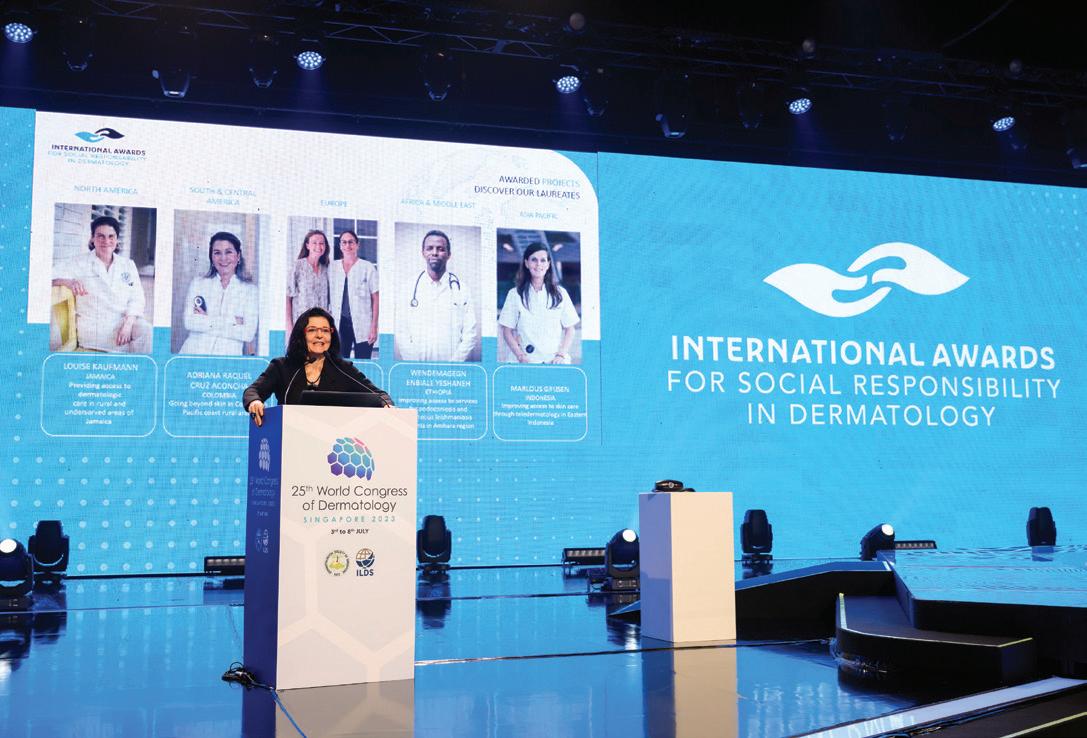
About L’Oréal
For over 110 years, L’Oréal, the world’s leading beauty player, has devoted itself to one thing only: fulfilling the beauty aspirations of consumers around the world. Our purpose, to create the beauty that moves the world, defines our approach to beauty as inclusive, ethical, generous and committed to social and environmental sustainability. With our broad portfolio of 36 international brands and ambitious sustainability commitments in our L’Oréal for the Future programme, we offer each and every person around the world the best in terms of quality, efficacy, safety, sincerity and responsibility, while celebrating beauty in its infinite plurality.
With 87,400 committed employees, a balanced geographical footprint and sales across all distribution networks (e-commerce, mass market, department stores, pharmacies, hair salons, branded and travel retail), in 2022 the Group
generated sales amounting to 38.26 billion euros. With 20 research centers across 11 countries around the world and a dedicated Research and Innovation team of over 4,000 scientists and 5,500 tech and digital professionals, L’Oréal is focused on inventing the future of beauty and becoming a Beauty Tech powerhouse.
About L’Oréal Thailand
L’Oréal Thailand is a subsidiary of the world’s leading beauty company, which imports and distributes international brands across four product divisions.

• Consumer Products Division: L’Oréal Paris, Garnier, and Maybelline New York
• L’Oréal Luxe: LANCÔME, Biotherm, Giorgio Armani, Kiehl’s, Shu Uemura, Yves Saint Laurent, and IT Cosmetics
• Professional Products Division: L’Oreal Professional and Kérastase
• Active Cosmetics Division: La Roche-Posay, Vichy, and CeraVe
More information: www.lorealthailand. com and www.facebook.com/lorealthailand
54 www.innolabmagazine.com
News info L’Oréal (Thailand)
- July 7, 2023
Your subscription
SUBSCRIPTION FORM
Fill out your detail or attach your business card
The swift code is SICOTHBK. Please send the pay-in slip via fax number
Subscription Date .................................................................................. Where did you find us? ................................................................................ Your name Your job title Your e-mail Your mobile number ....................................................................................... Company name Company address Country ......................................... Zip code ........................................ Website Tel no. ........................................... Fax no. .......................................... Name and address on receipt □ Same as above □ Other, please specify Your industry (please select your interest by inputting ü) □ Food/Beverage □ Supplements/Nutraceuticals □ Cosmetics □ Pharmaceuticals/Medicals □ Environment □ Energy □ Other, please specify ................................................................................ Your business (please select your interest by inputting ü) □ Manufacturer □ Distributor □ Certification body □ Laboratory service □ Academics □ Government body □ Consultancy □ Other, please specify .............................................. Your job function (please select your interest by inputting ü) □ Management □ Purchasing □ Sales/Marketing □ QC/QA □ QMR/Document Control □ R&D □ Chemist □ Microbiologist □ Production □ Consultant □ Other, please specify .............................................................................................. Your interest (please select your interest by inputting ü) □ Ingredients □ Additives □ Chemicals □ Reagents □ Methods □ Techniques □ Instruments □ Equipment □ Tools □ Softwares □ Lab Facilities □ Lab Design □ Laws/Regulations □ Standards □ Interview □ Industry/Market trend □ Other, please specify ..............................................................................................
engagement (please rank the score 1-5, 5 = most engaged) Enhancing work capability Seeking products & services Finding out industry movement
Joining INNOLAB’s activities, seminar and conferences _ Other, please specify .........................................................................................
Your
_
channel
_ E-mail _ Post mail _ Fax _ Facebook, www.facebook.com/innolabmagazine Other,
..............................................................................................
interest seminar topic
suggestion
Your preferred communication
(please rank the score 1-5, 5 = most convenient)
please specify
Your
Your
Domestic reader □ 1-year 900 THB Oversea reader □ 1-year 90 USD □ 2-year 1500 THB □ 2-year 170 USD
payment
MEDIA MATTER Co., Ltd., savings account number 1082280729, Siam Commercial Bank Pcl.
Please remit
to
+66 2878 1026 or innolab@media-matter.com
บริษัท มีเดีย แมทเทอร์ จำ า กัด 43/308 หมู่ 1 ถนนจอมทอง แขวงจอมทอง เขตจอมทอง กรุงเทพฯ 10150 MEDIA MATTER Co., Ltd. 43/308 Moo 1, Jomthong Road, Jomthong, Bangkok 10150 Thailand TaxID 0105552007301 Tel +66 875171651 International Call +66 945530616 Fax +662 045 5358 innolab@media-matter.com WWW.INNOLABMAGAZINE.COM
Where personal care ingredients and creators come together


•Source ingredients from 500+ suppliers
•Touch and try the latest innovations
•Meet R&D experts and perfect your formulation skills


•Learn about Asia Pacific’s future personal care trends

•Establish profitable business networks

• BITEC •
Bangkok
7-9 November 2023
THE LEADING EVENT IN ASIA PACIFIC FOR PERSONAL CARE INGREDIENTS Register to attend and find out more www.in-cosmetics.com/asia/im #incosasia




































































































